Cartier Watches
Below is our current in stock inventory of Cartier watches. If you have a Cartier watch you are interested in selling or trading please contact us.
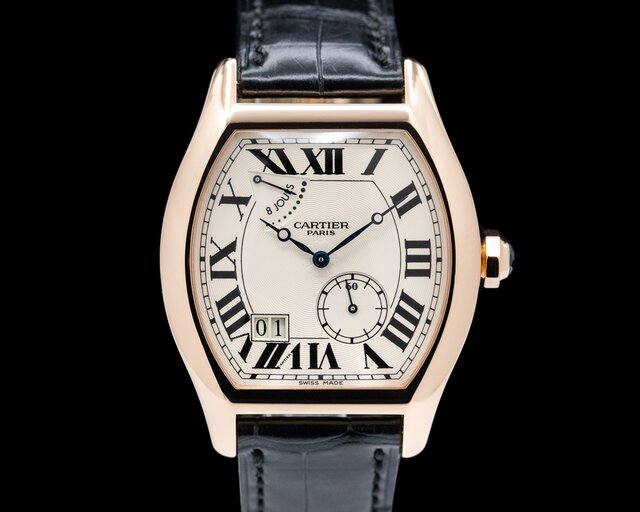
(51187) Cartier 2760 W1545851 Privee Collection Tortue 18k XL CPCP, 18k Rose gold on a strap with an 18k Rose gold deployant buckle, manual wind Cartier movement (9910MC), silver guilloche dial with black Roman numerals, steel blued hands, display back, size: 38 mm x 49mm, Thickness: 9.5mm, sapphire crystal, display-back, water resistant. Like New with Cartier box.
$17,900
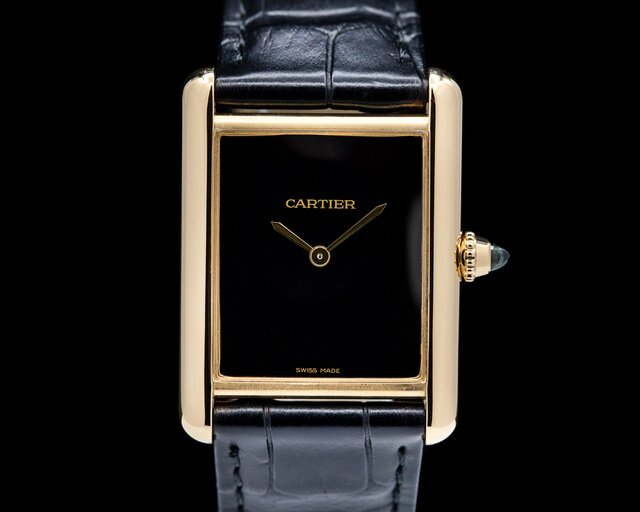
(51380) Cartier WGTA0091 Tank Louis Cartier, the Tank Louis Cartier was the model worn by Louis Cartier himself and is the standard for all Tank models by Cartier, 18k yellow gold on a strap with an 18k tang buckle, manual wind caliber 8971 MC movement, sapphire cabochon, black dial, water resistant, size: 33.7mm x 25.5mm (including lugs), thickness: 6.6mm. Like New with Cartier box and undated papers.
$10,700
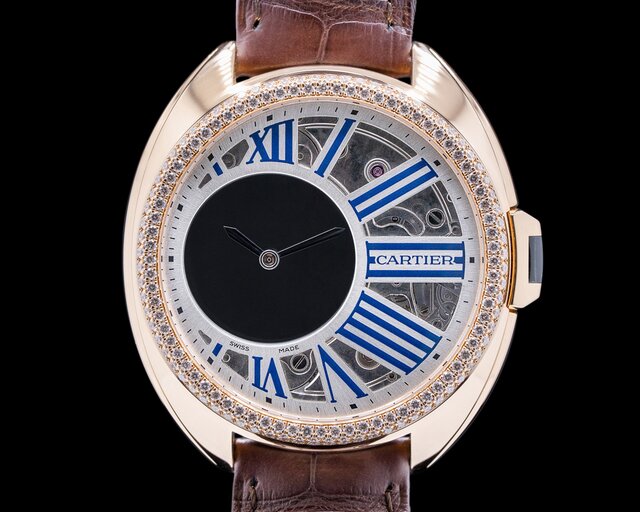
(48492) Cartier HPI00945 Cle De Cartier Mystery, 18k rose gold case set with 152 brillaint cut diamonds on a strap with an 18k rose gold deployant buckle with 43 brilliant cut diamonds, automatic Cartier caliber 9981 MC movement with mysterious hour and minute display, silver openworked dial with blue roman numeral hour markers, sapphire crystal, display back, sapphire set into the key inspired crown, water resistant, size: 41mm, t...
$25,300
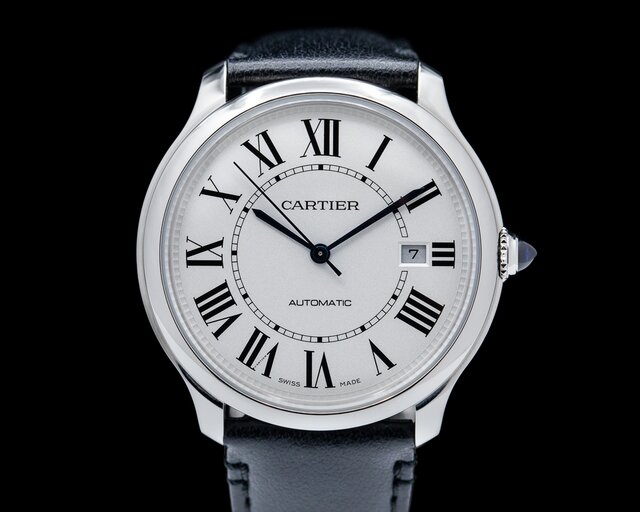
(52994) Cartier Ronde Croisiere de Cartier WSRN0032, stainless steel on an strap with a matching stainless steel tang buckle, automatic winding, caliber 1847 MC, sandblasted silver dial with black painted Roman numeral hour markers, blued steel handset, sapphire crystal, water resistant to 30 meters, size: 40mm, thickness: 9.9mm. Unworn with Cartier box and papers dated 2022.
$3,950
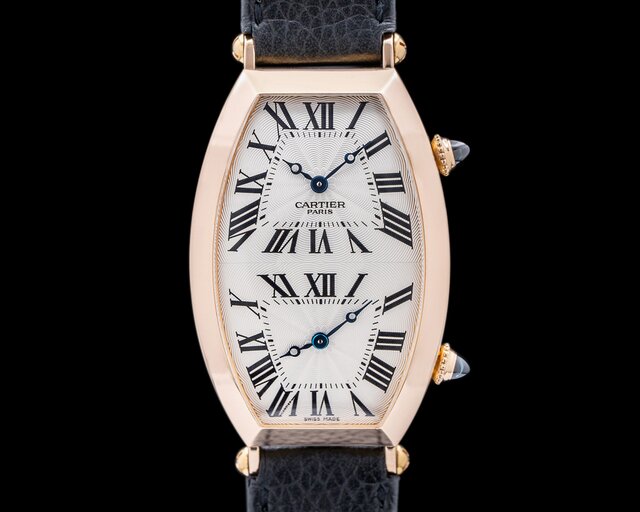
(53122) Cartier 2805 Tonneau XL Dual Time Collection Privee Cartier Paris CPCP, limited edition and very rare, 18k rose gold gold large tonneau curved case on a strap with an 18K rose gold deployant, powered by two individual manual wind Cartier caliber 9770MC movements, silver double dial design featuring the iconic stylized Roman numerals and blued steel hands, each dial featuring the Collection Privee guilloche emanating out of ...
$24,500

(51617) Cartier Santos Ladies WGSA0022, 18K rose gold on a leather strap with 18k tang buckle, quartz movement, blued steel handset,, sapphire crystal, water resistant to 100 meters, size: 35.1mm, thickness: 8.83mm. Unworn with Cartier box and papers from 2022.
$8,700
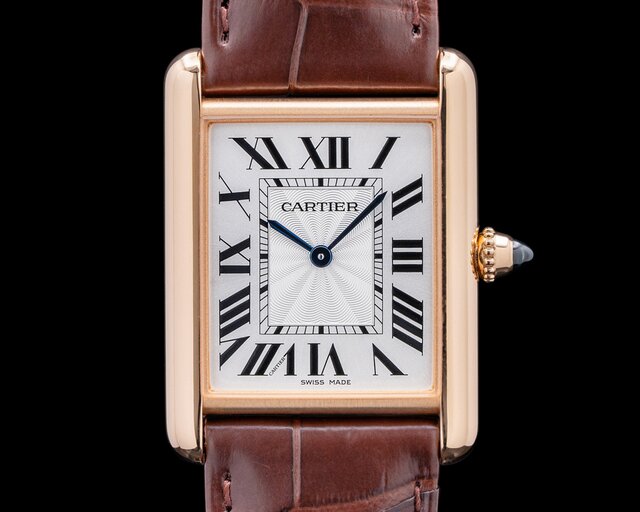
(53139) Cartier WGTA0011 Tank Louis Cartier 100th Anniversary Tank, WGTA0011, the Louis tank Cartier was the model worn by Louis Cartier himself and is the standard for all Tank models by Cartier, 18k rose gold on a strap with an 18k tang buckle, manual wind caliber 8971MC movement, sapphire crown, white dial with black Roman numerals and blued steel hands, water resistant, size: 33.7mm x 25.5mm (including lugs), thickness: 6.6mm. ...
$11,900
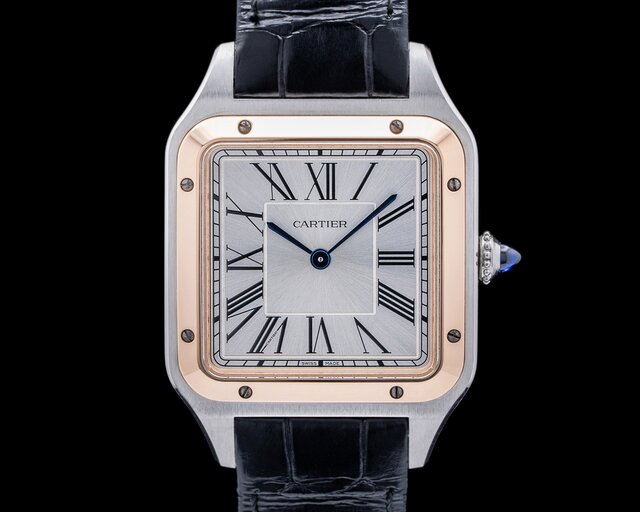
(53137) Cartier Santos Dumont W2SA0011, stainless steel and rose gold on an alligator strap with a matching stainless steel tang buckle, Quartz movement, silver dial with black painted Roman numeral hour markers, blued steel handset, sapphire crystal, water resistant to 30 meters, size: 31.6mm x 43.5mm, thickness: 7.5mm. Like new condition with Cartier. This watch was purchased in 2023.
$4,950
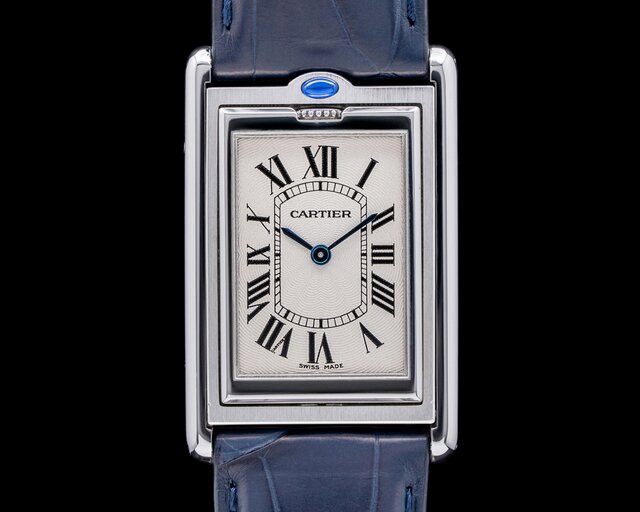
(53132) Cartier 2390 Tank Basculante Mecanique, very rare reference and believed to have only been sold only in the Paris Boutique, stainless steel case (with a cabriolet pivot system) on a strap with a stainless steel tang buckle, crown and cabochon at 12 o'clock, silver guilloche dial with black printed Roman numerals and blued steel hands, manual wind Cartier caliber 060MC movement, size: 25.5mm x 38.5mm (including lugs), thickn...
$8,750
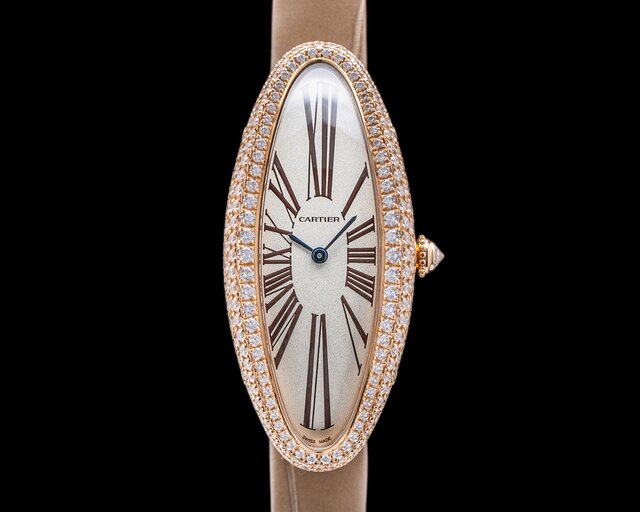
(52971) Cartier Baignoire Allongee WJBA0006, 18k rose gold elongated oval style case brilliant-cut diamonond on a taupe alligator strap with rose gold Cartier deployant buckle, manual wind movement caliber 1917 MC, blued steel hands, ivory guilloche dial with stylized painted black roman numerals, crown set with iconic sapphire, sapphire crystal, solid back, water resistant, size 47mm x 21mm. Like New with Cartier box, booklets, an...
$32,500
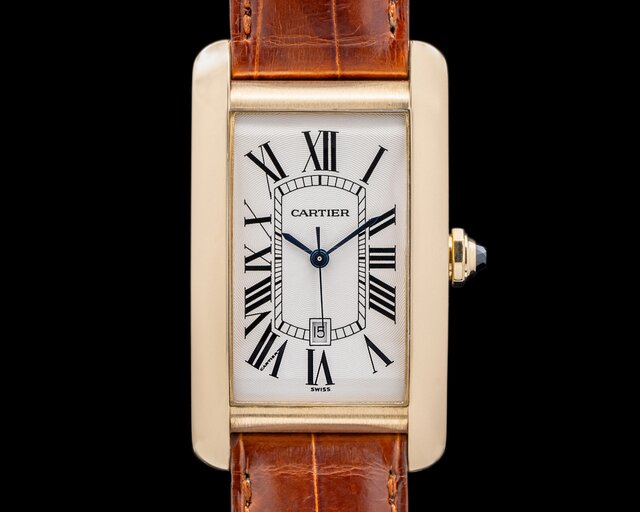
(52959) Cartier Tank Americaine Large Size W2603156, 18k yellow gold tank style case on a yellow gold Cartier tang buckle, light brown alligator strap, automatic movement, date at 6 o'clock, center sweep seconds, ivory dial with painted black roman numerals, crown set with iconic sapphire, sapphire crystal, solid back, water resistant, size 45mm x 26.5mm. Like New with Cartier service pouch.
$8,250
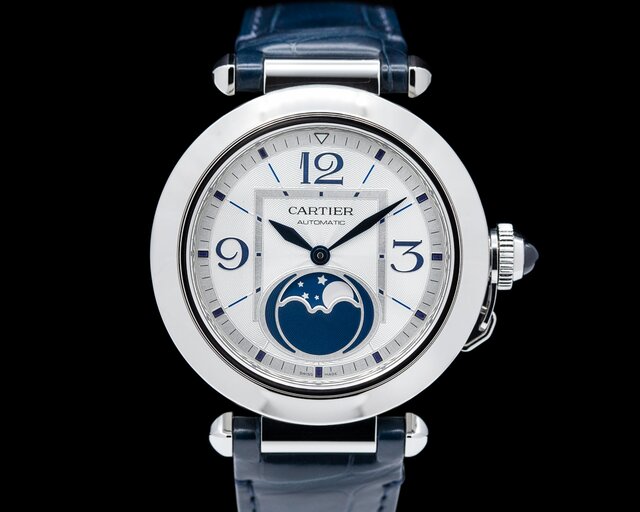
(51475) Cartier Pasha de Cartier Moon Phases WSPA0030, stainless steel on a strap with a matching steel deployant buckle, automatic movement, stainless steel screw-down crown cover set with sapphire cabochon, silvered guilloche dial with blue Arabic numerals, blued-steel diamond-shaped hands and a moonphase complication at 6 o'clock, diameter: 41mm, thickness: 8mm, sapphire crystal, water resistant to 100 meters. Like New with Cart...
$8,500
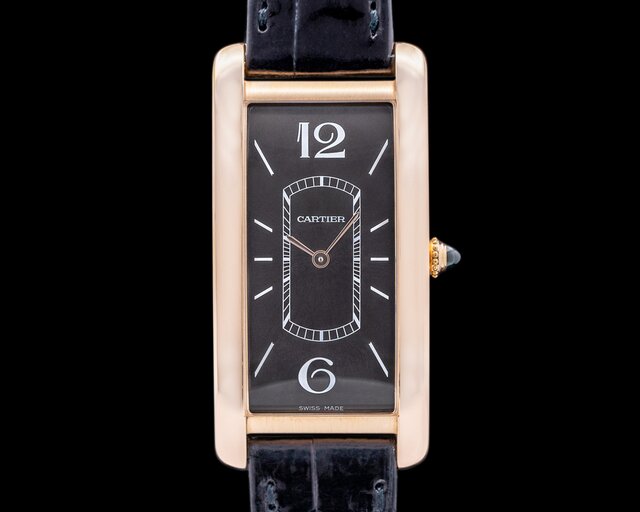
(51994) Cartier Tank Cintree Rose Gold WGTA0025 large, rectangular curved case with a Rose Gold tang buckle, vintage inspired black dial design, baton hour indices with Arabic numerals at 6 and 12 o'clock, sword hands, cabochon ruby-set winding-crown, manual wind Caliber 8971 MC movement, size 23 x 46.3mm, thickness 7.2mm. Like New with original Cartier box, booklets and warranty dated 2022.
$23,100
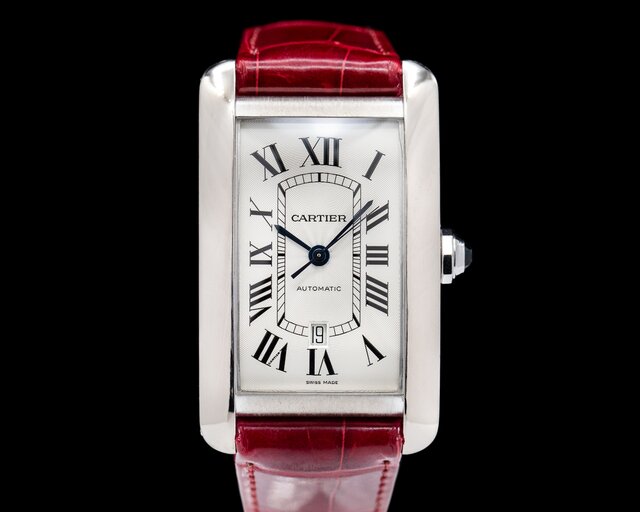
(48825) Cartier Tank Americaine XL 2928, 18k white gold case on a strap with an 18k white gold deployany buckle, automatic movement, blued steel handss, center seconds, silver guilloche dial with painted roman numeral hour markers, date at 6 o'clock, crown set with iconic sapphire, display back, water resistant. Size: 52mm x 32mm, Thickness: 9.8mm. Excellent Condition with Cartier box and papers dated 2008.
$12,800

(52877) Cartier Tank Cintree Skeleton WHTA0008 Limited to 100 pieces, 18k gold case on an alligator strap with an 18k rose gold gold folding buckle, manual wind Cartier Caliber 9917 MC, 60 hour power reserve, skeletonized movement, sapphire crystal, sapphire cabachon, size 23mm x 46.5mm, thickness 8mm, Like New with Original Cartier limited edition Box, additional strap, booklets, and Papers from 2023.
$57,500
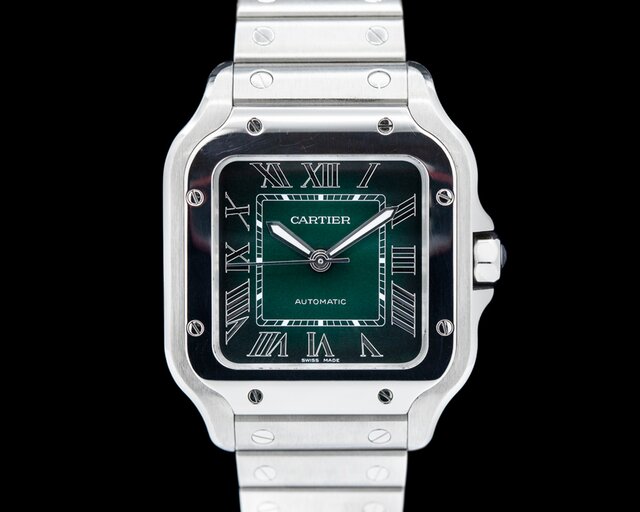
(52317) Cartier Santos Green Dial Medium WSSA0061, stainless steel on a stainless steel bracelet with double fold-over Cartier buckle. Bracelet and straps use the easy change "SmartLink" system, automatic 1847MC movement, luminous steel handset, centered sweep seconds hand, sapphire crystal, water resistant to 100m, size: 35.1mm, thickness: 8.83mm. Like New with Cartier box, additional green OEM leather strap with SS deployant clas...
$6,500

(48020) Cartier Tank a Vis Collection Privee Platinum CPCP, W1539951P, platinum case on a strap with an 18K white gold deployant buckle, manual wind Cartier 437MC movement, silver guilloche dial with black Roman numerals and blued steel hands, size: 27mm x 31mm, thickness: 7.5 mm, water resistant. Like New with European Watch Co travel pouch.
$22,200
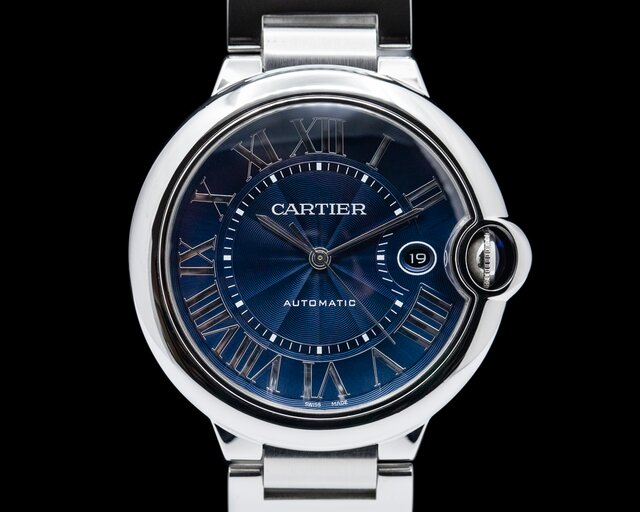
(50743) Cartier WSBB0025 Ballon Bleu 40mm, stainless steel on a stainless steel bracelet, automatic movement, blue sunray dial with roman numerals and silver steel hands, centered sweep second hand, date, fluted crown set with synthetic cabochon-shaped spinel, sapphire crystal, water resistant to 30 meters, diameter: 42mm, thickness: 14mm. Like New with Cartier box, additional alligator strap and stainless steel deployant clasp, an...
$5,400
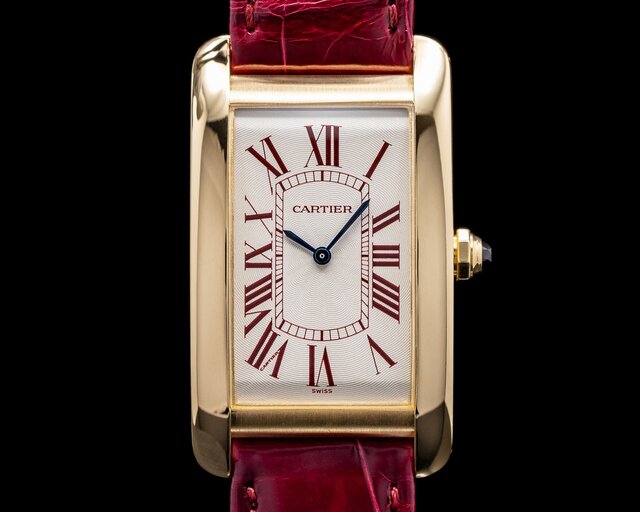
(38064) Cartier W2606356 Tank Americaine LM Limited Edition for Italy 1735, 18k yellow gold tank style case on a strap with a matching 18k yellow gold Cartier tang buckle, manual wind cartier caliber 430MC movement, ivory guilloche dial with painted burgundy roman numeral hour markers, blued hands, crown set with iconic sapphire, sapphire crystal, solid back, water resistant, size 45mm x 26.5mm, Like New with Cartier service pouch ...
$22,500

(51200) Cartier W6920074 Ballon Bleu Chronograph, rose gold on a strap with a rose gold deployant buckle, automatic movement, silver Opaline dial with Roman numerals and blued steel hands, chronograph, centered sweep second hand, date at 9 O'Clock, fluted crown set with synthetic cabochon-shaped spinel, sapphire crystal, water resistant to 30 Meters, Diameter: 44 mm, Thickness: 15 mm. Like new with Cartier box and undated papers. ...
$15,900
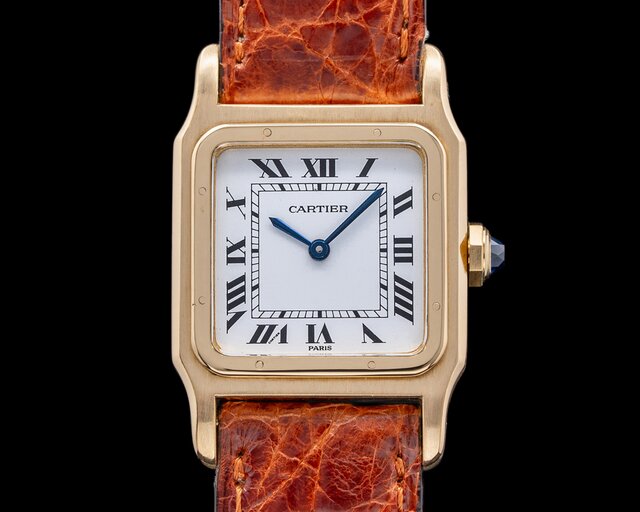
(52479) Cartier Santos Dumont 7809, 18K yellow gold on a strap with a yellow gold tang buckle, mechanical manual wind movement, black Roman numerals, blued steel hands, sapphire crystal, water resistant, diameter: 35mm x 25mm, thickness: 4.1mm. Excellent condition.
$9,400
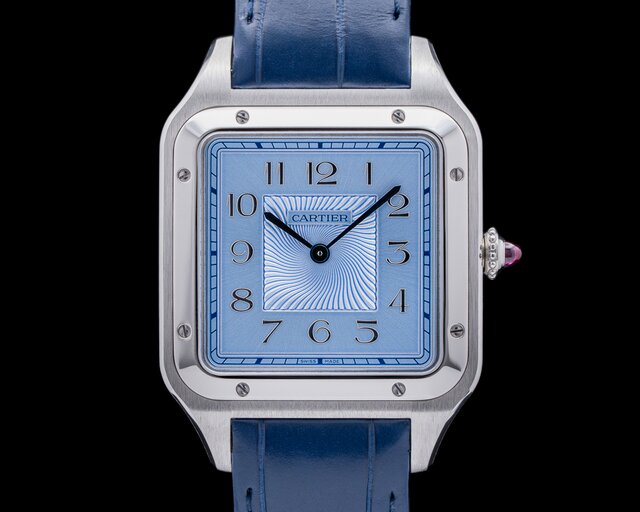
(52274) Cartier WGSA0050 Santos-Dumont "Precious Set" Limited Edition, released in 2020 and limited to 100 pieces, 950 platinum on a strap with a matching 950 platinum tang buckle, manual wind Cartier caliber 430 MC movement, ice blue dial with guilloche center, polished Arabic hour markers, and blued-steel sword shaped hands, ruby cabochon set into the crown, size: 33.9mm x 46.6mm, thickness: 7.5mm, sapphire crystal, water resista...
$32,000
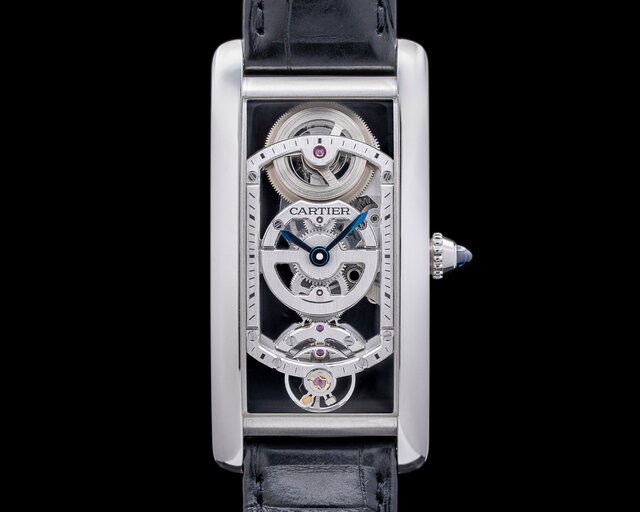
(52775) Cartier Tank Cintree Skeleton WHTA0009, Limited to 100 pieces, platinum case on an alligator strap with a white gold folding buckle, manual wind Cartier Caliber 9917 MC, 60 hour power reserve, skeletonized movement, sapphire crystal, sapphire cabachon, size 23mm x 46.5mm, thickness 8mm. Unworn with Original Cartier limited edition Box and Papers from 2017.
$69,000
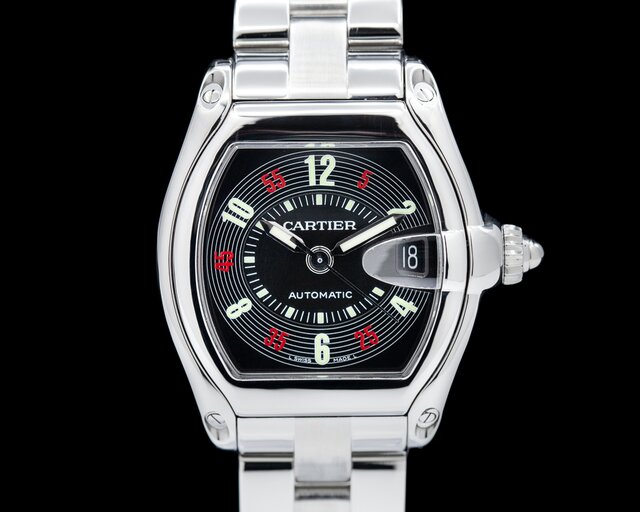
(52138) Cartier W62002V3 Roadster Vegas dial, stainless steel on a stainless steel bracelet, automatic, date, size: 37mm x44mm, thickness: 12mm, luminous hands and Arabic numerals, sapphire crystal, water resistant to 330ft. Like New with Cartier box and instructions.
$3,100
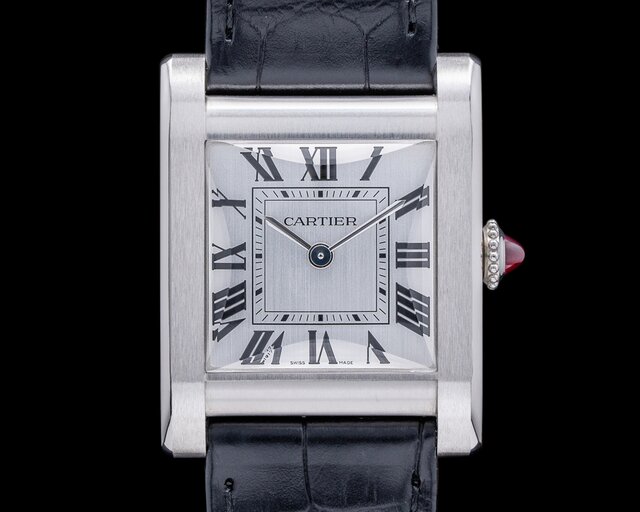
(52760) Cartier WGTA0109 Privee Collection Tank Normale, Released in 2023 and limited to only 200 pieces worldwide, based on a design first launched in 1922, platinum on an alligator strap with a matching platinum tang buckle, manual-winding Cartier caliber 070, satin finished gray dial with black Roman numeral hour markers, ruby cabochon on the crown, sapphire crystal, water resistant to 30 meters, size: 32.6mm x 25.7mm (including...
$38,500
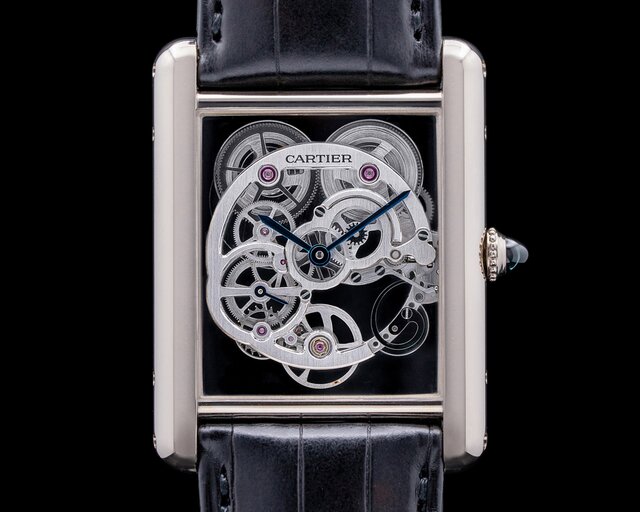
(52774) Cartier W5310012 Tank Louis Cartier Skeleton Sapphire, 18K white gold on an alligator strap with 18K white gold folding deployant buckle, manual wind caliber 9616 MC movement, skeletonized dial with sword shaped blued steel hands, running seconds register at 8 o'clock, sapphire cabochon crown, sapphire crystal and display caseback, size: 30mm x 39mm (including lugs), thickness: 7.6mm, water resistant to 30m. Unworn with Car...
$39,900
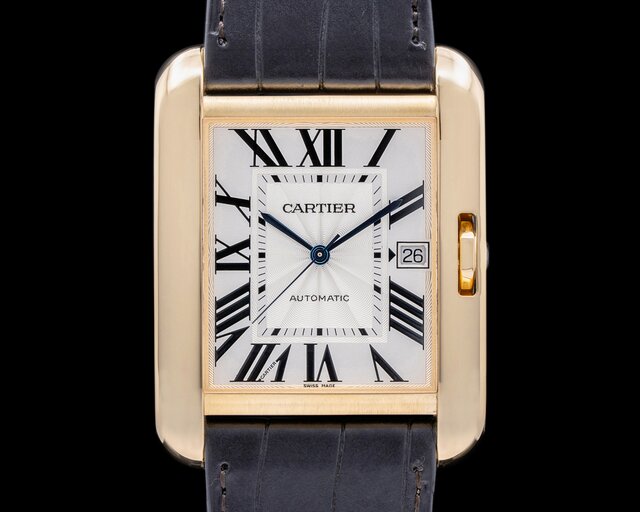
(51834) Cartier W5310032 Tank Anglaise Large, 18K yellow gold with a yellow gold deployant buckle, automatic Cartier caliber 1904MC, silver flinque dial with black Roman numerals and blued steel hands, date window at 3 o'clock, crown is integrated into the right side of the case, sapphire crystal, display back, size: 36mm x 47mm, thickness: 9.8mm. Like New with Cartier travel pouch and papers.
$15,900
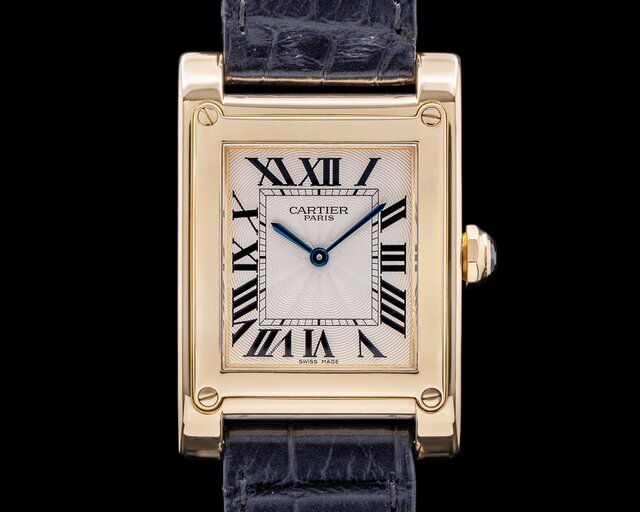
(52746) Cartier Tank a Vis Collection Privee Cartier Paris (CPCP), W1529451, 18k yellow gold on a strap with an 18K yellow gold deployant buckle, manual wind movement (Cartier 437MC), silver guilloche dial with black Roman numerals and blued steel hands, size: 27mm x 30mm, thickness: 7.5mm, water resistant. Like New.
$14,900
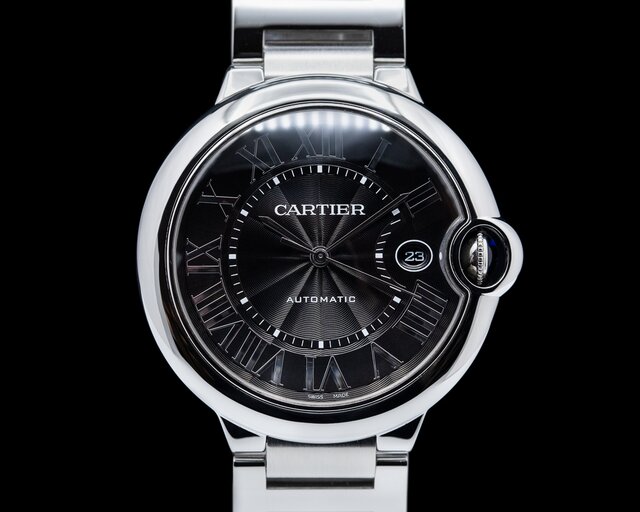
(50624) Cartier W6920042 Ballon Bleu 42mm, Stainless Steel on a Stainless Steel Bracelet, automatic movement, black sunray dial with roman numerals and silver steel hands, centered sweep second hand, date, fluted crown set with synthetic cabochon-shaped spinel, sapphire crystal, water resistant to 30 meters, diameter: 42mm, thickness: 13mm. Like New with Cartier box and papers dated 2015.
$5,500

Cartier Privee Collection Tortue XL 18K CPCP 8 Day
$17,900

Cartier Tank Louis Black Dial 18K Yellow Gold
$10,700

Cartier Cle de Cartier Mystery Openworked Dial Diamond Bezel 41MM
$25,300

Cartier Cartier Ronde Croisiere de Cartier UNWORN
$3,950

Cartier Tonneau XL 2805 Dual Time COLLECTION PRIVEE CPCP Rose Gold
$24,500

Cartier Santos Ladies 18K Rose Gold UNWORN
$8,700

Cartier Tank Louis 100th Anniversary 18K Rose Gold
$11,900

Cartier Santos Dumont Steel/Rose Gold Quartz
$4,950

Cartier Tank Basculante Mecanique SS
$8,750

Cartier Baignoire Allongee Diamonds
$32,500

Cartier Tank Americaine Large Mens 18K Yellow Gold
$8,250

Cartier Pasha de Cartier Moon Phases 41MM SS
$8,500

Cartier Tank Cintree WGTA0025 Rose Gold / Black Dial
$23,100

Cartier Tank Americaine XL 2928 18k White Gold
$12,800

Cartier Tank Cintree WHTA0008 Skeleton 18k Rose Gold LIMITED RARE
$57,500

Cartier Santos Green Dial Medium SS Automatic
$6,500

Cartier Privee Collection Tank a Vis CPCP W1539951 Platinum RARE
$22,200

Cartier Ballon Bleu Automatic 42MM SS / SS
$5,400

Cartier Tank Americaine LM Limited Edition for Italy RARE
$22,500

Cartier Ballon Bleu Chronograph Rose Gold SERVICED
$15,900

Cartier Santos 18K Yellow Gold Manual Wind
$9,400

Cartier Santos-Dumont Precious Set Limited Platinum / Matching Cuff Links
$32,000

Cartier Tank Cintree Skeleton Platinum LIMITED UNWORN
$69,000

Cartier Roadster Vegas Dial SS/SS
$3,100

Cartier Privee Collection Tank Normale WGTA0109 Platinum
$38,500

Cartier Tank Louis Cartier Skeleton Sapphire 18K White Gold RARE UNWORN
$39,900

Cartier Tank Anglaise Large 18K Yellow Gold Automatic
$15,900

Cartier Tank a Vis CPCP 18K YG
$14,900

Cartier Ballon Bleu Automatic 42MM SS / SS
$5,500
Guide to Cartier Watches
Cartier is currently owned by the Swiss Richemont Group. After its founding in 1874 and decades of success under the control of the Cartier family, the brand found itself struggling and on the edge of bankruptcy. In 1964, the Cartier affiliates in London, New York, and Paris were sold to various investors by the great-grandchildren of founder Louis Cartier. Eventually, after years of consolidation, a group of French investors called the Monde Group managed to purchase all three affiliates and reunited the three separate houses. In 1993, the Monde Group merged with several other luxury brands, ultimately forming the base for what we now know today as the Swiss Richemont Group.
Cartier produces between 450,000 and 500,000 watches each year. The company ranks third in terms of total market share, behind Rolex and Omega, with 6.7 percent of the total market.
During the late 1970’s, Cartier introduced a line of affordable watches and jewelry known as “Must De Cartier”. Utilizing gold-plated sterling silver cases, simple dials, and basic manual wind movements, Cartier was able to significantly reduce manufacturing costs. The affordable price points made the Must de Cartier line an overnight success, but after a time, the value focused sub-brand began to de-value the overall image of the Cartier brand. In an effort to revitalize its luxury prestige, they began working on a project known as the Collection Priveé Cartier Paris, in short, “CPCP”. It was a collection of exceptional, and limited quantity precious metal watches produced by the Maison de Paris from 1998 to 2008. These watches were a callback to the bespoke luxury that Cartier built its long standing reputation on in the early 20th century. Watchmakers from various respected brands were contracted to make calibers for the CPCP. These movements were then finished to a high degree and cased in “classic” Cartier designs strictly in precious metal. At just 100-150 pieces per run, the CPCP Cartier watches have become highly collectible.
The Cartier Tank first appeared in 1917 when Louis Cartier presented a timepiece to John J. Pershing, commander of the American Expeditionary Forces in World War I. The Renault FT-17 infantry tank used in the First World War was the inspiration for Louis' wristwatch. A rectangular dial wedged between lugs that extend beyond the dial to receive a leather band, there is an immediate link when comparing this to the shape of the FT-17. The Cartier tank is a classic design that has stood the test of time and is the most popular model from the company.
Cartier was founded by Louis Francois Cartier in Paris in 1847. Passed on to Louis’ son Alfred in 1874, and then to Alfred’s sons Louis, Pierre and Jacques after that, it was the third generation of Cartier’s who were responsible for globalizing the brand. Following Pierre's death in 1964, the Cartier affiliates in London, New York, and Paris were sold to various investors. The company went through a series of ownership groups and investors and is now a part of the Richemont Group.
History of Cartier Watches

King of Jewelers, Jeweler of Kings
When measuring the impact of high-fashion and design in the world of horology, Cartier stands head and shoulders above every other watchmaker. Historically, Cartier created jewelry for maharajahs and tsars, and the company built a reputation for their craftsmanship, design, and ongoing technological innovations.
Jeweler and watchmaker Louis-Francois Cartier founded the company that bears his name in 1847 when he took over the Paris workshop of his mentor, master-craftsman Adolphe Picard. Born in 1819 to a working-class Parisian family, Cartier’s father made gunpowder and his mother worked as a laundress. His father believed in the importance of education and urged Louis-Francois to remain curious and to continue to learn throughout his life. In keeping with the European tradition of apprenticeship, as a young man he worked for the renowned goldsmith Adolphe Picard.
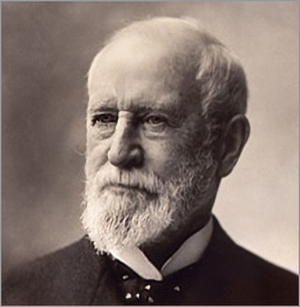
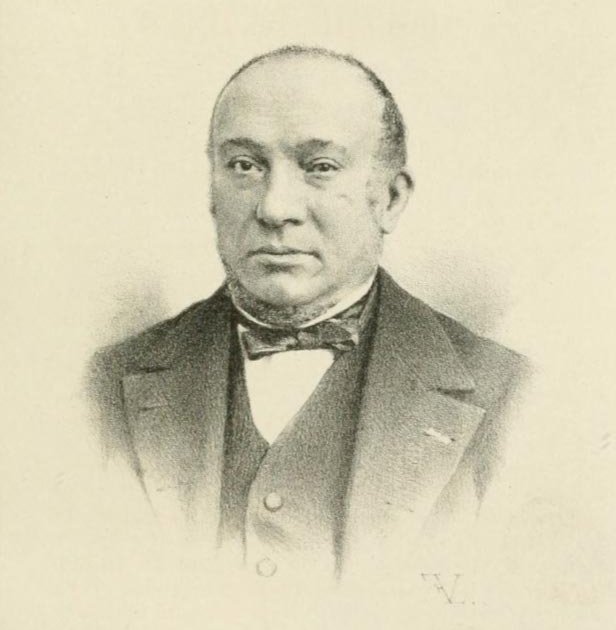
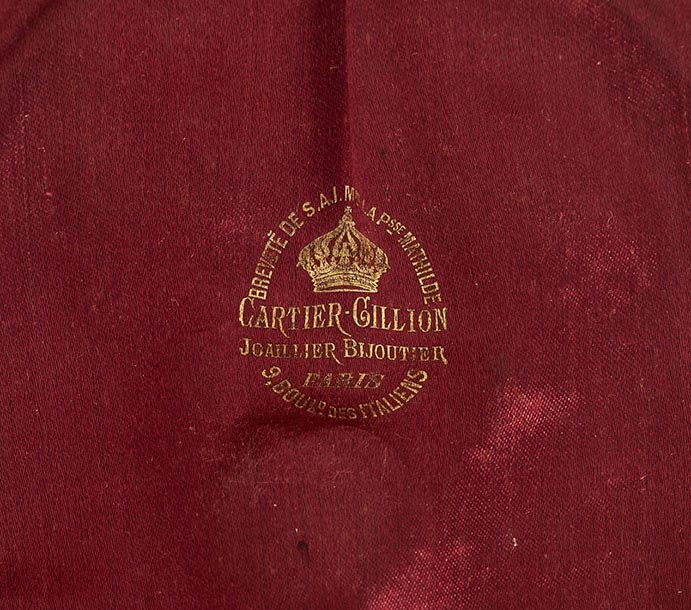
When Louis-Francois took over the Picard firm, he already had two children and a practiced passion for education and learning. In 1859, with his own firm established and flourishing, he purchased a well-known jewelry company called Gillion. The new endeavor was initially known as Cartier Gillion, with the additional name ultimately being dropped leaving us with the Cartier brand we know today. The Cartier family retained ownership of the firm until 1964, establishing it as the premier international jeweler.
Cartier innovated as both a watchmaker and a jeweler. He brought a new level of security to the jewelry industry by introducing the practice of stamping all pieces produced in his workshop with an individual serial number.
Just as an artist would sign a painting, he believed that each piece from his workshop should bear an identifying signature as well. The practice was soon adopted by other jewelry makers and designers around the world.
Like other watch sellers of the time, Cartier maintained excellent relationships with the wealthy, the aristocracy, and royalty by leveraging his poise and position. Alongside his central watchmaking business, his phenomenal ability to represent an array of fashion, jewelry, and beautifully-crafted novelties ensured his continued success.
Just a few weeks after opening a new shop on a fashionable Parisian street near the Palais Royal in 1853, a French countess purchased three brooches and went on to show them to Napoleon Bonaparte III's wife, the Empress Eugenie. Soon after, in 1856, Cartier received an endorsement from Princess Mathilde, the niece of Napoleon I and Napoleon III's cousin, who purchased a collection of jewelry from Cartier. Word of the royal purchase spread so quickly that there were times when Cartier was hard-pressed for inventory, selling more than 150 pieces of jewelry that are now considered to be masterworks. Despite the high demand, the talented watchmaker and his thriving business were ready for the challenge.
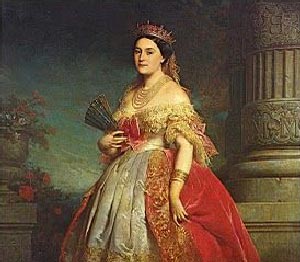
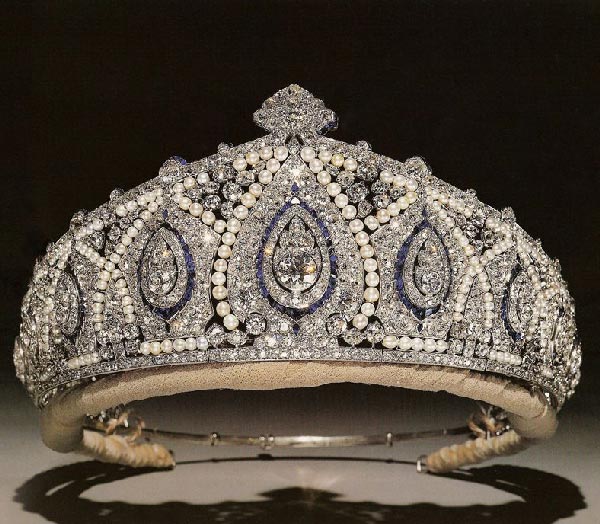
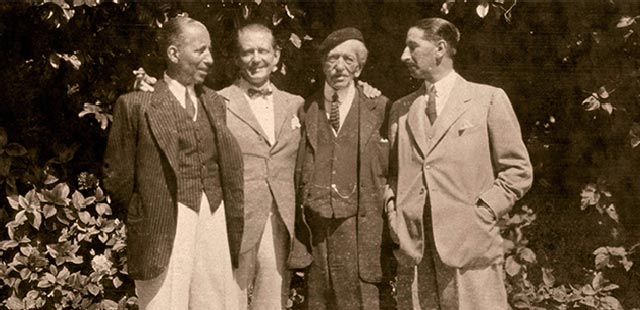
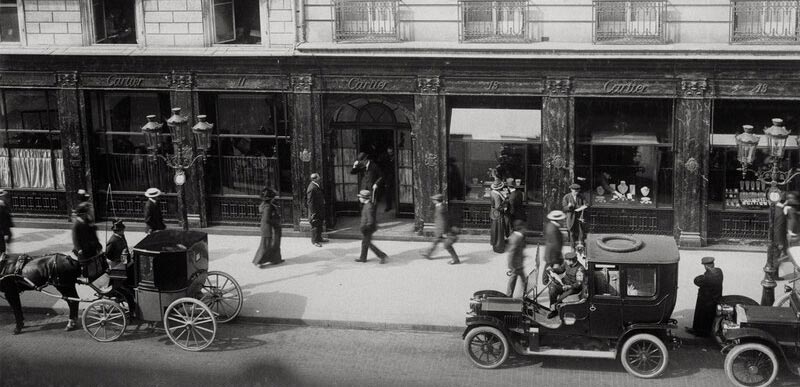
By 1899, Cartier was a well-established international name, and control of the company was handed to Louis-Francois’ three grandsons Louis, Pierre, and Jacques. With the help of their father Alfred, the brothers moved to a new location on the Rue de la Paix where the brand still maintains a boutique to this day. The Cartier presence enticed other merchants to move to the area, and it quickly became the Parisian center for haute couture fashion houses and jewelry craftsmen. It was said that Cartier changed the entire arrondissement, setting a tone of dazzling opulence and luxury.
In 1900, Cartier held a special exhibition of diamond jewelry mounted in platinum, showcasing eighteenth-century Neoclassical designs.
The show appealed to wealthy buyers and royalty from around the world. In 1902, Alfred's second son Pierre Cartier (1878-1964), branched out and opened a Cartier boutique at 4 New Burlington Street in London. The grand opening of the new location coincided with the coronation of King Edward VI, which pleased the new monarch very much. His family "adopted" Cartier, and in 1904, they were issued the first royal warrant as the official jeweler to the King of England. Eventually, control of the London boutique passed to the youngest Cartier brother Jacques (1884-1942).
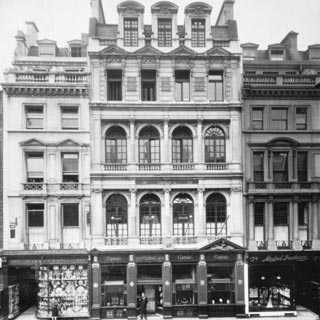
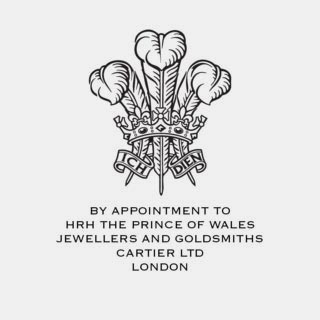
Louis-Francois passed away at the age of 85 in 1904 at a time when his company was entering a new phase of success.
That same year, the Cartier brothers visited Russia and were inspired to create their a-la Russe collection which referenced Russian national motifs. Czar Nicholas II ordered several treasures from the collection, helping to prove that Cartier was still the gold standard of their industry even without its patriarch at the helm. These were considered the "golden years" of Cartier (1904-1920) and were full of iconic sales such as the jewel-studded "Tutti Frutti" bracelets and necklace for the Maharaja of Patiala, the “Big Cat" jewels for the Duchess of Windsor, and the majestically ornate Belle Epoque garland necklace in platinum for King Edward VII.
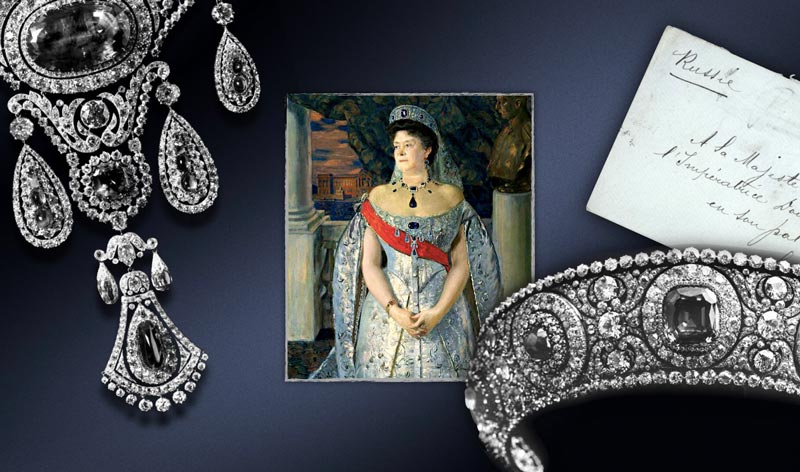
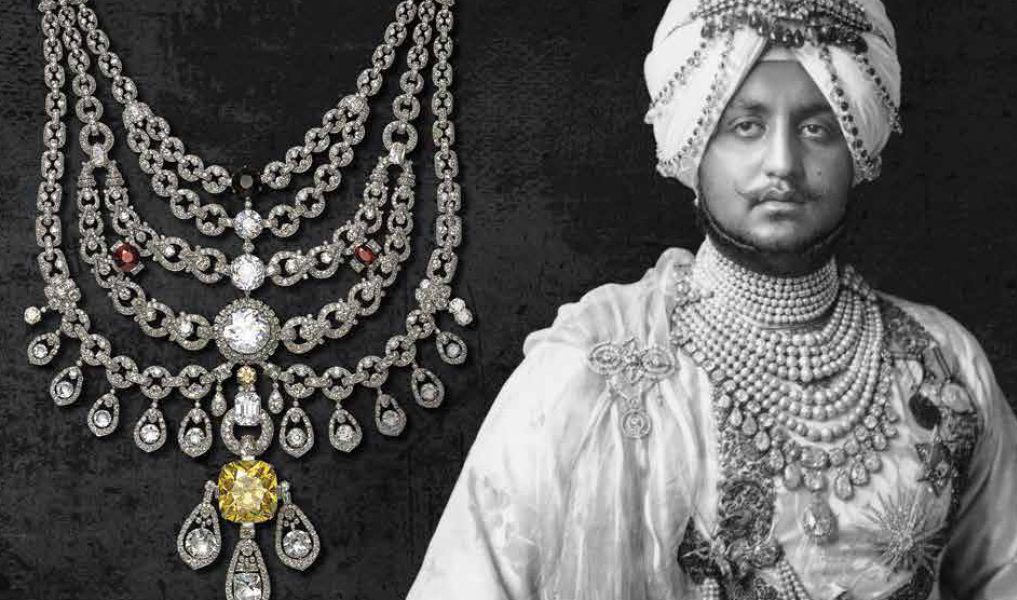
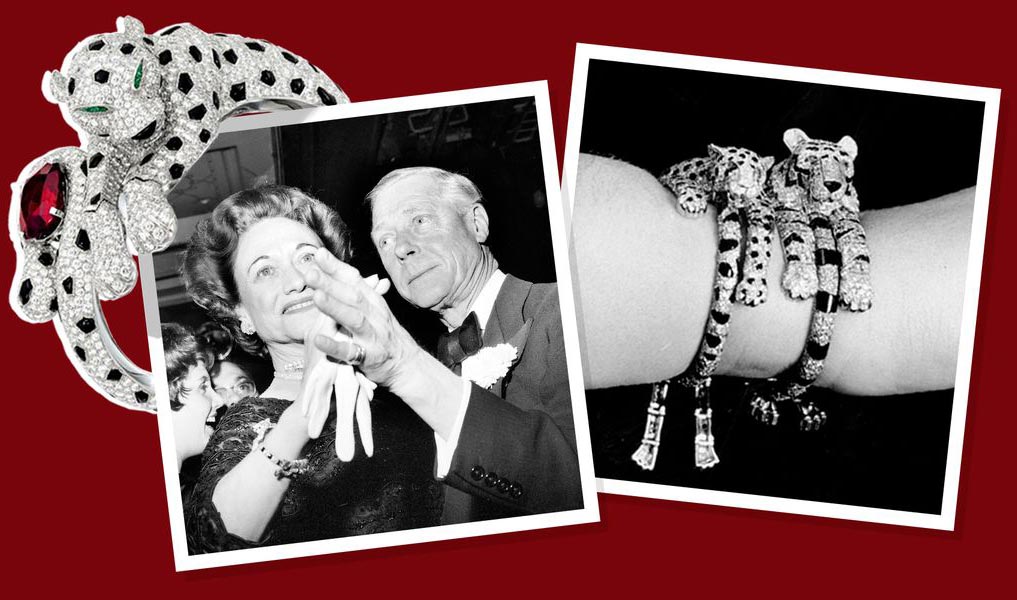
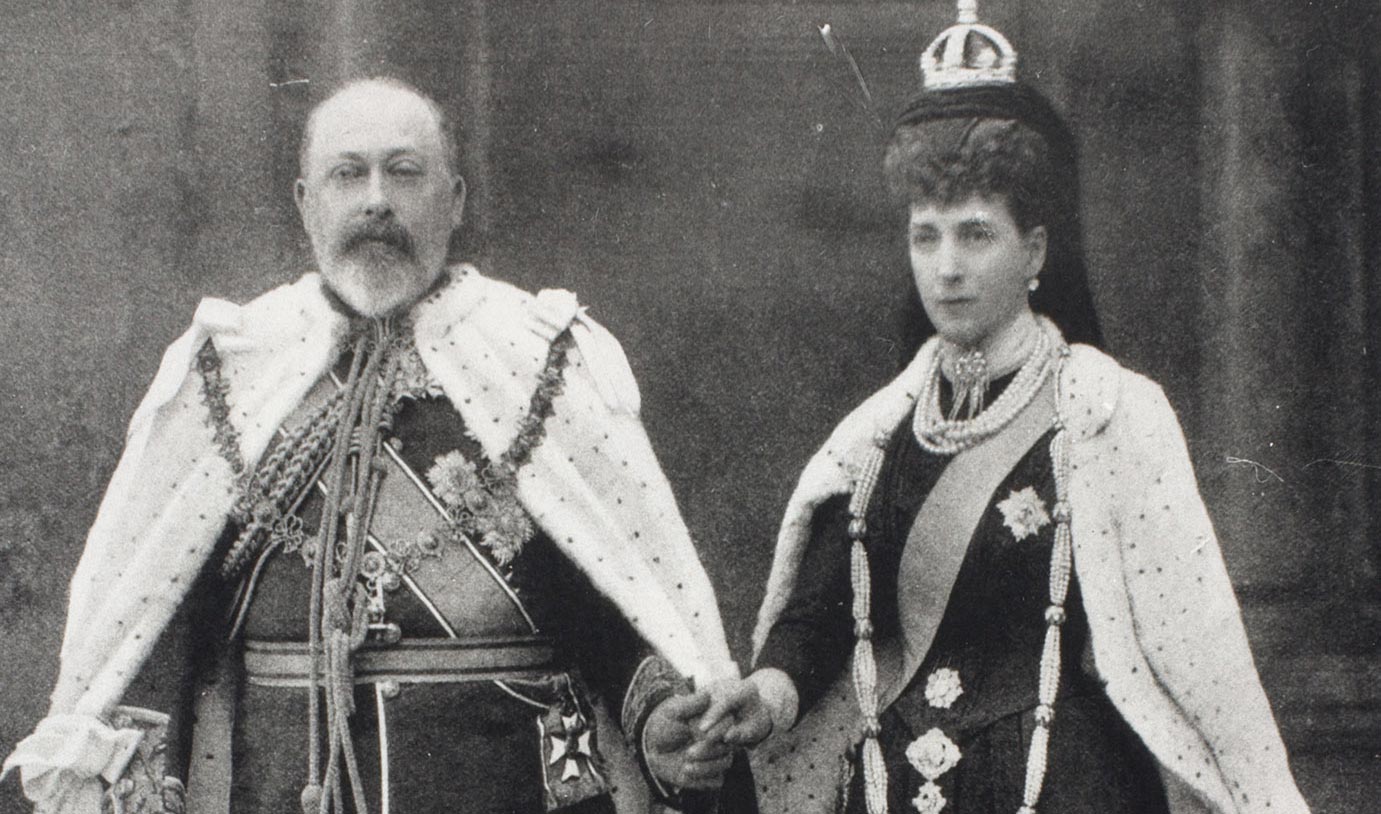
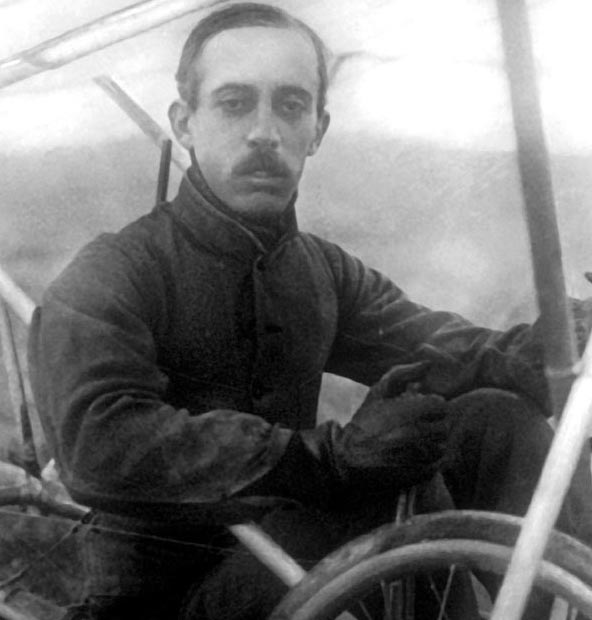
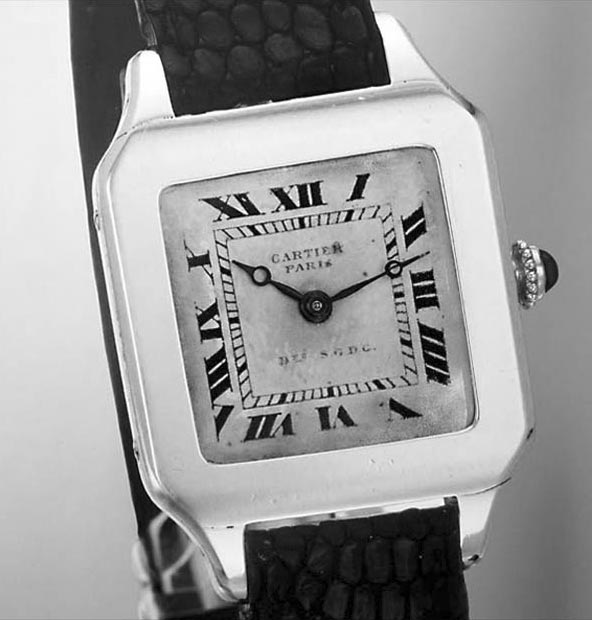
Responsible for the Paris branch of the company, Louis Cartier was a creative mind and an inventor who carried on his grandfather’s legacy of innovation. In 1904, he developed a prototype for his friend, the pioneering Brazilian aviator Alberto Santos-Dumont. Santos-Dumont had complained of the unreliability and impracticality of using pocket watches while flying. Worn during every flight and seen on his wrist in countless newspaper photographs, the revolutionary new “wristwatch” quickly gained popularity.
Patek Philippe first popularized the idea for a small, comfortable pocket watch on a leather strap secured by a pin buckle, but their watch was designed for women. The Cartier creation was the first watch of this style made specifically for men. It was flat with a square bezel and dubbed the "Santos".
In 1907, Louis Cartier initiated a partnership with Edmond Jaeger of the noted watch brand Jaeger-LeCoultre, making Jaeger the exclusive supplier of watch movements for Cartier.
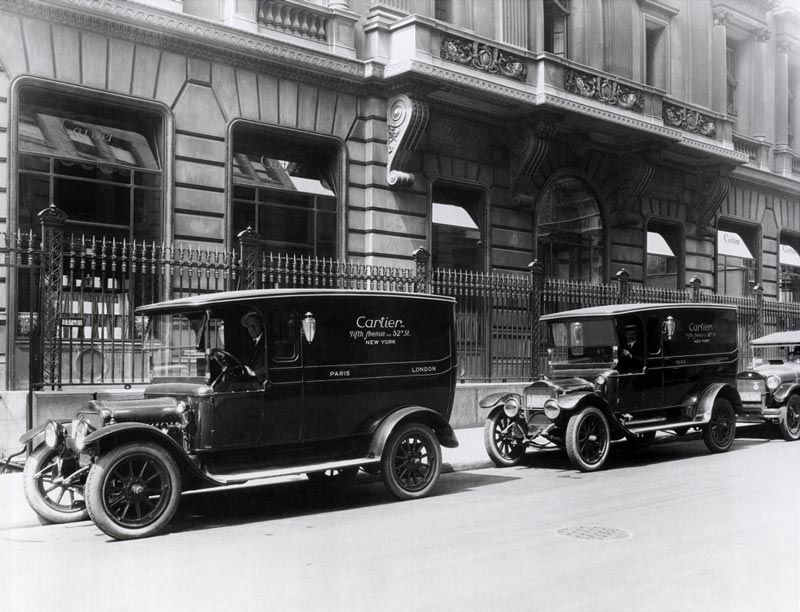
With the brand gaining momentum and international popularity, the family opened a string of new boutiques, beginning with one in St. Petersburg, Russia. In 1909, Pierre Cartier went to the United States to open the renowned boutique at 712 Fifth Avenue in Manhattan, while Louis remained in Paris to manage the boutique there which formed the geographical center for the company. Finally, a new London boutique was opened at 175-176 New Bond Street.
In 1910, Pierre Cartier made headlines around the world when he sold the famed 45.52 carat Hope Diamond after purchasing it from C.H. Rosenau. It was offered at the Cartier Maison in Paris to Washington D.C. socialite Evalyn Walsh McLean who didn't approve of the white diamond and platinum setting. Pierre reset the stone as a tiara with three tiers of large white diamonds and delivered it to Mrs. McLean, letting her keep the piece for a weekend to entice her to complete the sale. The classy gambit worked, and she purchased the piece. The Hope Diamond remained in McLean’s possession until her death in 1947. It was later transformed into a pendant on a diamond necklace and donated to the Smithsonian Institution where it remains to this day.
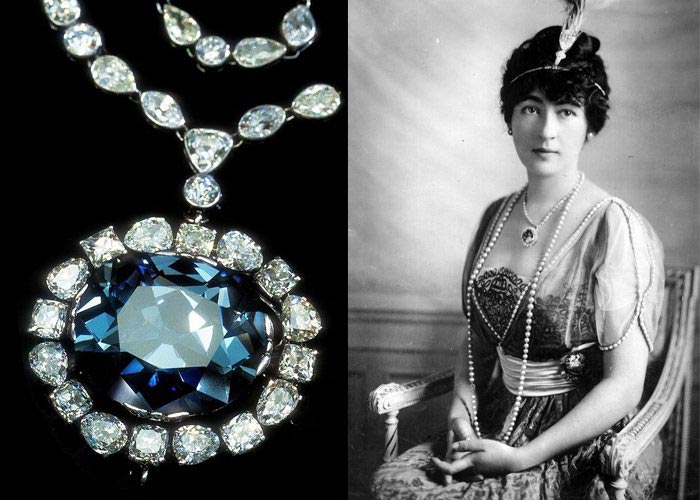
1911 witnessed the official introduction of the Santos de Cartier wristwatch, which was modeled on the 1904 prototype created for Alberto Santos-Dumont. That same year, Jacques Cartier, who believed in the importance of building strong relationships with key clients, began his journeys on behalf of the company.
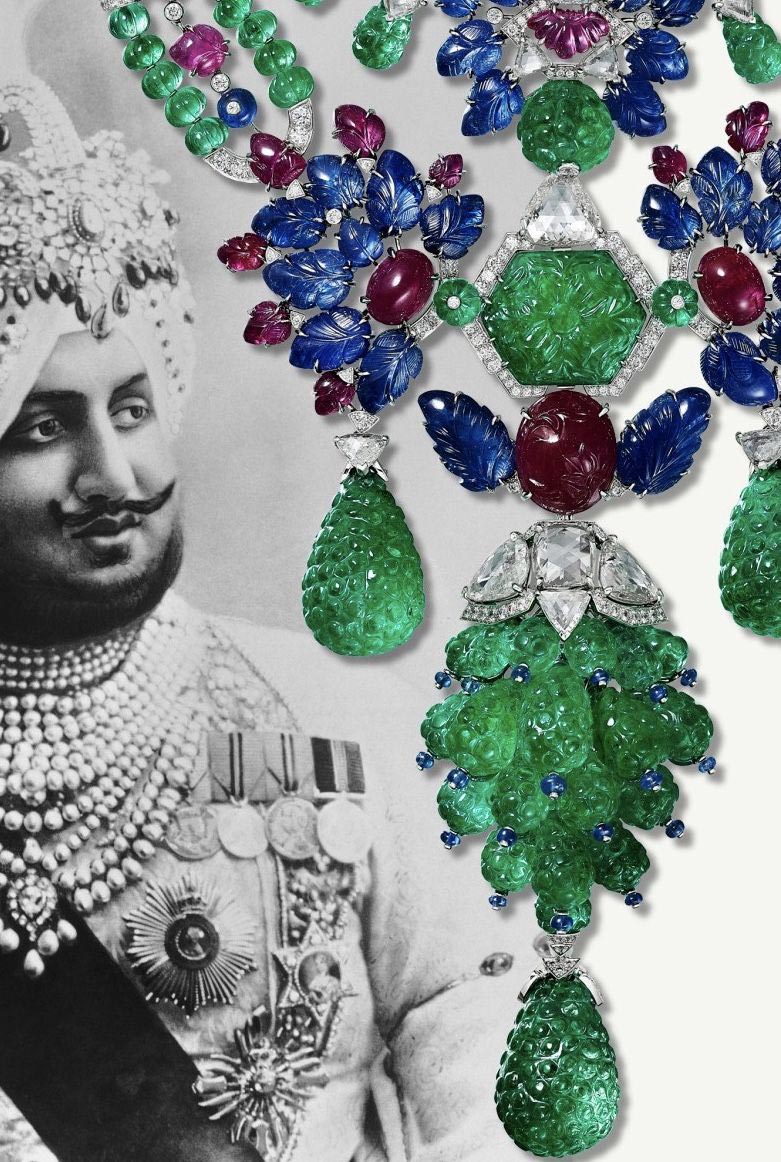
Throughout the 1920s and 1930s, he traveled extensively in Asia and the Middle East, purchasing a huge assortment of colored gemstones and pearls. Acting as an ambassador for the popular art deco styles of Paris, he convinced the Maharajas of India to let him reset their royal gems in more contemporary designs, leading to the legendary Tutti Frutti creations. The Tutti Frutti pieces combine brilliantly colored gems with creative Cartier settings, a style still currently in production.
In 1912, Cartier introduced their first Mystery Clock, which was inspired by the 19th century French illusionist and magician Jean-Eugene Robert-Houdin. It was a box-shaped mantel clock made entirely out of rock crystal with a “magical” invisible dial that gave the illusion that it was floating. Using white agate, platinum, gold, rose-cut white diamonds, sapphires, and enamel flourishes, the clock was a tour-de-force of Art Deco style.
The rock crystal case contained twin columns that braced the dial. A mechanism was encased in the base and connected to the dial using glass disks fused to thin metal ring gears in the hour track bezel. The initial “Model A” Mystery Clock was followed by 20 different variations including the Portico in 1923. This model featured a floating dial that seemed to be suspended by a chain.
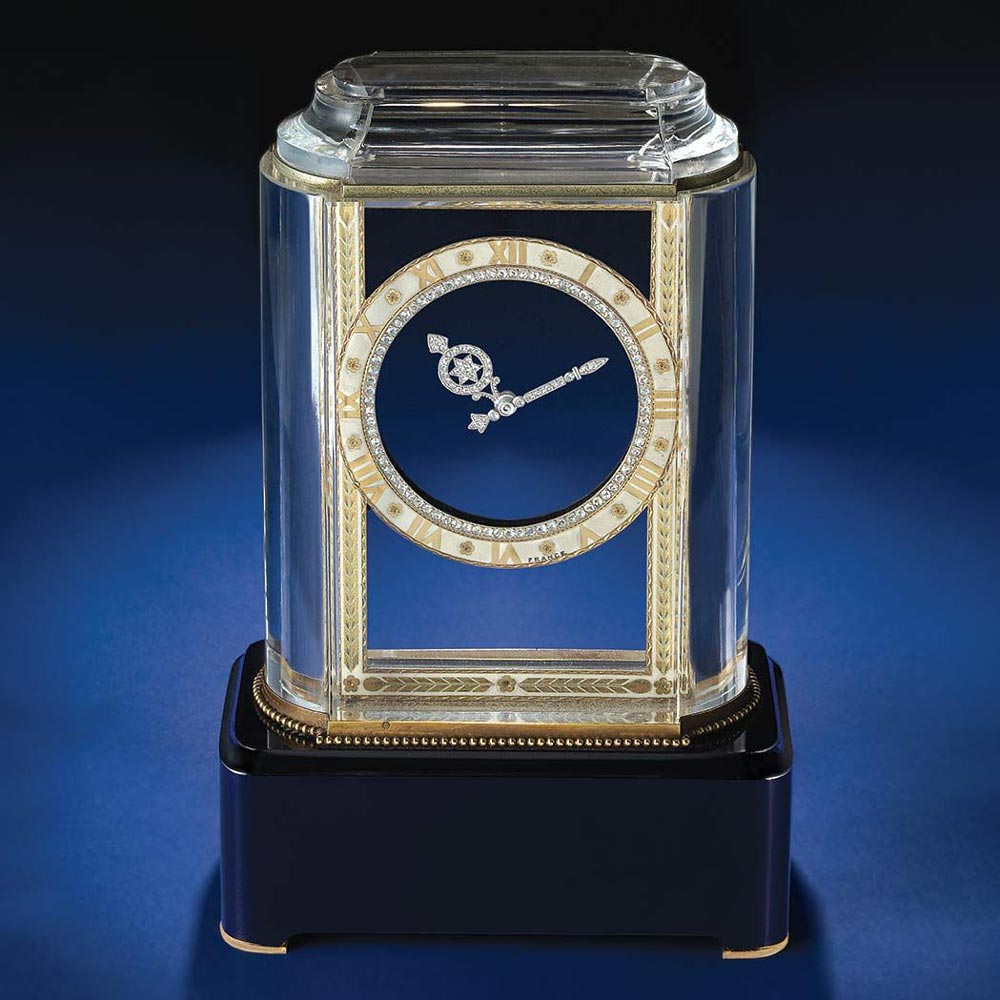
Introduced in 1912 and 1914 respectively, the fabulous Tortue and Panther models were made of gold, platinum and black onyx and set with diamonds and precious gems.
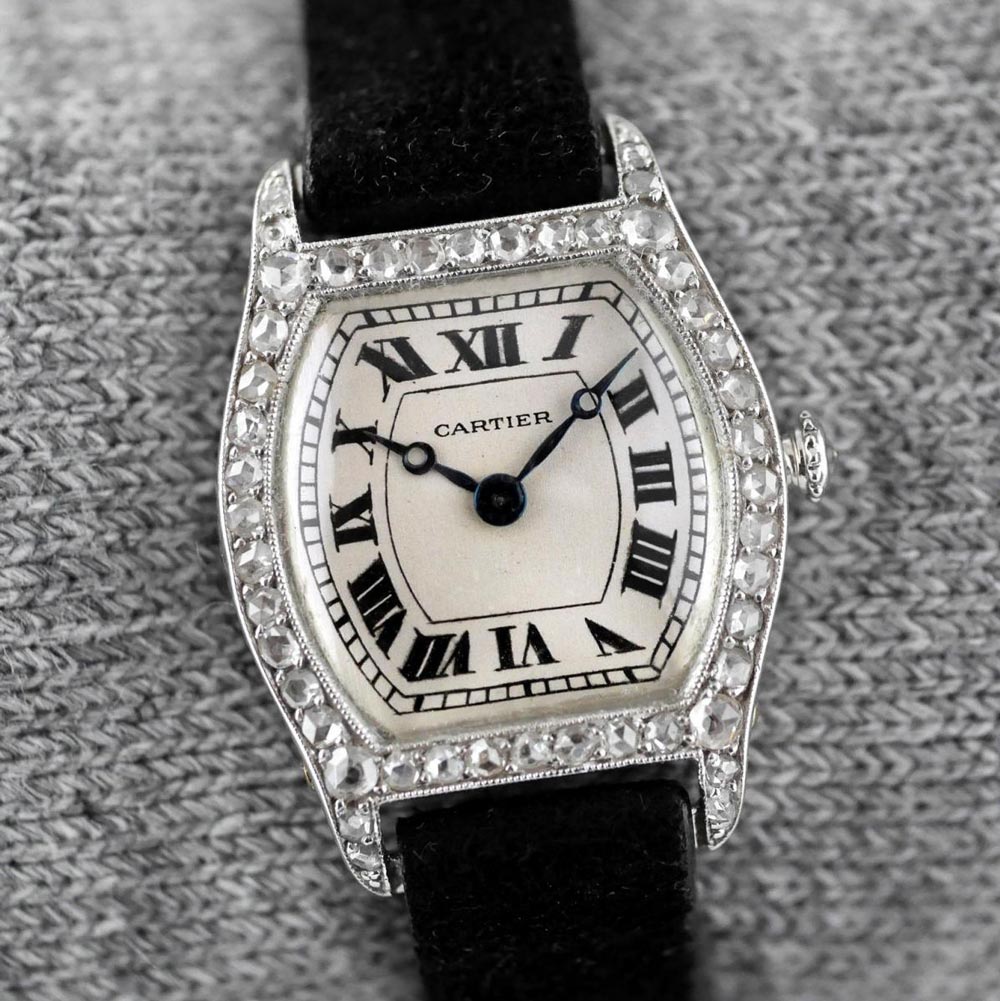
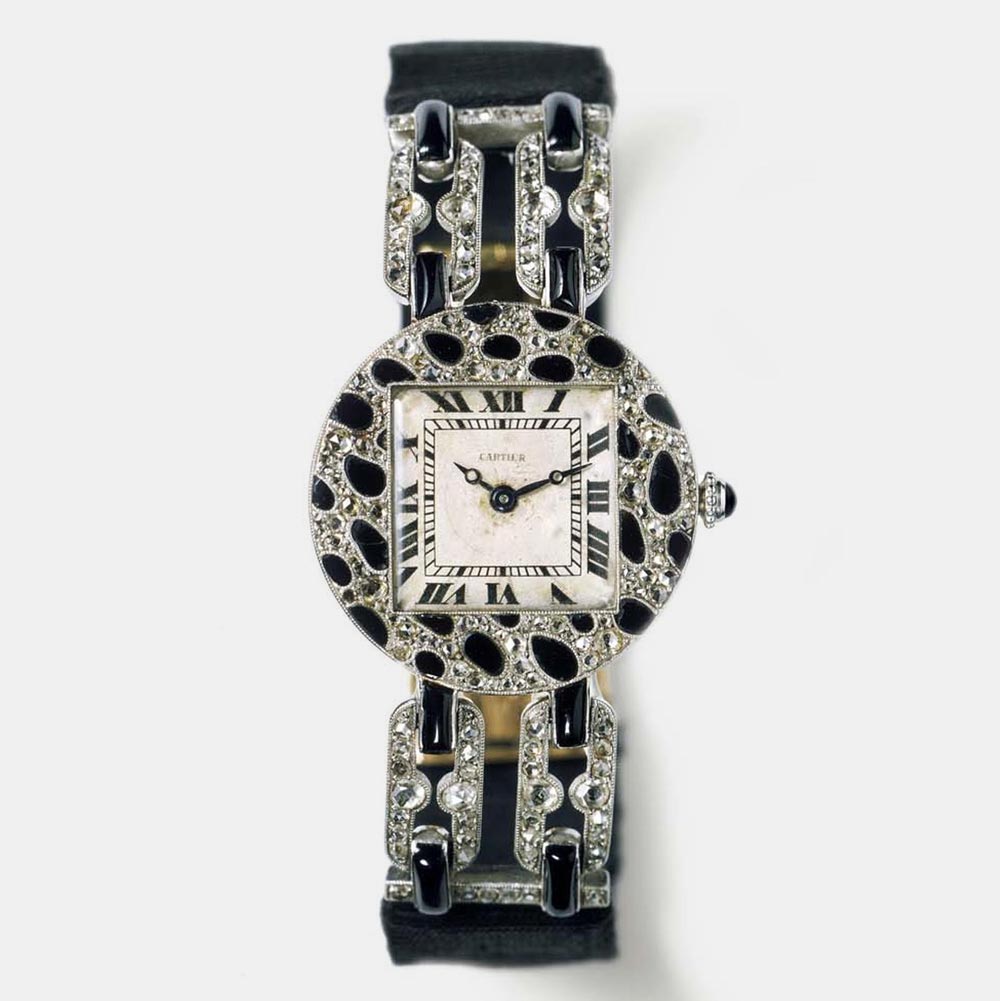
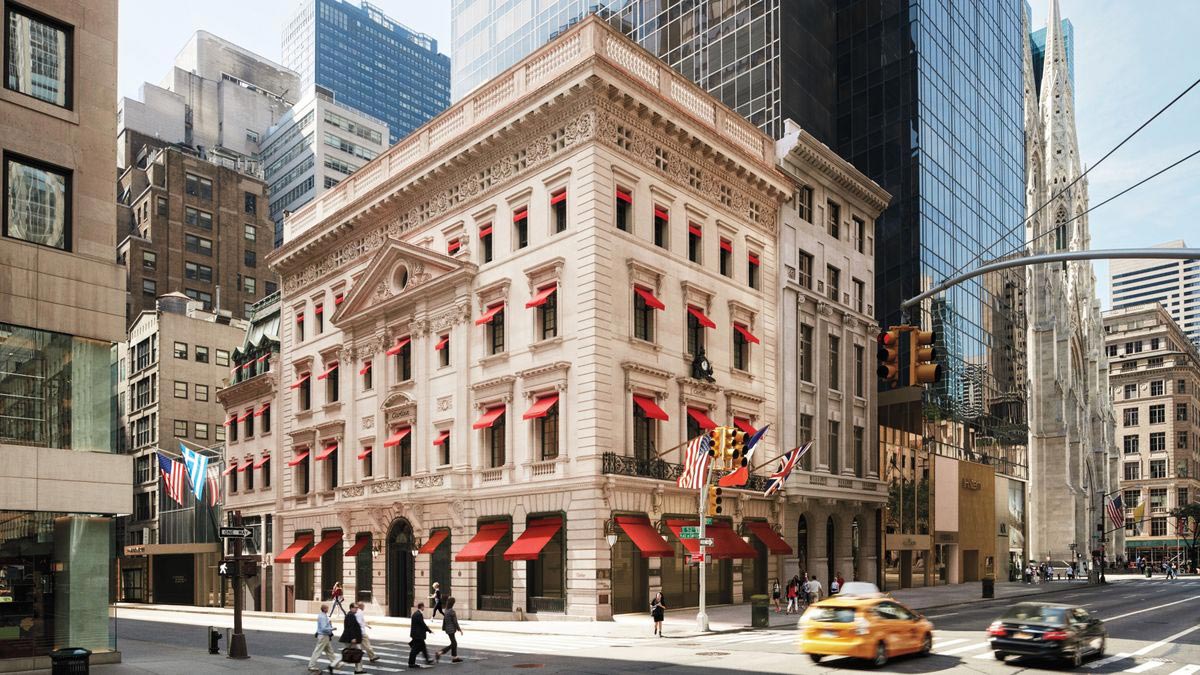
In 1917, the New York boutique moved into the mansion of financier Morton F. Plant at 653 Fifth Avenue, who traded the building for a double strand of 128 natural pearls. That same year, in the midst of WWI, Louis Cartier produced a timepiece for General John J. Pershing, commander of the American Expeditionary Forces. Inspired by the Renault FT-17 infantry tank, the watch had a sophisticated and simple design with a rectangular tonneau dial and leather band.
Two years later, in 1919, Cartier officially introduced the Tank watch in platinum with the now iconic winding crown set with a sapphire cabochon.
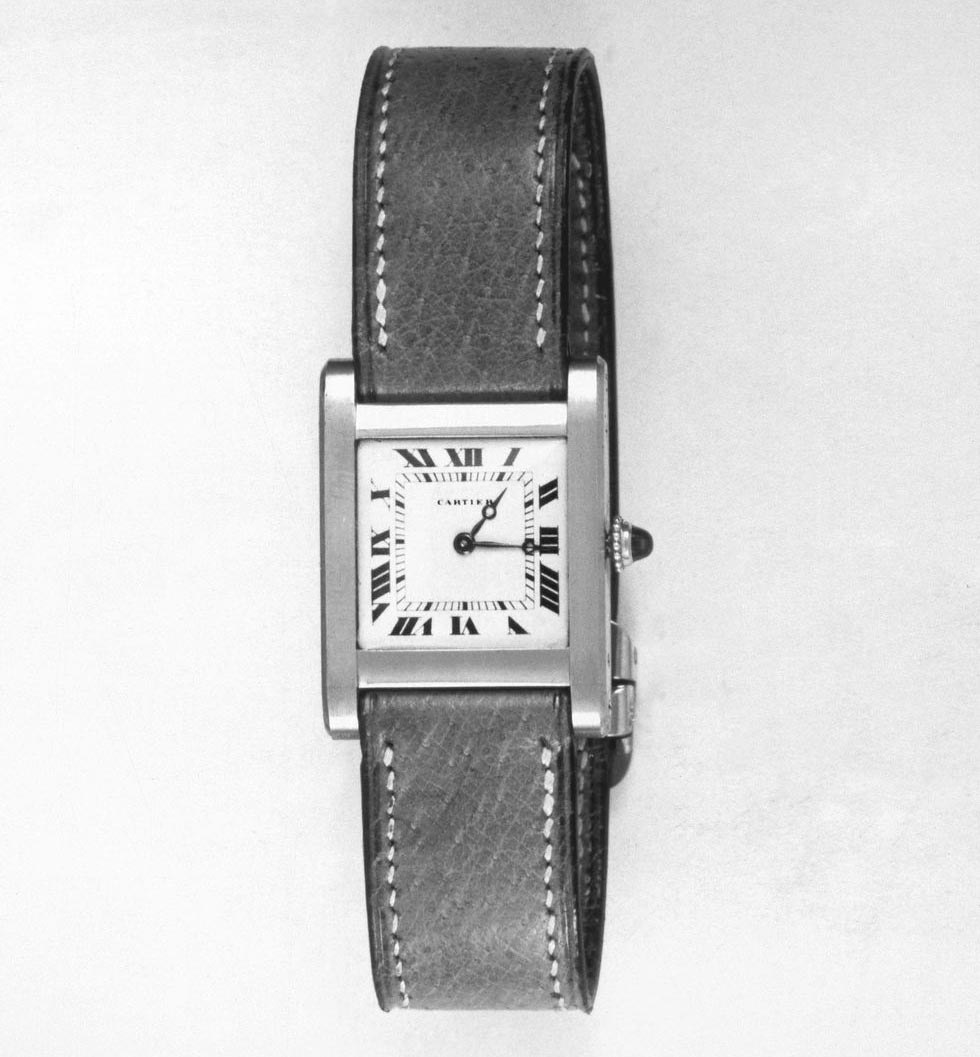
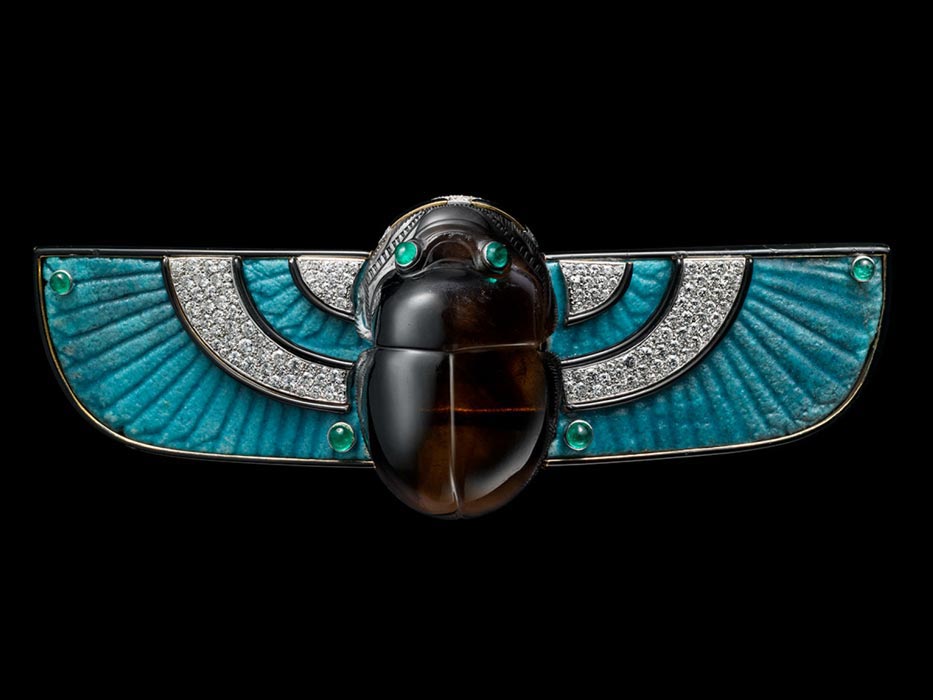
Triggered by the discovery of King Tut’s tomb in 1922 by Englishman Howard Carter, traditional Egyptian designs quickly dominated the world of decorative art. Cartier was once again at the vanguard of the newly popular aesthetic and produced many pieces that paid tribute to the rediscovered ancient artifacts. In the London workshops of Jacques Cartier, members of the British royal family, including King George and Queen Mary, brought Cartier to dominance in the English court with scores of commissions fueled by a daily supply of gemstones arriving in satchels from Paris to feed the Cartier craftspeople.
In 1933, Louis Cartier appointed Belgian-born French fashion designer and jeweler Jeanne Toussaint (1887–1976) as the head of Cartier Jewelry. Fueled by her love for panthers, Jeanne expanded on the eponymous theme and designed an incredibly thin platinum wristwatch for Princess Elizabeth of the United Kingdom. At the time, the Panther ranked as one of the world’s smallest watches.
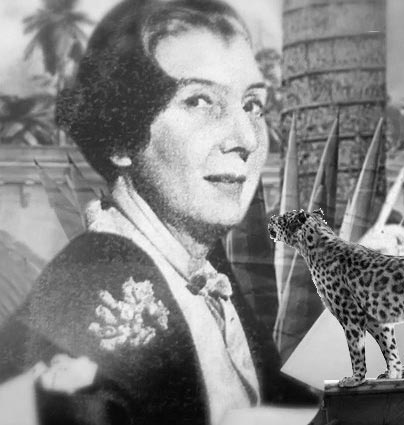
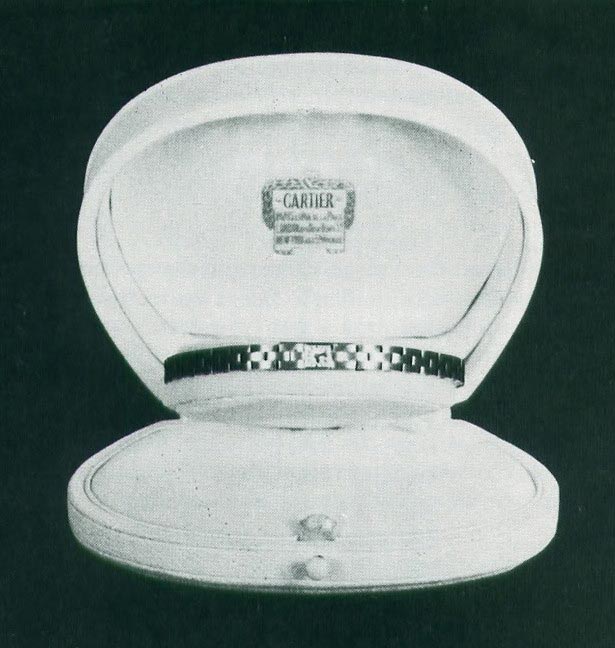
Other Toussaint creations reflected the ongoing conflict of World War II. The "Caged Bird" brooch became a symbol of the German occupation of France in 1942, and two years later Cartier produced the "Freed Bird" brooch to celebrate the country’s liberation.
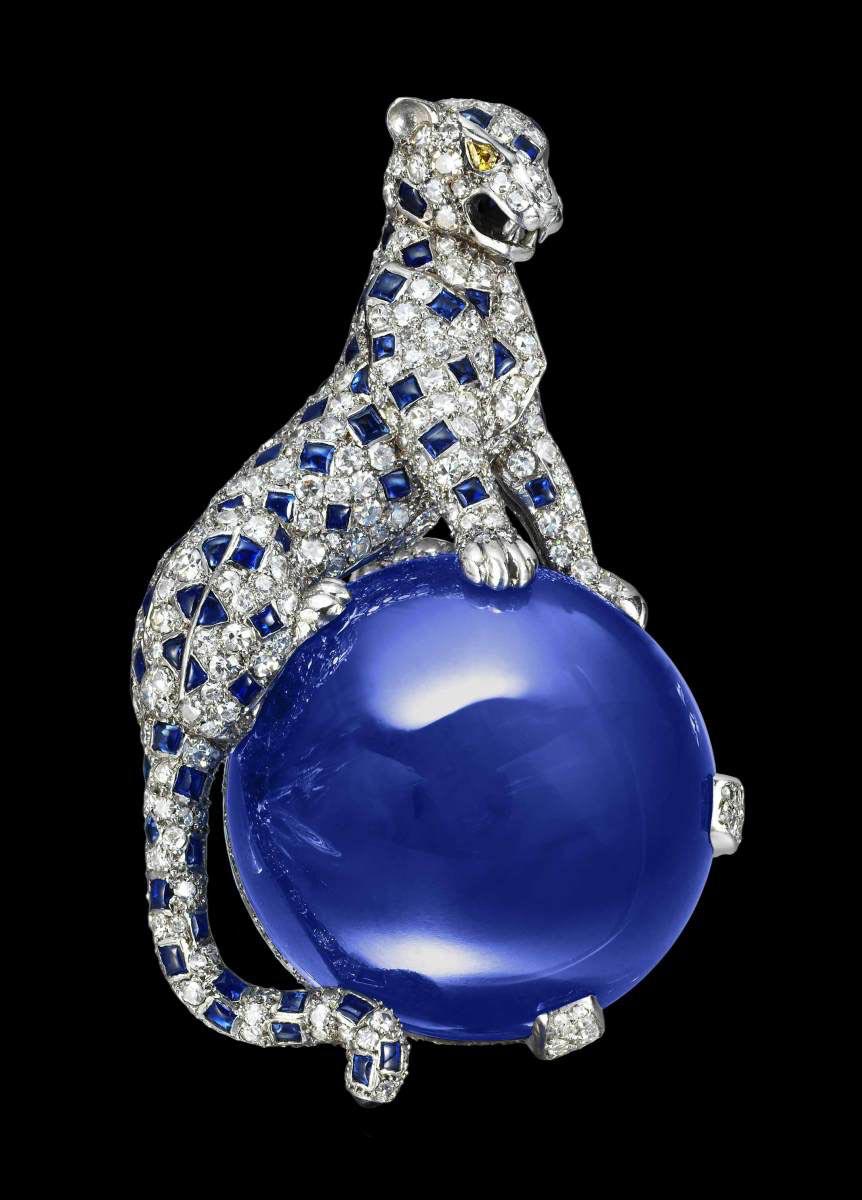
1949 brought the debut of the fabulous platinum Panther brooch with a diamond pave panther poised atop a spherical 152-carat Kashmir sapphire cabochon. The piece was purchased by the Duke and Duchess of Windsor and remained in their collection until it was bought back for the internal Cartier collection in 1987.
Jeanne (who was also Louis Cartier’s paramour – he refused to marry her because of her family’s background) received the Grand Cross of the Legion of Honor for her immense contribution to jewelry and design in 1955.
1955 also saw the formation of patronage relationships between Cartier and many famous artists. Actors, actresses, artists, and others commissioned Cartier to create personal objects and jewelry for them. Patrons included:
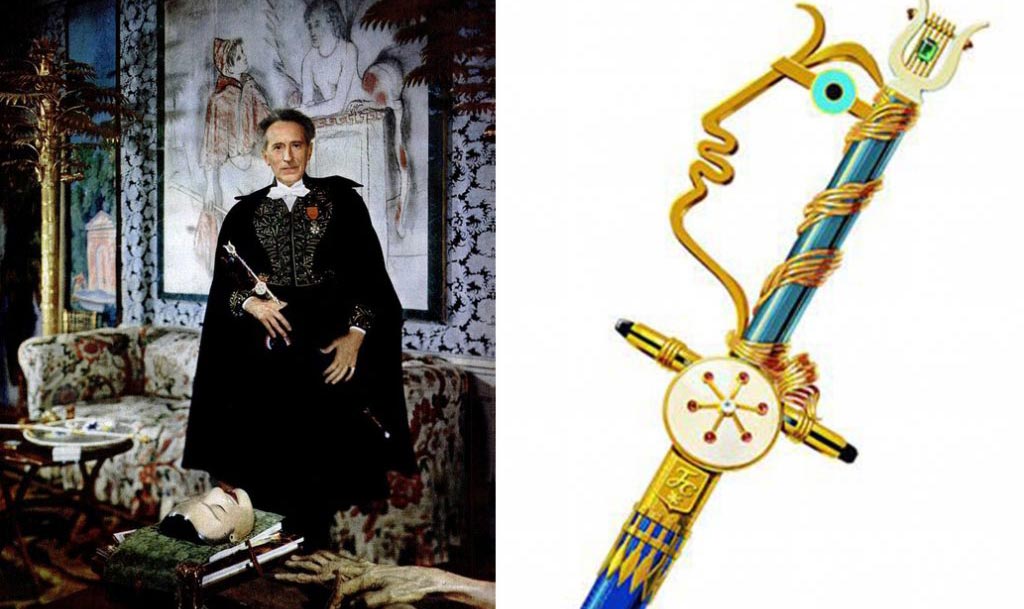
The renowned French artist Jean Cocteau worked with Cartier to design the sword given to him upon his election to the Academie Francaise, with an iconic Cocteau self-profile as a handle guard.
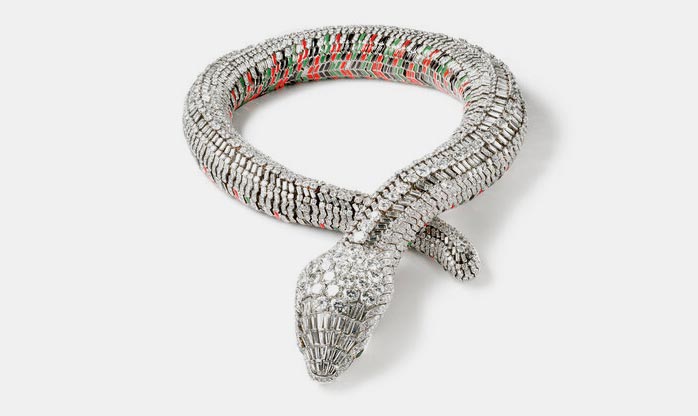
The great Mexican actress Maria Felix had Cartier craft a fantastic articulated diamond necklace shaped like a serpent in 1968.
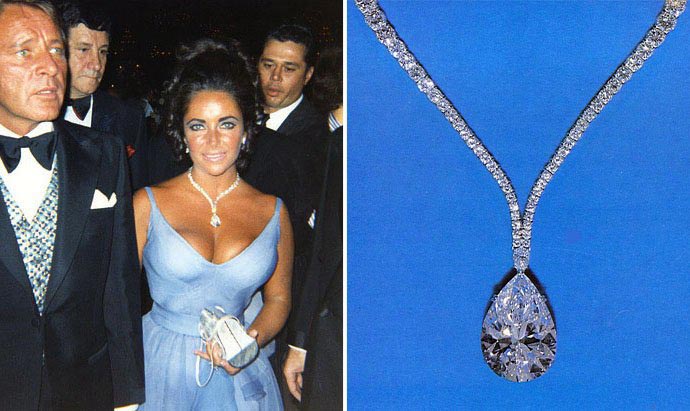
Actor Richard Burton purchased a 69.42 carat pear-shaped diamond from Cartier that he presented to his then-wife, renowned actress Elizabeth Taylor. The piece became known as the "Taylor-Burton" diamond, bringing international fame to the company once again.
Jean-Jacques Cartier loved the design process and worked in the London studio and gemstone laboratory - named the English ArtWorks Workshop - with the company’s craftspeople.
Rather than meeting with prospective clients, he much preferred the creative aspects of the process, choosing the perfect gems, and personally overseeing the fabrication of new pieces. In a family of extremely creative people, he very well may have been the most talented of the bunch.
In 1967, he produced the iconic Cartier Crash, a radical oval watch with a “pinched” shape and a kink in the middle of the case. Legend has it that the design was inspired by a Cartier Baignoire that had been involved in a car accident, but that story has never been verified. A collaboration with his premier designer Rupert Emmerson, the model was an homage to the exciting and novel fashions of London in the “Swinging 60s”. Available only at the London boutique, Cartier created a few dozen examples through the early 1970s. After this initial run, a limited run was produced in the 1980s, followed by an extremely limited edition Paris Crash in platinum in the early 1990s and another limited edition of 400 pieces from Cartier Paris in 1991.
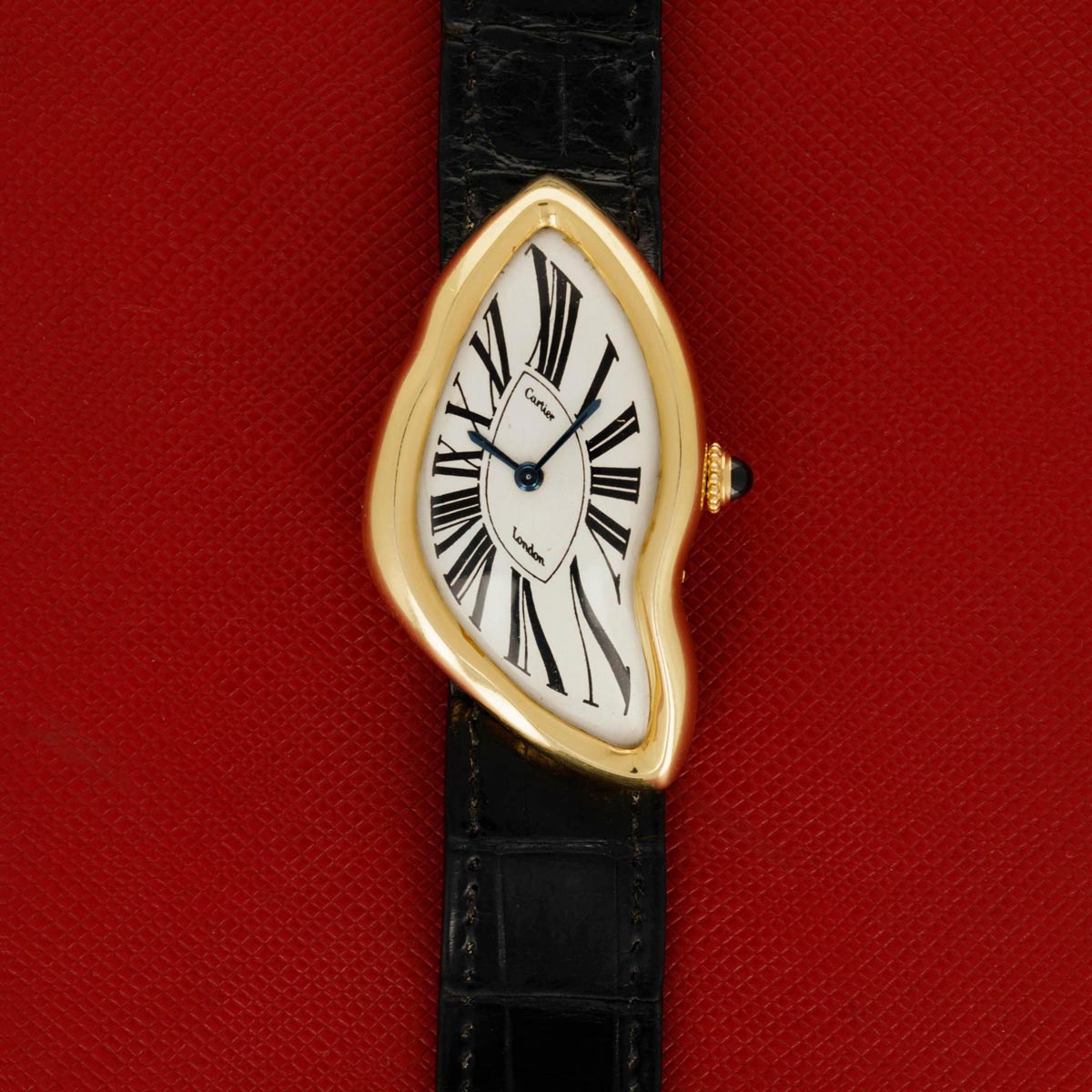
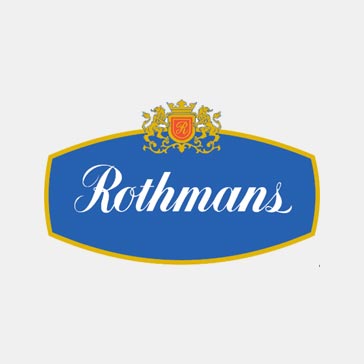
Upon the death of Pierre Cartier in 1964, Jean-Jacques Cartier, Claude Cartier, and Marion Cartier Claudel, the great-grandchildren of patriarch Louis-Francois, split the business and sold the New York, London, and Paris divisions to different groups of investors. In 1973, the industrialist Robert Hocq, assisted by a group of investors that included the founders of the Rothmans/Richemont group, bought Cartier's New York branch. By the end of the decade, this group had purchased the London and Paris divisions as well and reorganized the company as Cartier Monde. At the start of the 1980s, the Kruger family of the Richemont Group bought out the rest of the Cartier investors and added the company to its rapidly growing group.
The late 1970s through the 1990s saw the addition of many new models to Cartier’s offerings including the Santos de Cartier model which debuted in 1978 with an integrated gold and stainless-steel bracelet and eight gold screws in the bezel. In 1985 another iconic model, the new Pasha de Cartier, was introduced. The Pasha was a modern reinterpretation of a famed piece commissioned in the 1930s by the Sultan (Pasha) of Marrakesh. The sultan told Louis Cartier he wanted a luxurious wristwatch that he could wear for his royal duties as well as in the swimming pool, prompting the creation of the first highly water resistant Cartier watch. It caused an instant style revolution with its elegant yet simple round case, square minute track, Vendome screwed lugs, and surprising (but now-iconic) safety-chained winding crown. The new model was reimagined by famed designer Gerald Genta and utilized the Cartier caliber 1847 MC movement.
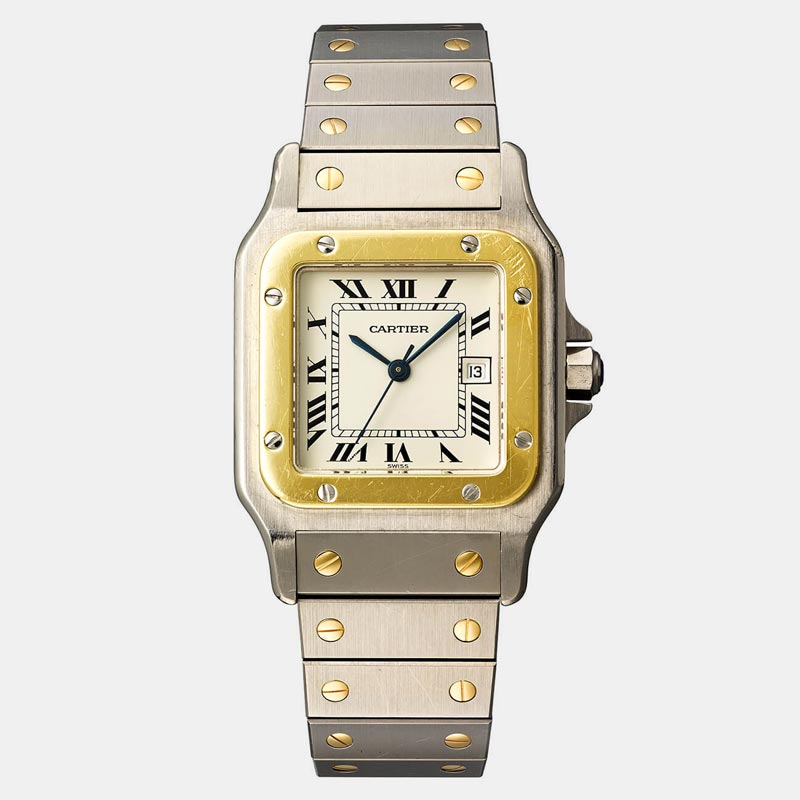
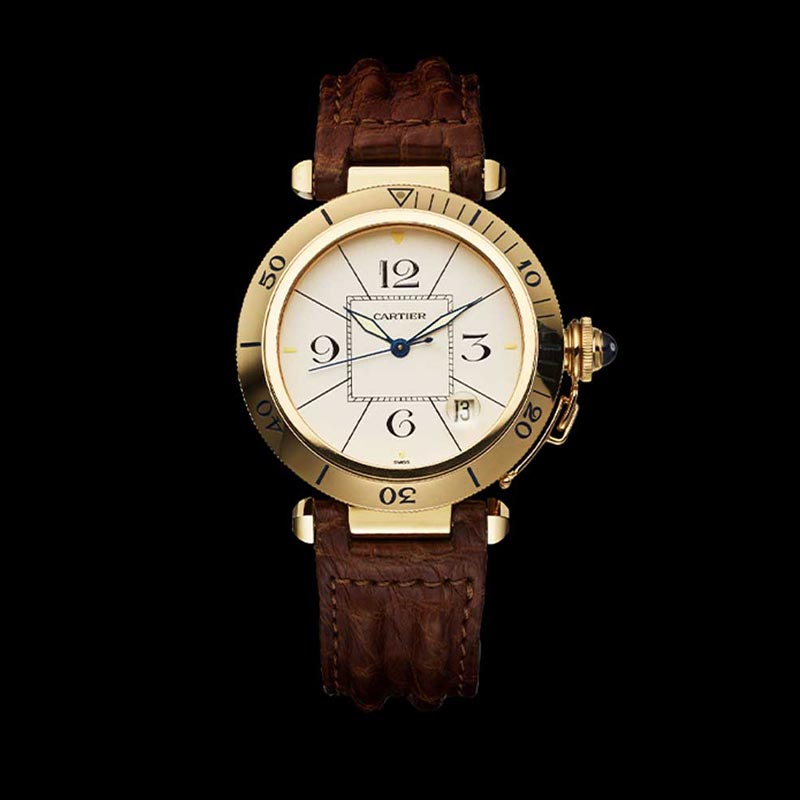
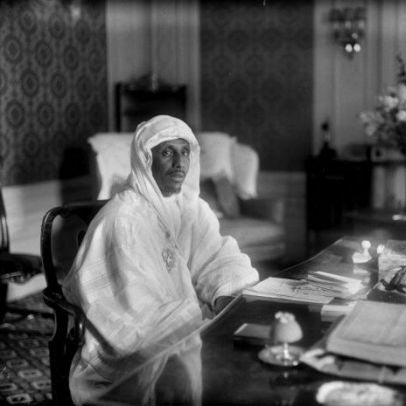
In 1993, various holdings of the Richemont Group were reorganized into the Vendome Luxury Group PLC, with Cartier accounting for 60% of the new conglomerate’s initial sales. The group worked to expand beyond the traditional maisons located in New York, Paris, and London, and by the late 90s had opened nearly 175 new retail locations.
Cartier celebrated its 150th anniversary jubilee in 1997 with several magnificent creations marking the event, including the platinum "Eternite" serpent necklace. This piece featured an articulated platinum and diamond pave necklace in the shape of a snake set with two huge pear-shaped emeralds of 205 and 206 carats, and 21 smaller pear-shaped emeralds.
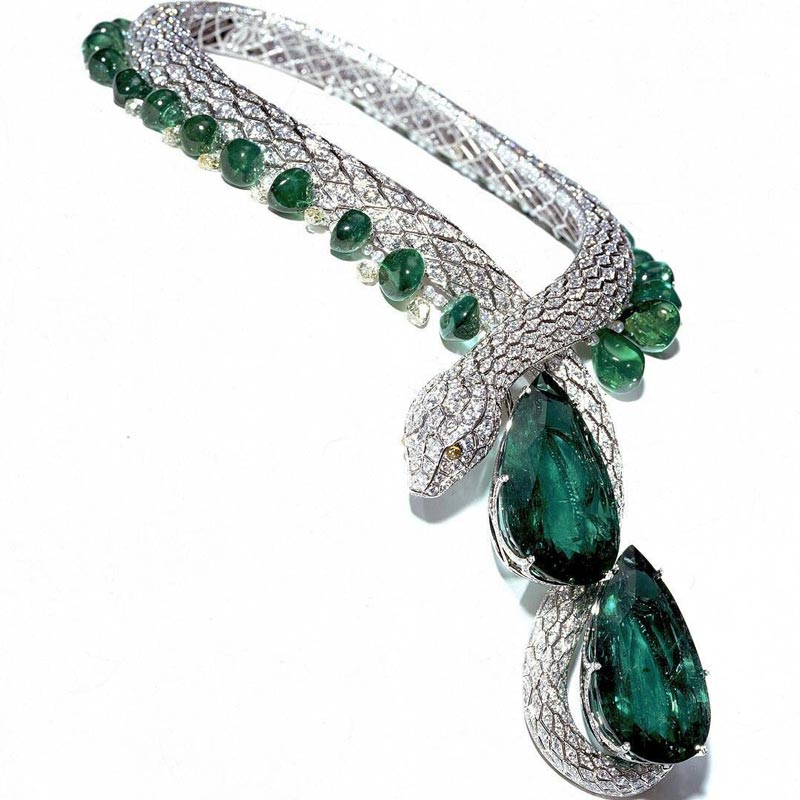
COLLECTION PRIVEE CARTIER PARIS
In 1998, in an effort to steer the brand back towards its haute horology roots, Cartier created the legendary Collection Privee Cartier Paris (or CPCP for short).
Billed as a “collection within a collection” the line was in production for ten years and featured models that referenced historic Cartier designs while utilizing the finest manual-wind movements available from high end manufacturers such as Piaget, Renaud & Papi, and even F.P. Journe. The watches in the line were all cased in precious metals and were of a higher quality than others sold by Cartier at the time.
Let’s take a look at a few of the most important models from this famed collection:
Tank Cintree
Introduced in 1921, the Tank Cintree was a highly unusual entry into the relatively new category of wristwatches. Up until this point, watches were mainly straight-forward, utilitarian pieces, but the Cintree chose to focus more on design and aesthetics and it stood out doing so. The original model was produced in extremely limited quantities making the Cintree a very rare and desirable piece. For the Collection Privee, two different variants of the Tank Cintree were produced. First came the time only model which was inspired by a piece bought by American actor and dancer Fred Astaire in 1921. 150 pieces were produced in yellow gold and another 50 were produced in platinum. Next came the Tank Cintree Dual Time which featured two dials arranged one above the other, powered by two separate movements each with their own cabochon-set crown.
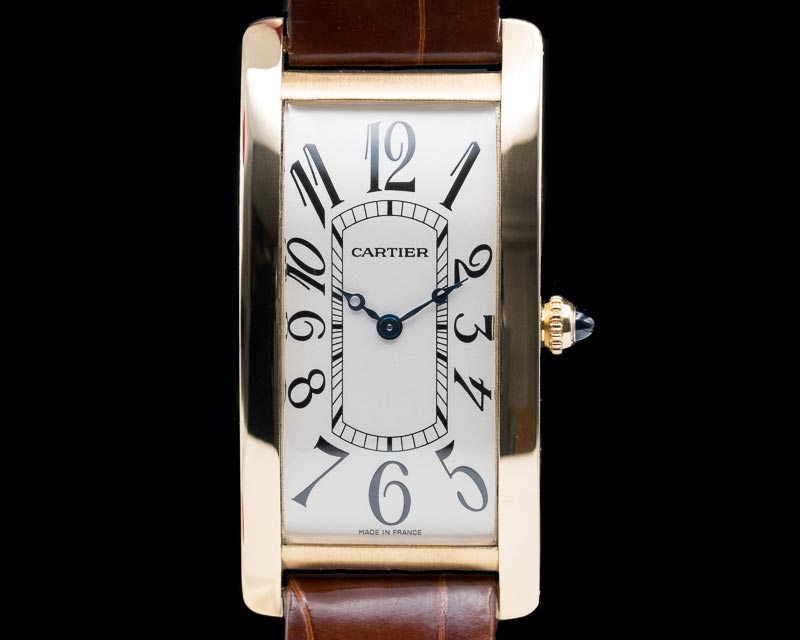
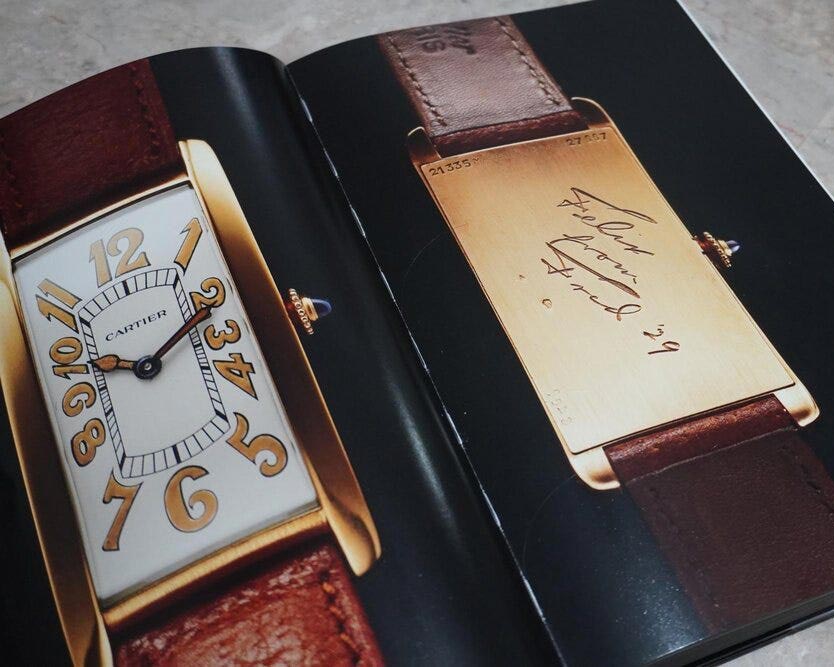
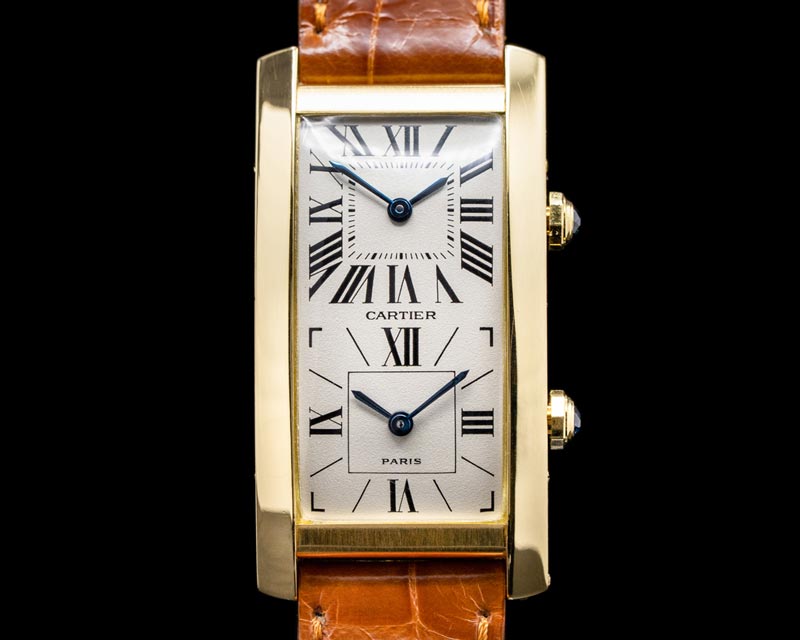
Tank a Guichets
The Tank a Guichets is one of the most unique Cartier models of all time, let alone of the CPCP collection. Originally introduced in 1928, the model was similar to the classic Tank but the dial was almost completely covered with only small apertures to display a jumping hour and wandering minutes and the crown was located at the 12 o’clock position. Spotted on the wrists of stylish creatives such as actor Gary Cooper and jazz musician and composer Duke Ellington, the unique model became a thing of legend in Cartier collecting circles. For the CPCP, 150 pieces were produced in platinum and another 100 were issued in rose gold.
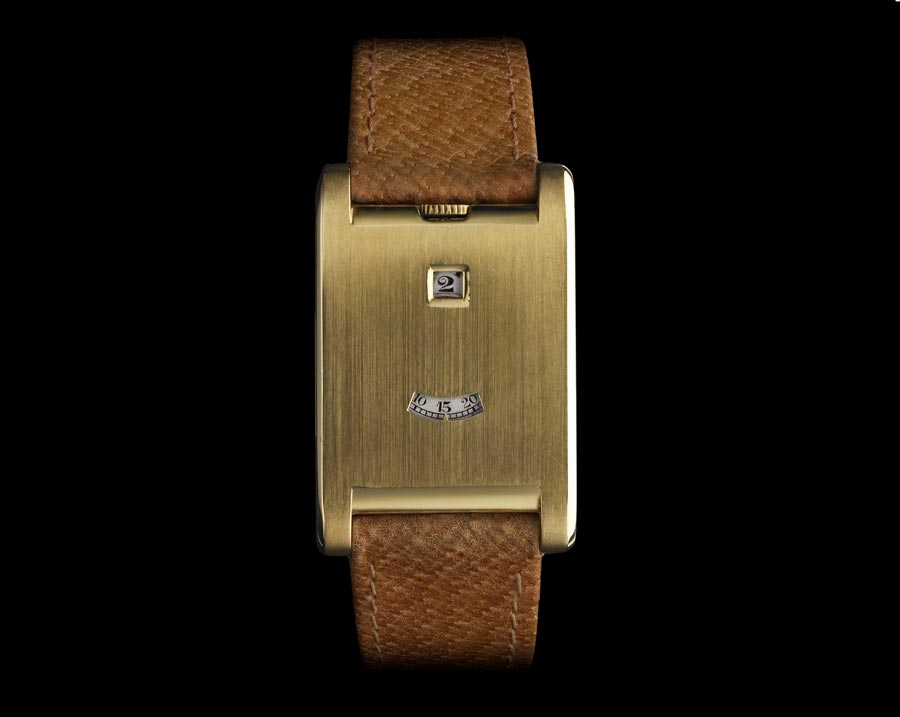
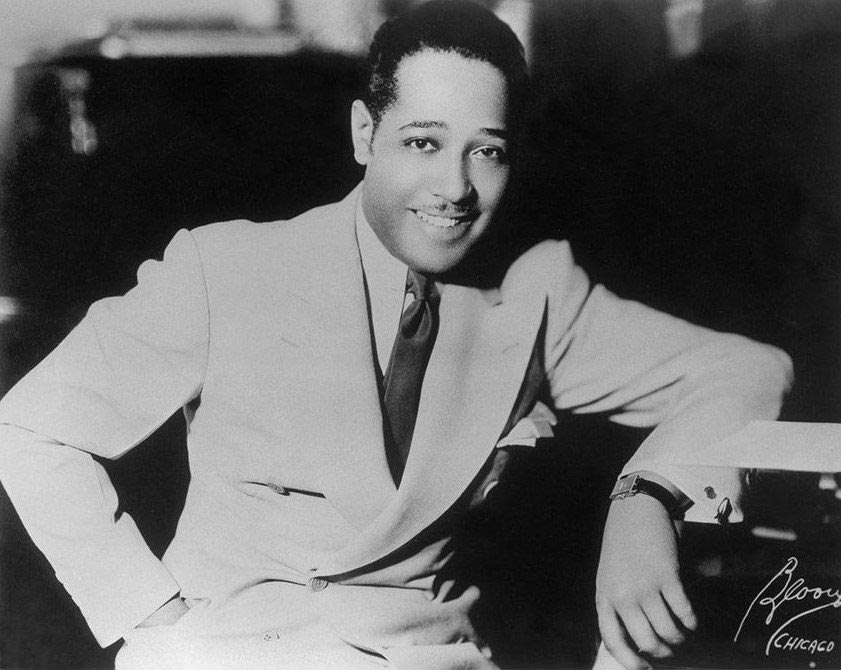
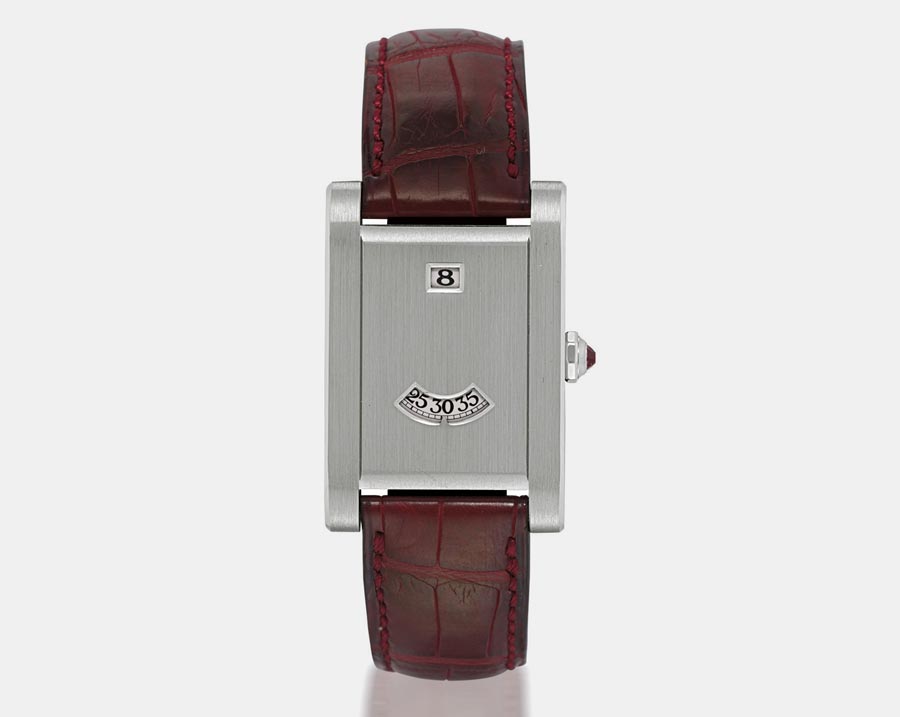
Monopoussoir Chronographs - Tank & Tortue
The movement found in the Monopoussoir Chronograph was available from the CPCP in both Tank and Tortue form and has one of the most interesting development stories of any from the collection. The movement was developed by THA Ebauche, a manufacturer that was co-founded by Francois Paul Journe and that employed many talented watchmakers who would go on to found independent brands of their own such as Denis Flageollet and Vianney Halter. First available in 1928 in Tortue form and in Tank form in 1935, the original movement was developed by Jaeger le Coultre. The Tortue Monopoussoir was re-released in 1999, followed a few years later by an “XL” model, with roughly 2,000 total examples produced over the entire run. The Tank Monopoussoir debuted in 2007 in a run of just 100 rose gold examples and sold out almost immediately. 100 more examples were offered in white gold in 2008 bringing the total production of the model to just 200 total pieces.
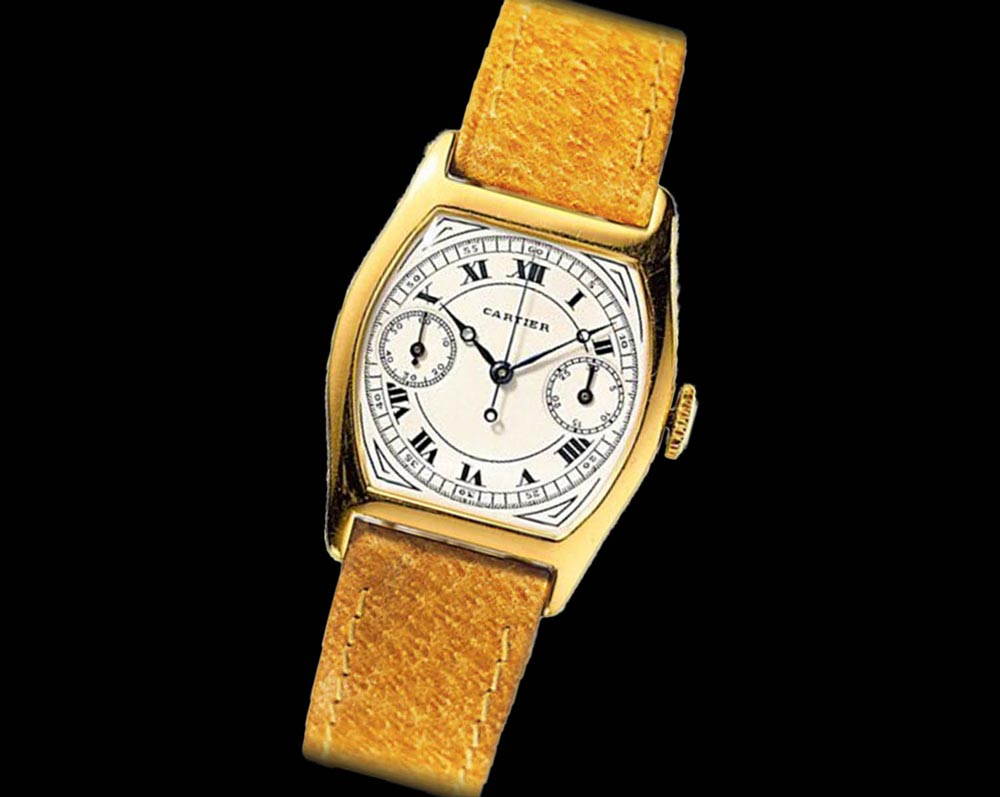
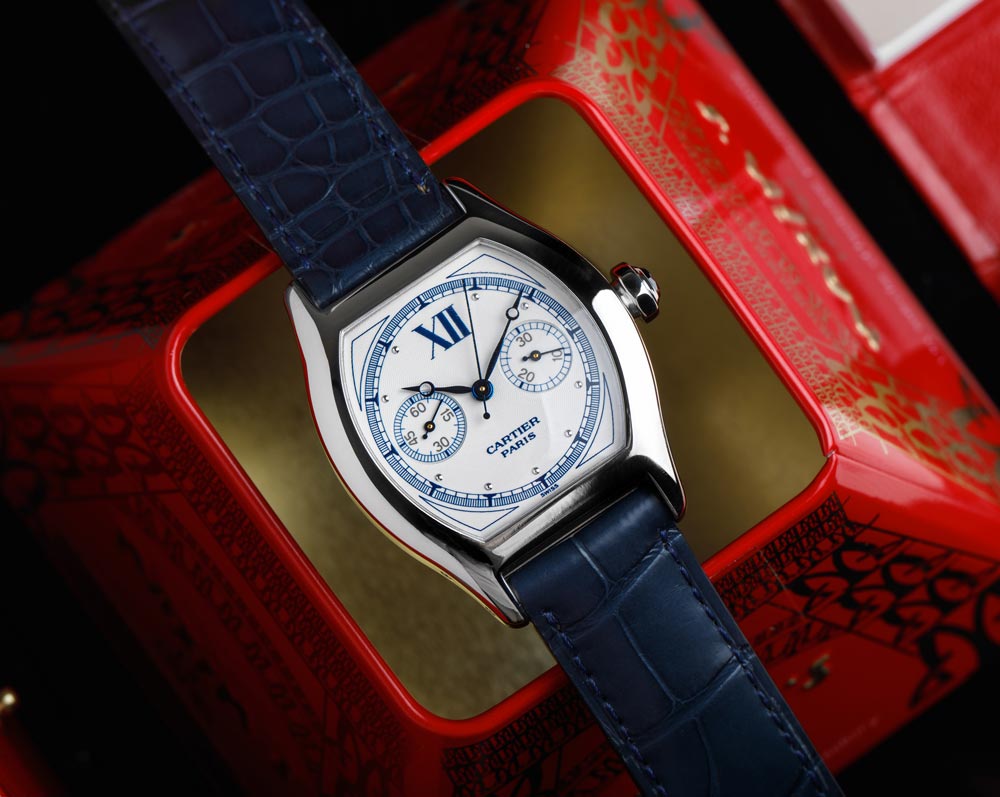
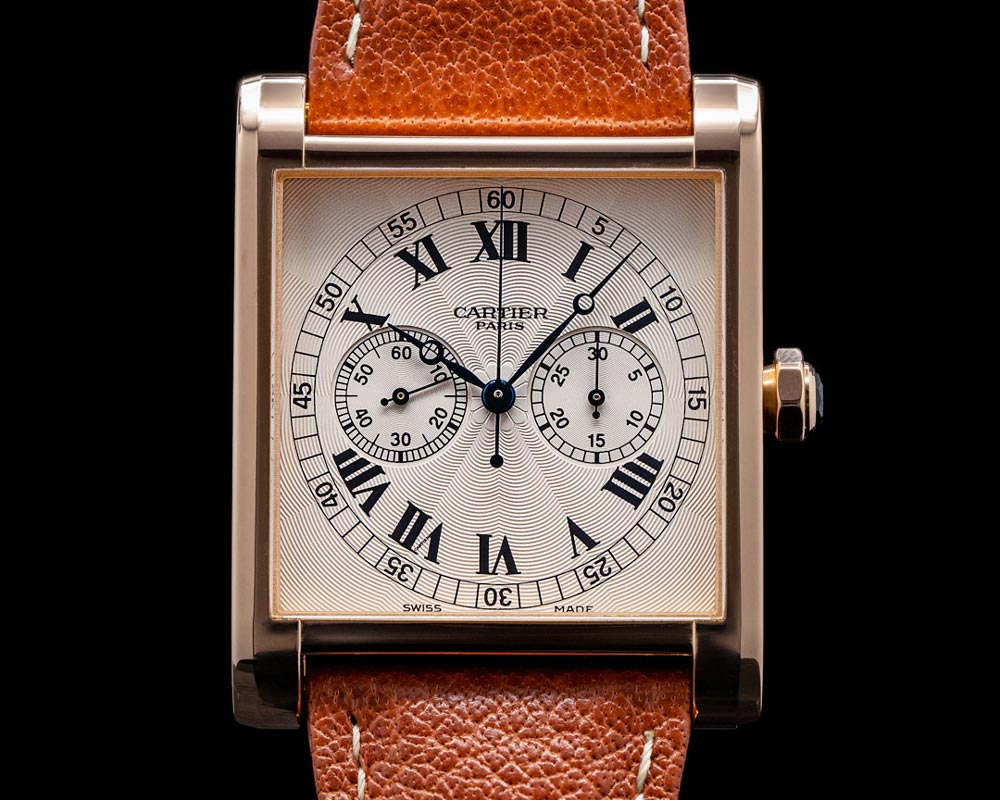
Tank Asymetrique
Originally known as the Tank Oblique when introduced in 1936, this model was designed with drivers in mind specifically. Featuring a parallelogram-shaped case with a slanted dial, the idea was that it would be easier to read when the wearer’s hands were resting on the top of a steering wheel. Reissued in 1996 just before the CPCP was officially announced, 100 pieces were produced in platinum and another 300 were made in yellow gold.
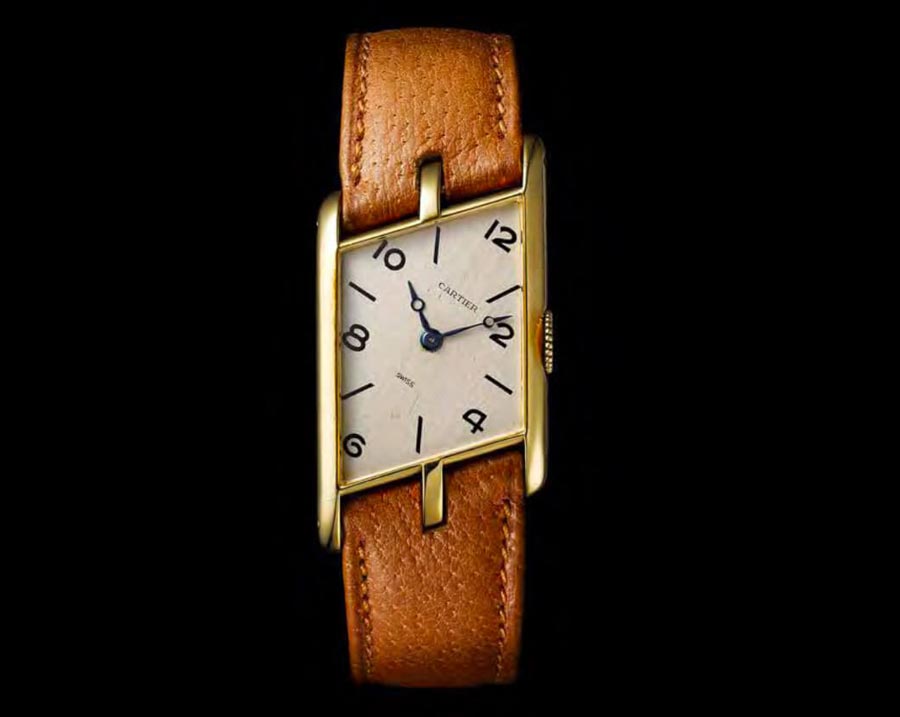
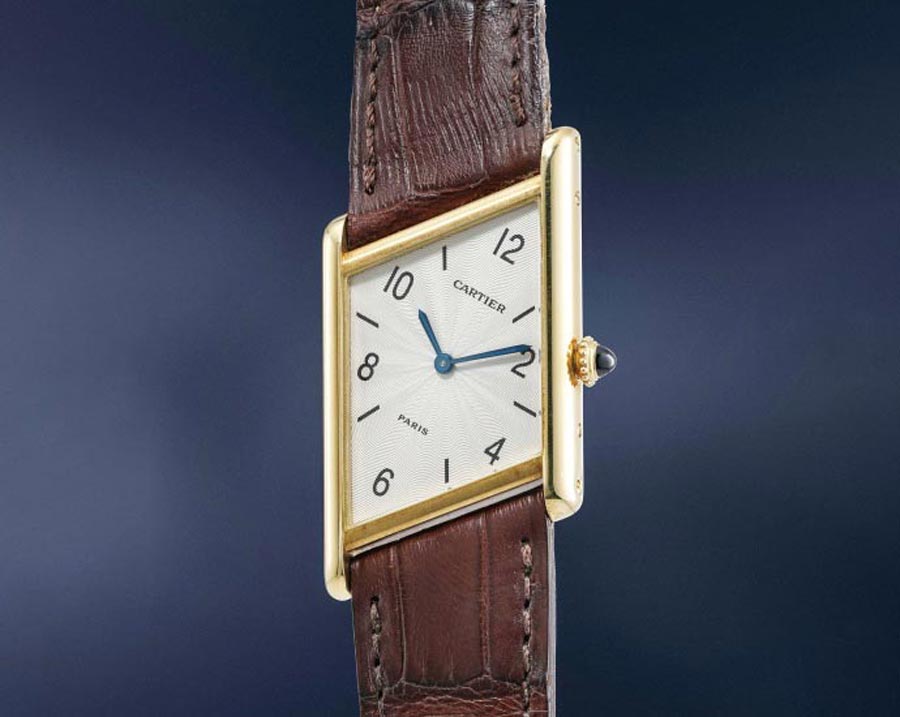
Tortue
The most popular of the CPCP releases, the Tortue model was available in a number of different configurations. Produced in white, yellow, rose gold, and platinum, you could have a simple time-only model, a perpetual calendar, a tourbillon chronograph, or even a minute repeater.
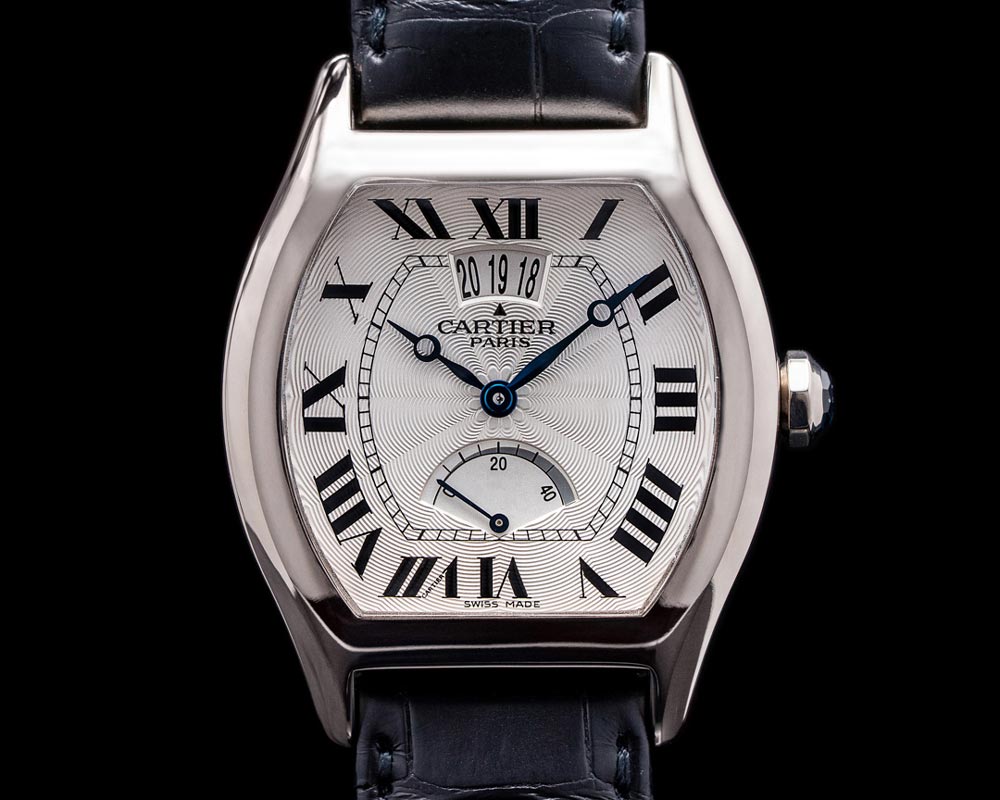
The 2000s
The 2000s marked a number of major milestones and accomplishments for the Cartier brand.
In 2000, the company built the new Cartier Manufacture in La Chaux-de-Fonds as a headquarters for the many different crafts involved in watchmaking, including design, production, administrative, and support services. The new Manufacture is one of the largest fully integrated production facilities in Switzerland and houses more than 1,000 employees.

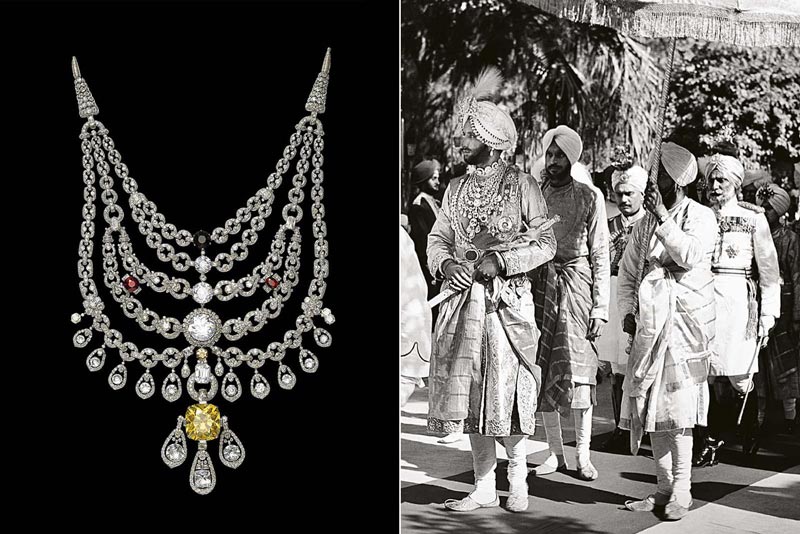
At the 21st Paris Biennale des Antiquaires in 2001, the company exhibited the famous ceremonial necklace created for the Maharajah of Patiala which onlookers stood in line for hours to view. The necklace consists of a set of five platinum chains joined together and studded with 2930 diamonds, rubies, emeralds and one of the largest diamonds ever found as its centerpiece. After disappearing from the royal Patiala treasury in the 1940’s, Cartier worked to trace and purchase whatever remains of the piece they could find, but many of the gemstones were missing. The company performed extensive restoration work and rebuilt the piece using a number of newer replacement stones prior to the exhibition.
Cartier introduced a number of new collections and models during this period expanding its already impressive repertoire beginning with the beautiful Roadster model which made its debut in 2002.
In 2003, in an homage to Jeanne Toussaint’s passion for panthers and to celebrate the popular Panther line, Cartier launched the Panther de Cartier collection of jewelry.
2007 saw the release of the Ballon Bleu model featuring a round case and completely protected winding crown. The Ballon Bleu de Cartier Tourbillon appeared in 2008, powered by the 9452 MC caliber mechanical movement. This movement won renown as the first Cartier mechanism to receive the prestigious Geneva Seal of quality.
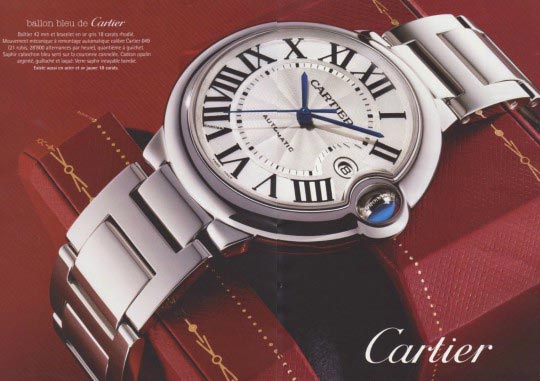
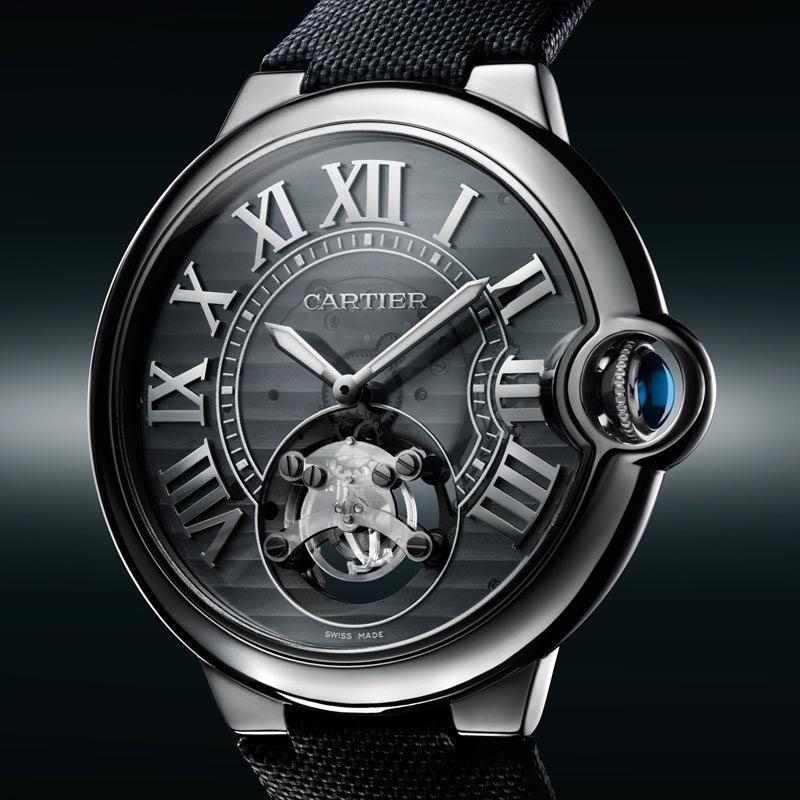
Introduced in 2009, the ID One (standing for “Ideas and Development”) was the first watch in the world to be powered by a completely adjustment and lubricant-free movement, raising the possibility of a potentially perpetual mechanism.
In 2010, the new Astrotourbillon was released as well as the Calibre de Cartier model. Leading up to this period, many Cartier watches were powered by simple quartz movements. These new complicated mechanical pieces brought a level of prestige back to the brand that included not just elegant design but superior mechanical performance as well.
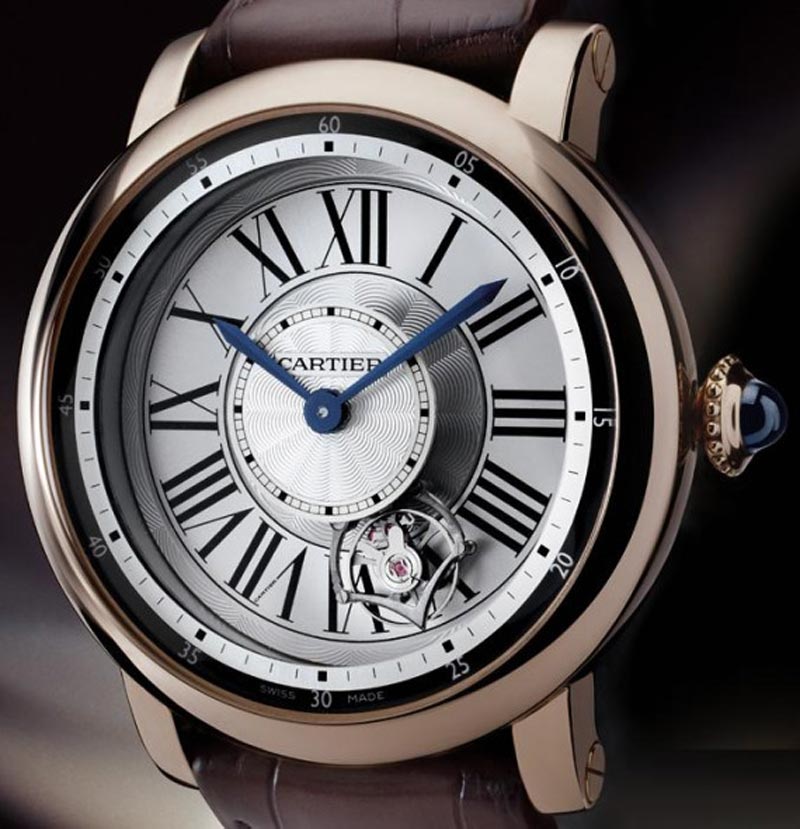
Improving on the ID One, the company released their ID Two concept watch in 2012. The ID Two featured a radical and futuristic open-worked dial and a vacuum-sealed transparent monobloc ceramic case.
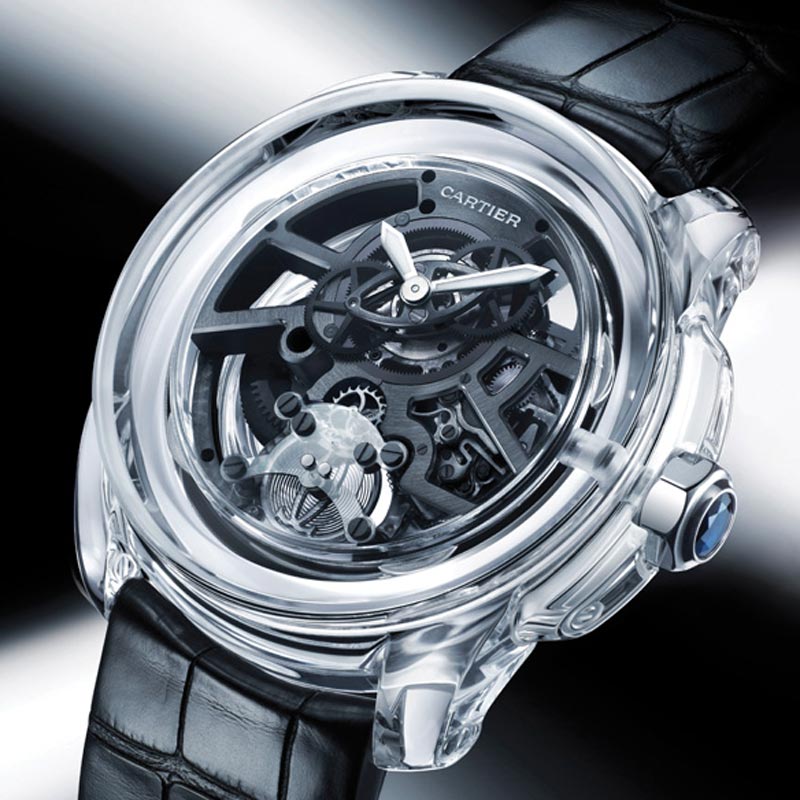
It was powered by a DLC titanium coated movement with twin dual-level barrels and four fiberglass mainsprings for an increase of 30% more energy. The ID Two had an amazing 32-day power reserve, and took five years and 135 engineers to develop at La Chaux-de-Fonds. Interestingly, the ID One and Two were never produced for sale and served as technical exercises for the Cartier team and as a demonstration of the innovative watchmaking that they were capable of. The pieces are an indication of the direction Cartier lines will take and what the brand will try to accomplish in the future.
At the SIHH conference in 2012, 19 new mechanical calibers were introduced, bringing the company to a completely new level of horologic stature. They also released a series of short films collectively known as "L’Odyssee de Cartier" which delved into the brand’s rich heritage and recounted their impressive history.
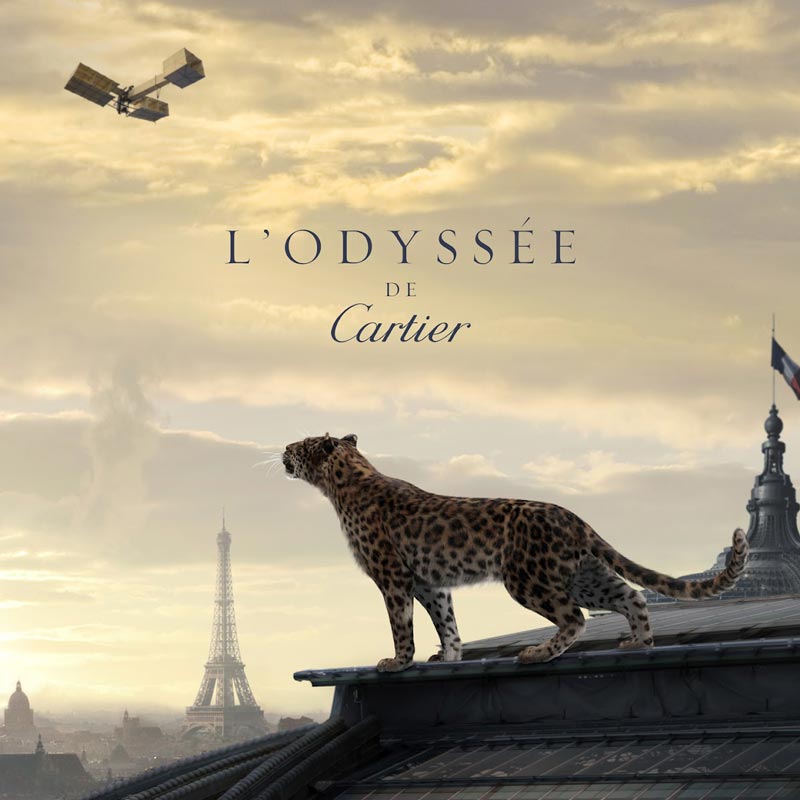
CURRENT CARTIER WATCHES (AS OF 2022)
WATCHES FOR WOMEN
There are more than 325 variations.
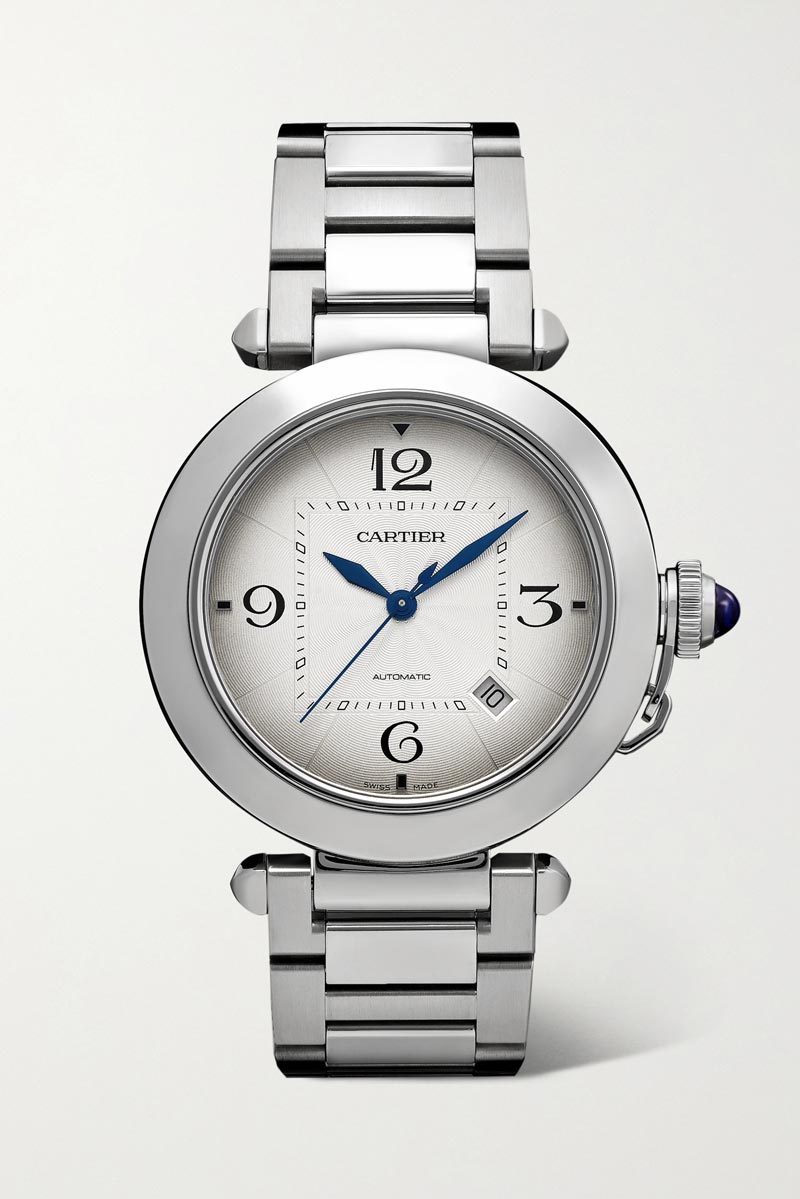
Pasha de Cartier
- Number of models: 20
- Materials and gemstones: Stainless steel, precious metals, diamonds
- Measurement(s): 30mm, 35mm, or 41mm
- Movement(s): Automatic, manual-wind, quartz
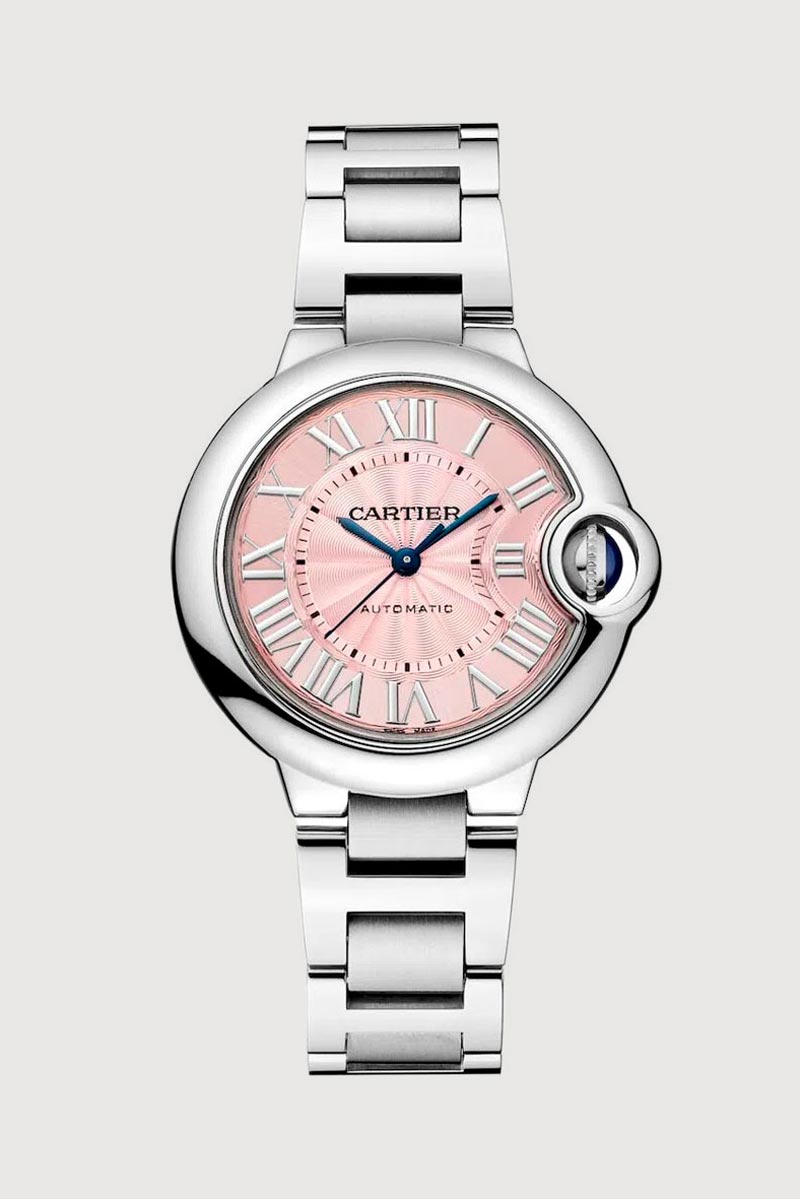
Ballon Bleu de Cartier
- Number of models: 70
- Feature(s): Protected winding crown
- Materials and gemstones: Stainless steel, precious metals, enamel, diamonds
- Measurement(s): 28mm, 33mm, 36mm, 37mm, 40mm, 42mm
- Movement(s): Automatic, manual-wind, quartz
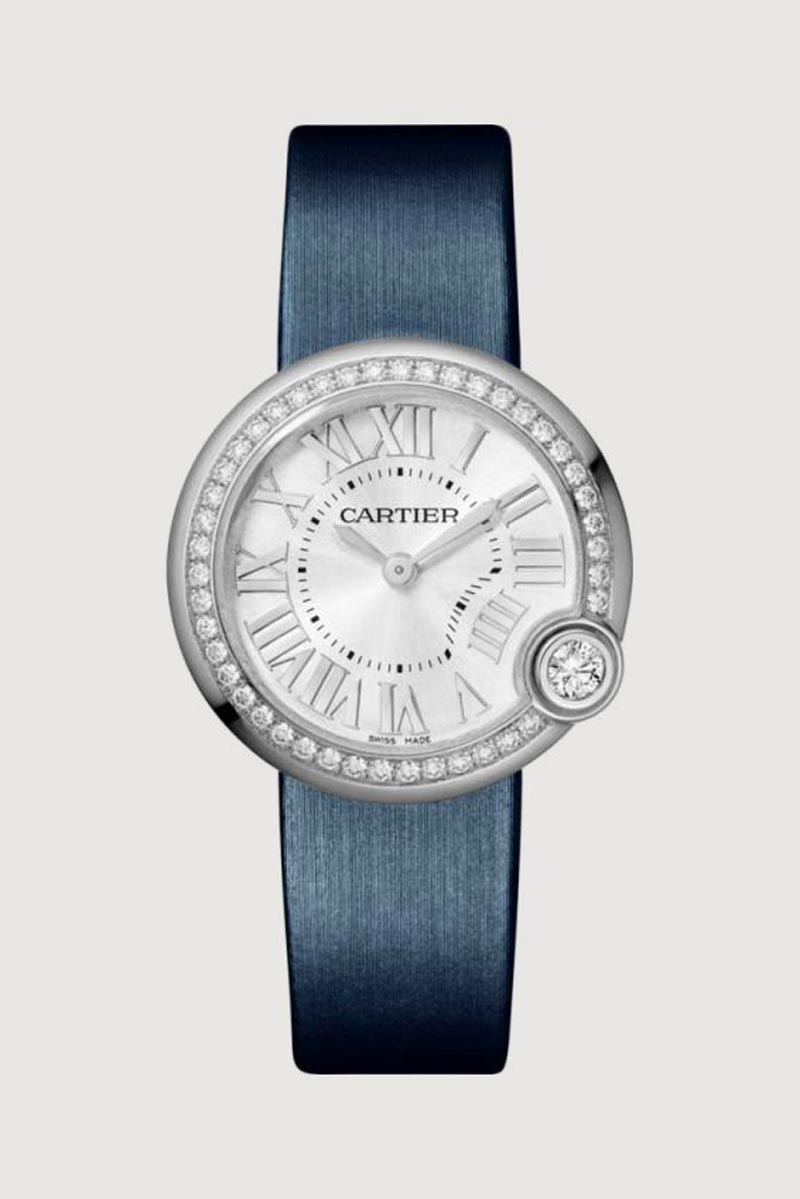
Ballon Blanc de Cartier
- Number of models: 10
- Materials and gemstones: Stainless steel, rose gold, diamonds
- Measurement(s): 26mm, 30mm
- Movement(s): Quartz
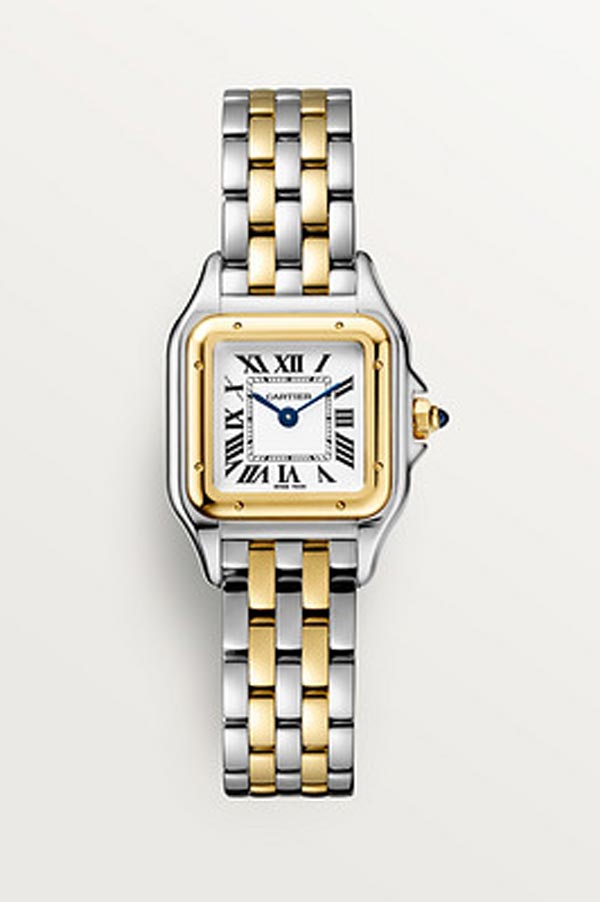
Panthere de Cartier
- Number of models: 71
- Materials and gemstones: Stainless steel, precious metals, enamel, diamonds, emeralds, rubies, sapphires, onyx
- Measurement(s): 28.4mm, 35mm, 36mm, 40mm, 41mm, 42mm, 42.7mm, Cuff-style
- Movement(s): Automatic, manual-wind, quartz
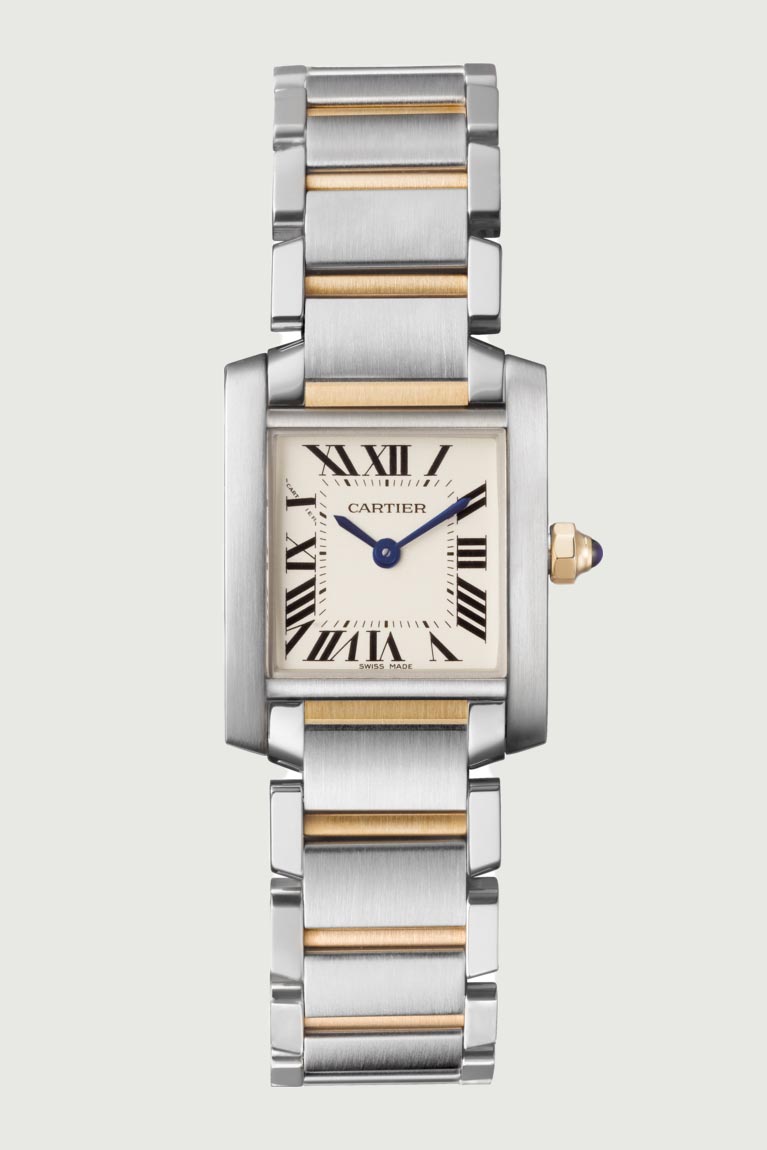
Tank Francaise
- Number of models: 11
- Materials and gemstones: Stainless steel, precious metals, diamonds
- Measurement(s): Small (25mm x 20mm), Medium (30mm x 25mm)
- Movement(s): Quartz
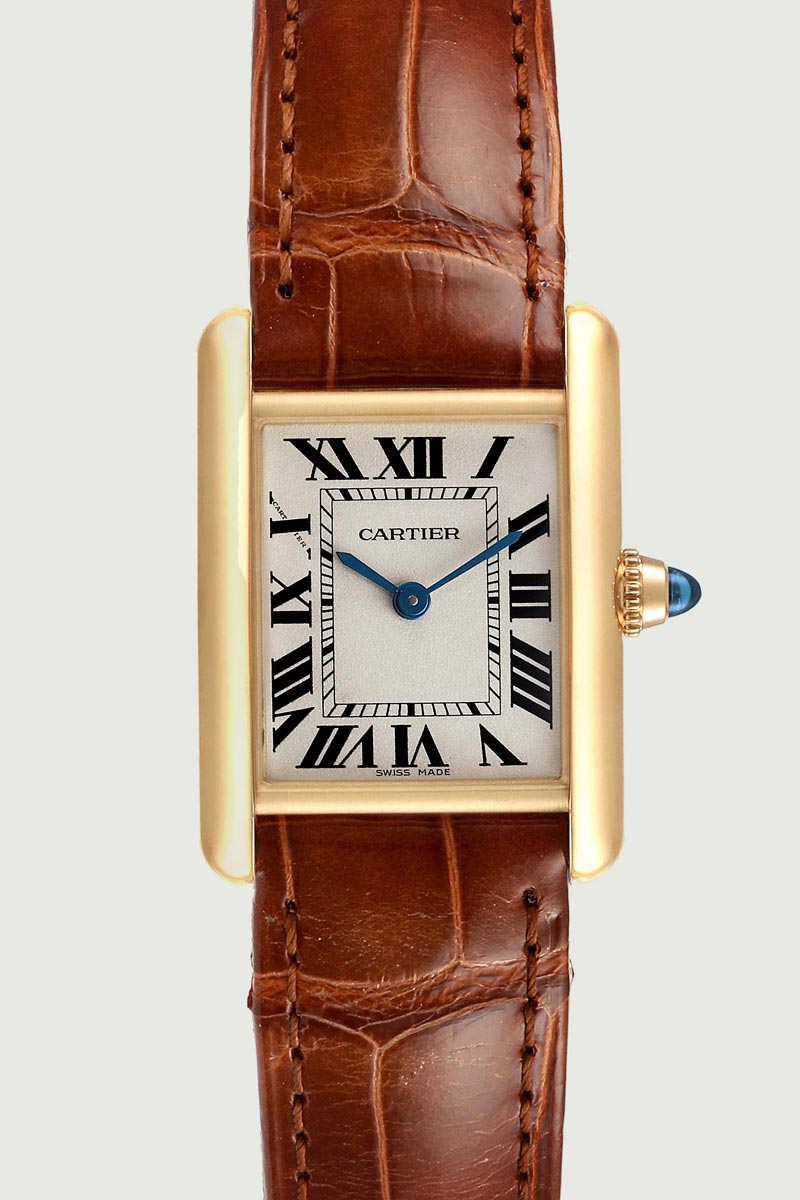
Tank Louis Cartier
- Number of models: 14
- Materials and gemstones: Precious metals, diamonds
- Measurement(s): Small (29.5mm x 22mm), Large (33.7mm x 25.5mm), Extra-Large (40.4mm x 34.9mm)
- Movement(s): Manual-wind, quartz
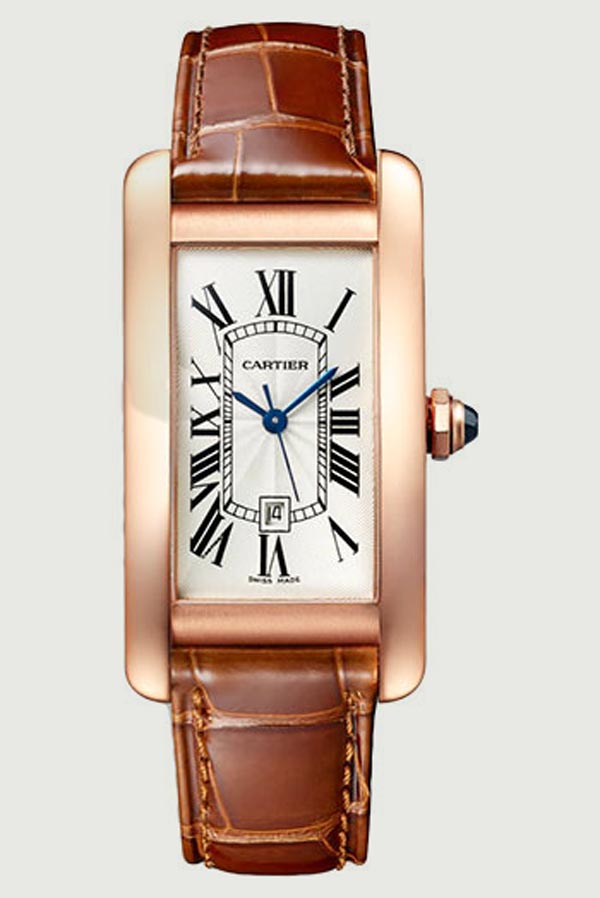
Tank Americaine
- Number of models: 25
- Materials and gemstones: Stainless steel, diamonds
- Measurement(s): Mini (27mm x 15.2mm), Small (34.8mm x 19mm), Medium (41.6mm x 22.6mm)
- Movement(s): Automatic and quartz
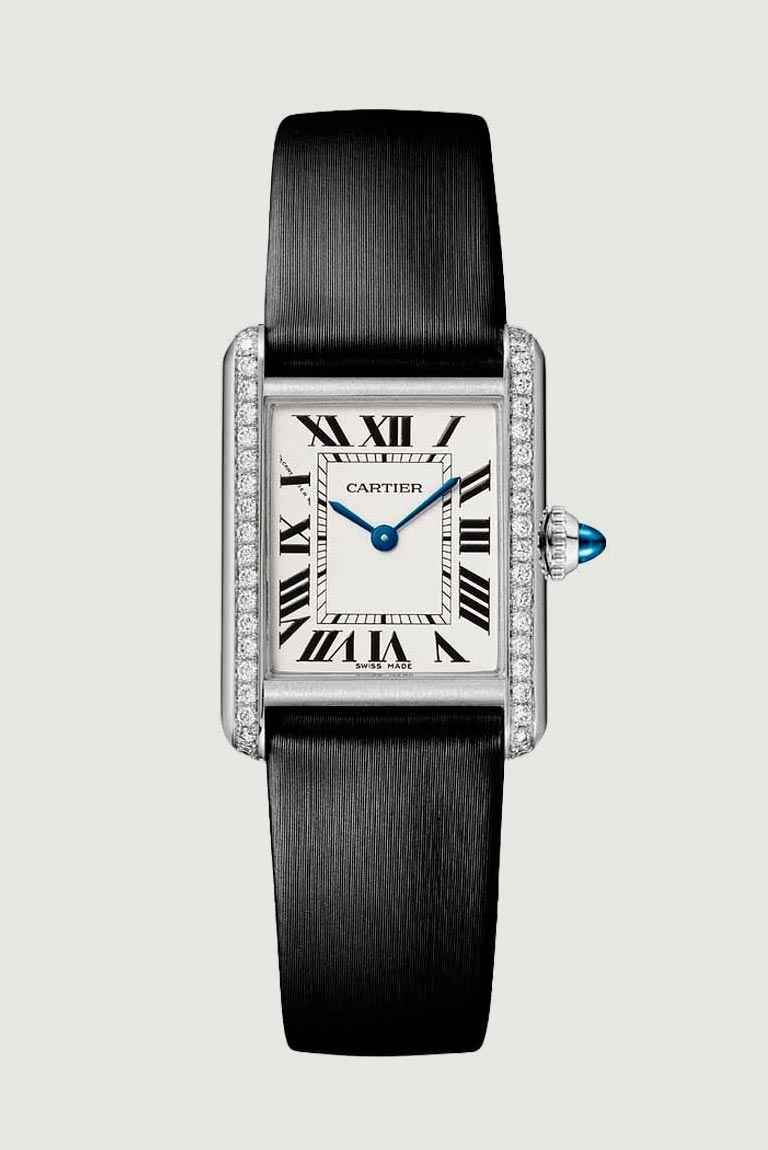
Tank Must
- Number of models: 6
- Materials and gemstones: Stainless steel, diamonds
- Measurement(s): Small (29.5mm x 22mm), Large (33.7mm x 25.5mm)
- Movement(s): Quartz
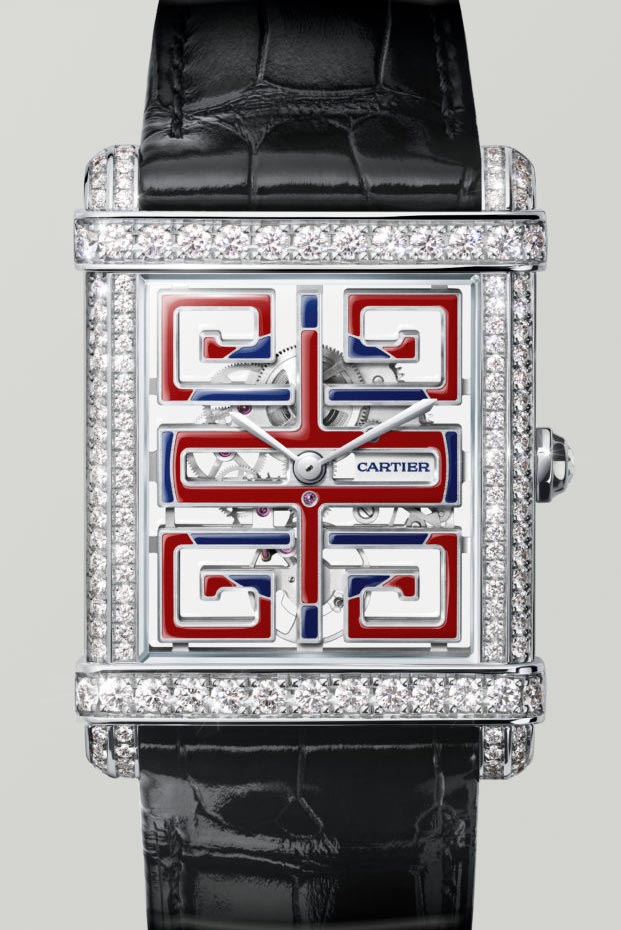
Tank Chinoise
- Number of models: 4
- Materials and gemstones: Yellow Gold, Rose Gold, Platinum
- Measurement(s): 39.49mm x 29.2mm
- Movement(s): Manual-wind
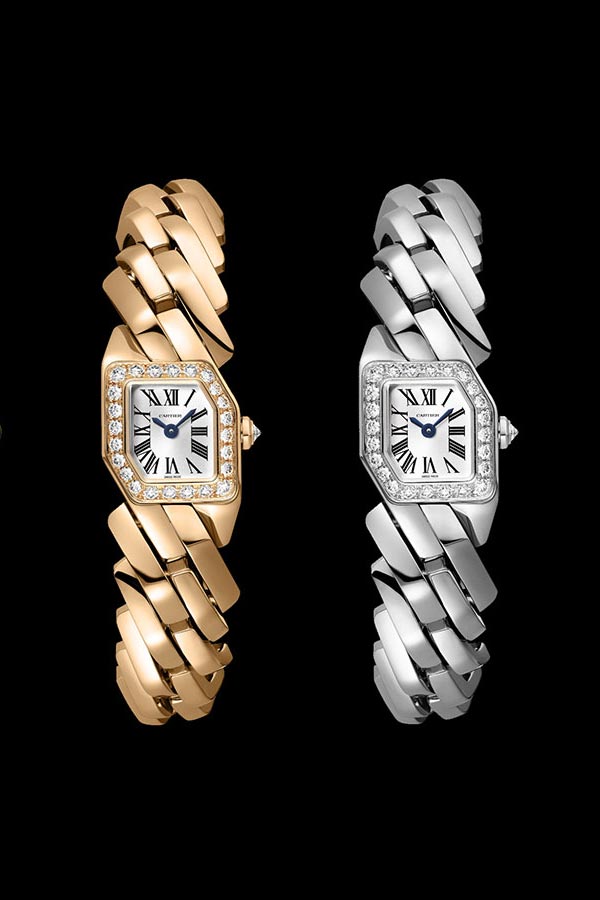
Maillon de Cartier
- Number of models: 3
- Materials and gemstones: White gold, rose gold, yellow gold, diamonds
- Measurement(s): 16mm x 17mm
- Movement(s): Quartz
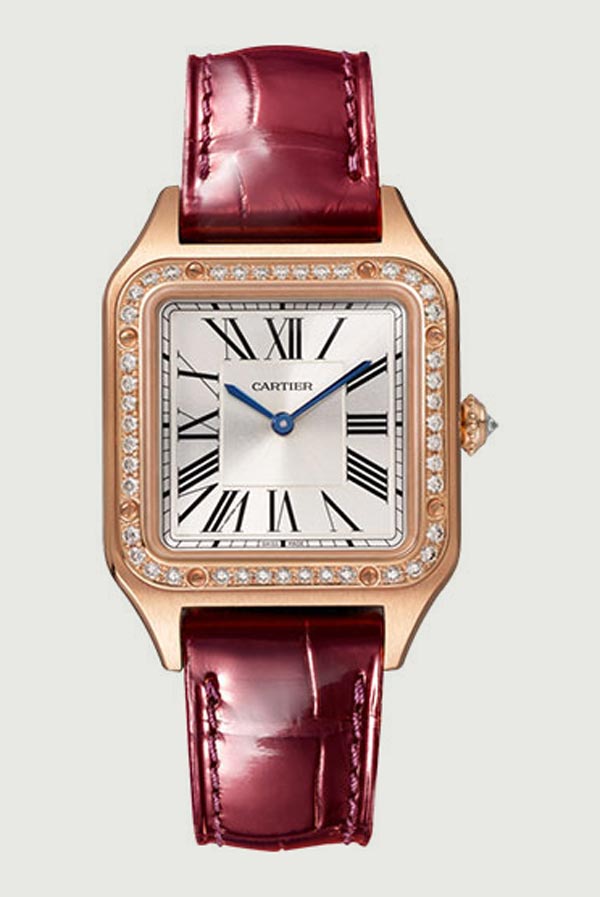
Santos de Cartier
- Number of models: 22
- Materials and gemstones:Stainless steel, yellow gold, rose gold, white gold, diamonds
- Measurement(s): Small (38mm x 27.5mm), Medium (35.1mm), Large (43.5mm x 31.4mm)
- Movement(s): Quartz, Automatic
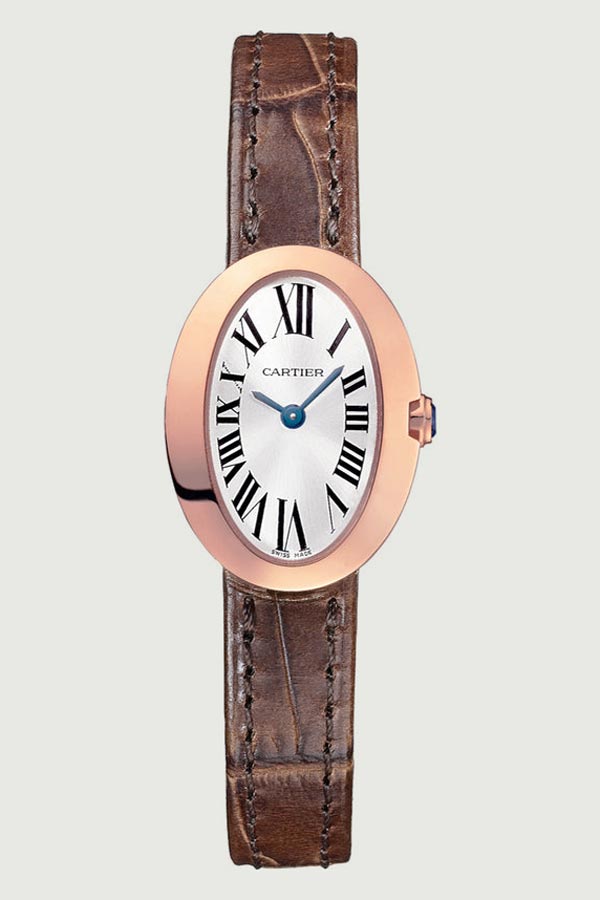
Baignoire
- Number of models: 24
- Materials and gemstones:White gold, rose gold, yellow gold, diamonds
- Measurement(s): Mini (25.3mm x 20.79mm), Small (31.6mm x 24.5mm), Medium (47mm x 21mm), Large (44mm x 34.07mm), XL (52mm x 23mm)
- Movement(s): Manual-wind, Quartz
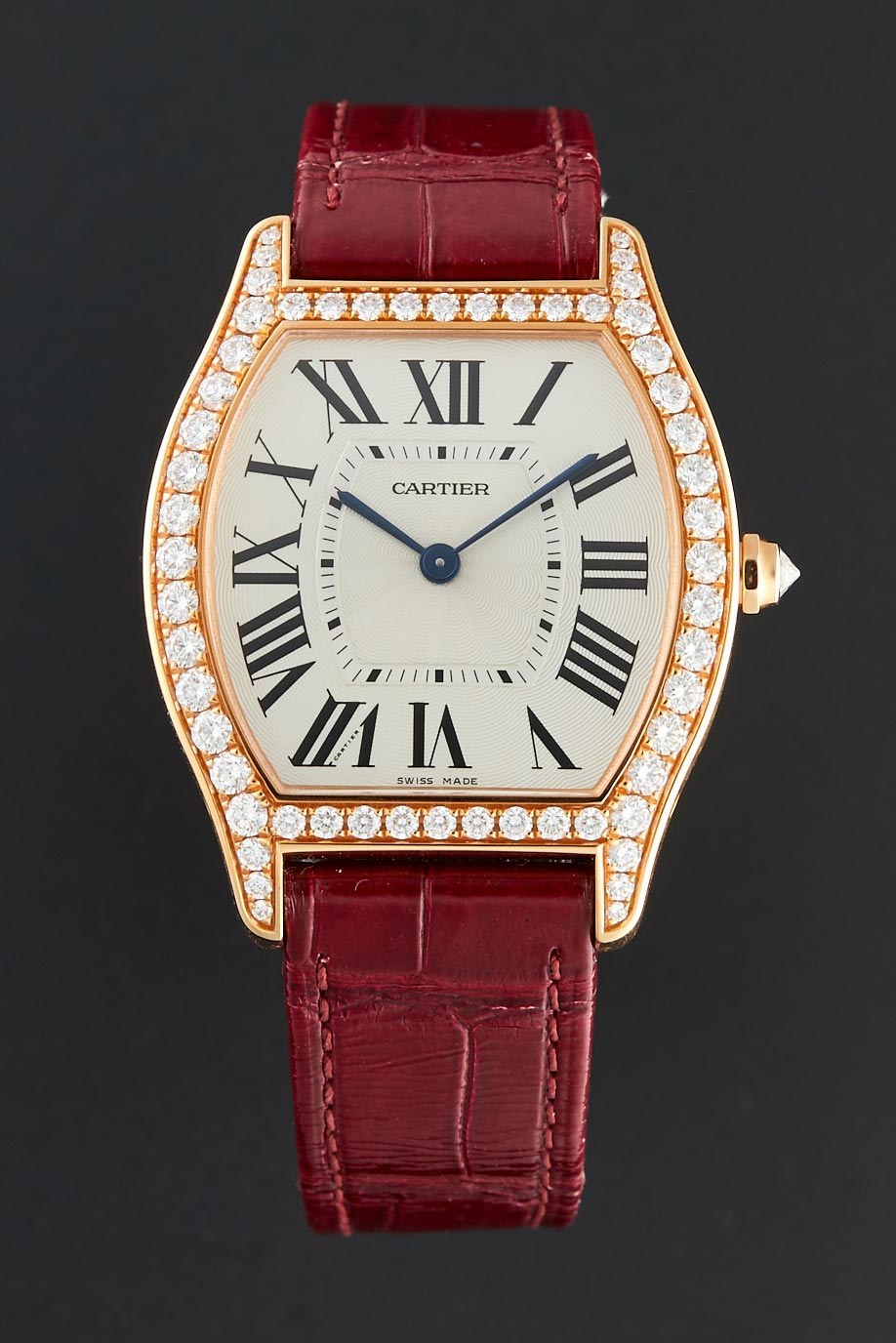
Tortue
- Number of models: 3
- Materials and gemstones: Rose gold, diamonds
- Measurement(s): Small (30mm x 24mm), Medium (39mm x 31mm)
- Movement(s): Manual-wind
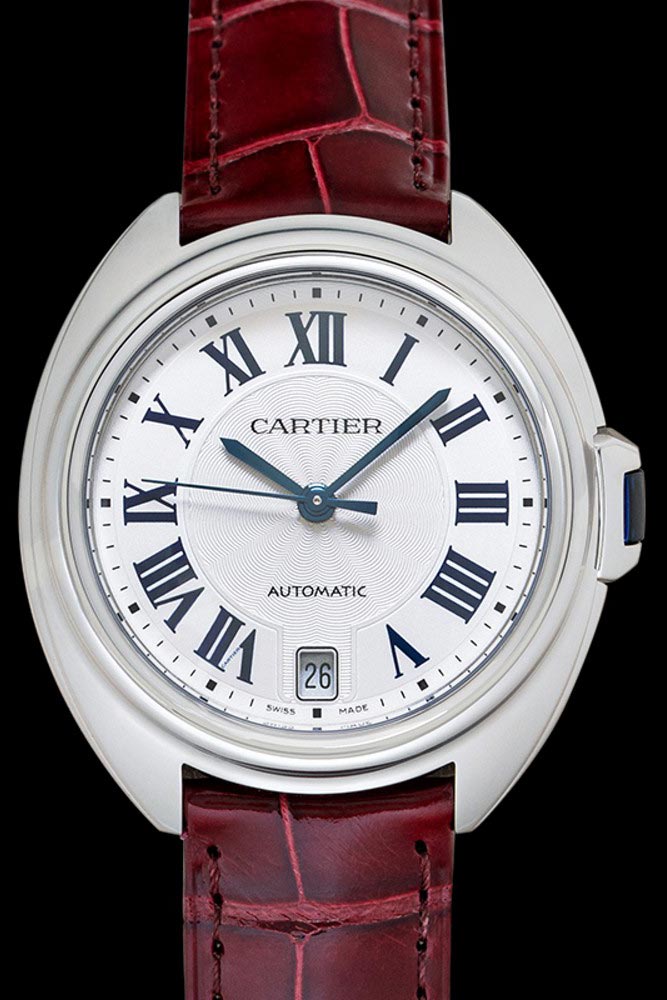
Cle de Cartier
- Number of models: 3
- Materials and gemstones: Stainless steel, diamonds
- Measurement(s): 31mm, 35mm
- Movement(s): Automatic
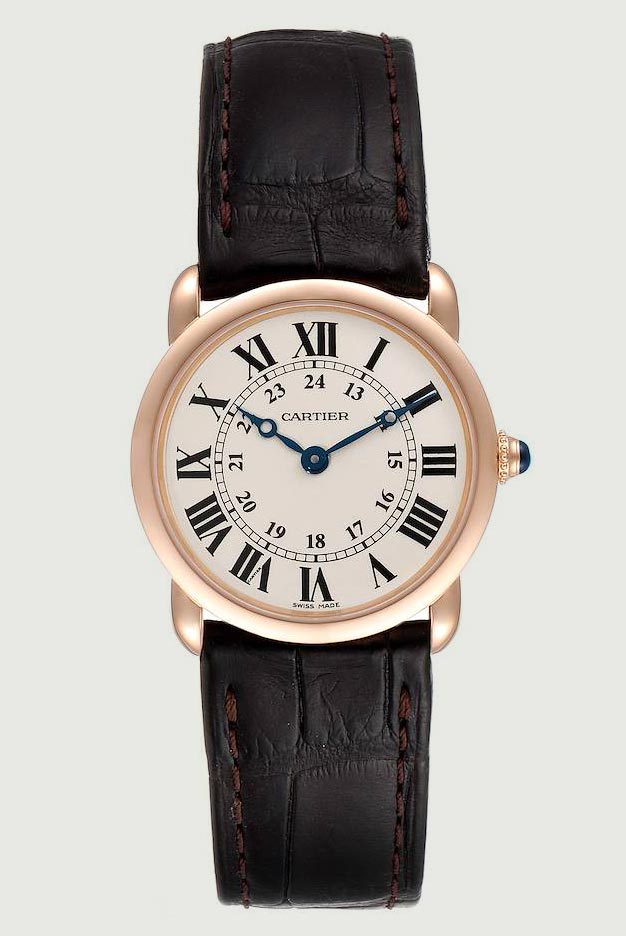
Ronde Louis Cartier
- Number of models: 9
- Materials and gemstones: White gold, rose gold, diamonds
- Measurement(s): 29mm, 36mm, 40mm, 42mm
- Movement(s): Automatic, hand-wound, quartz
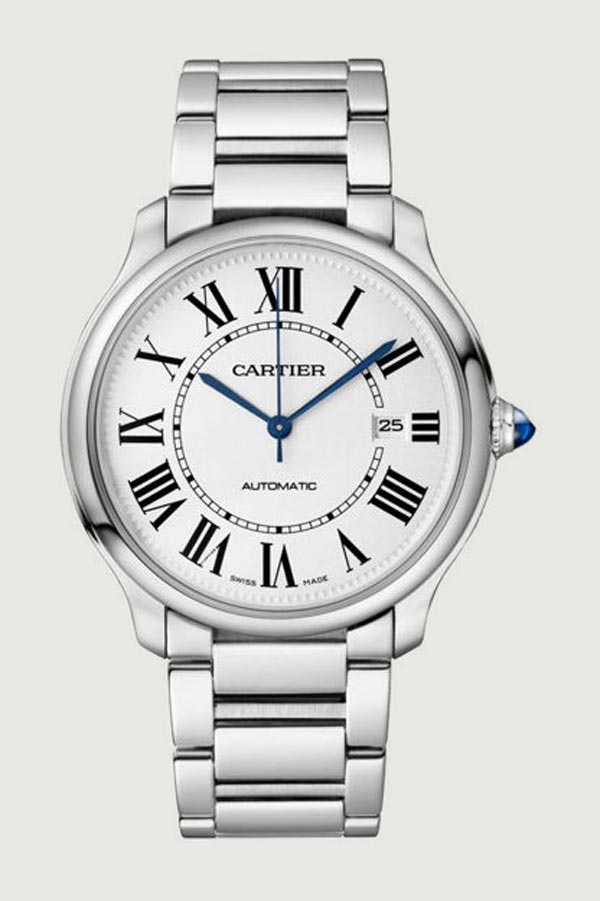
Ronde Must de Cartier
- Number of models: 6
- Materials and gemstones: Stainless steel
- Measurement(s): 29mm, 36mm, 40mm
- Movement(s): Automatic, quartz
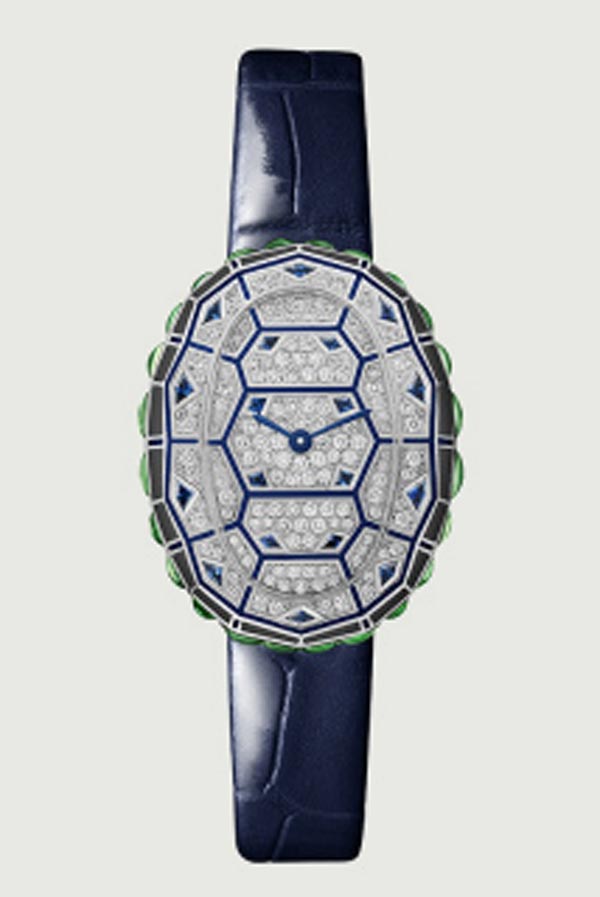
Cartier Libre
- Number of models: 9
- Materials and gemstones: Rose gold, white gold, diamonds, sapphires, coral, mother of pearl, moonstones, spinels
- Movement(s): Manual-wind, quartz
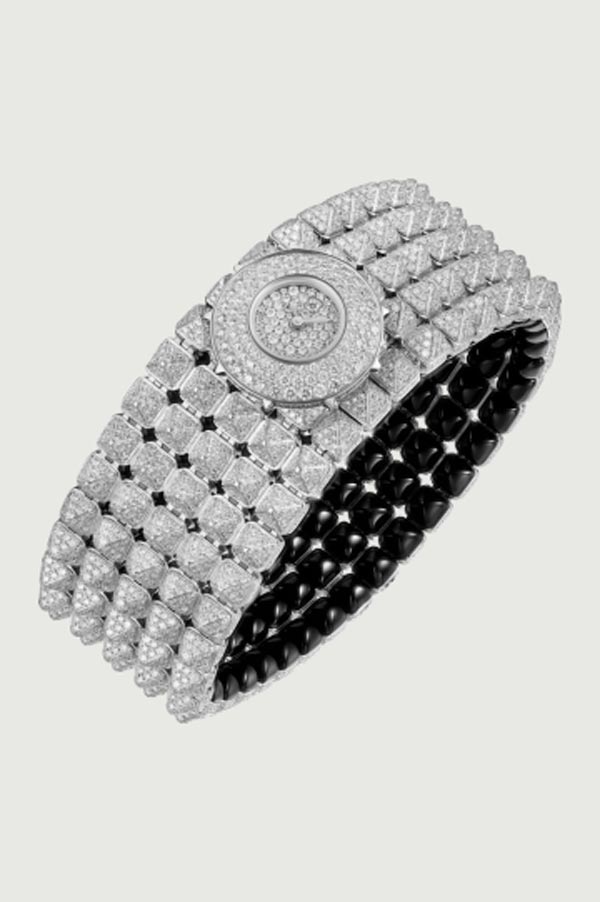
Clash (Un)Limited
- Number of models: 2
- Materials and gemstones: Rose gold, white gold, diamonds
- Movement(s): Quartz
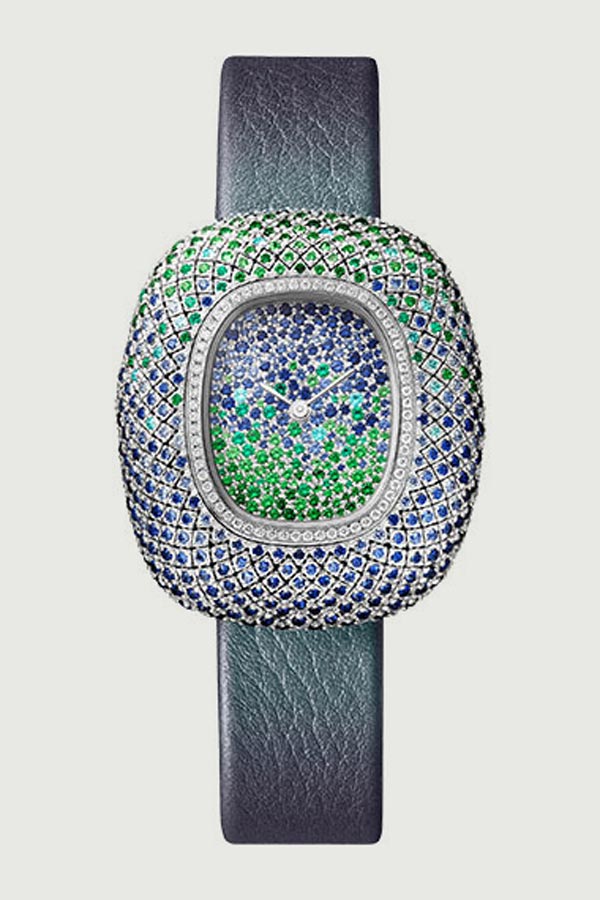
Coussin de Cartier
- Number of models: 9
- Materials and gemstones: Rose gold, yellow gold, white gold, diamonds, sapphires, emeralds, tourmalines, spinels
- Measurement(s): Small (27.1mm x 27.7mm), Medium (39.3mm x 32mm)
- Movement(s): Quartz
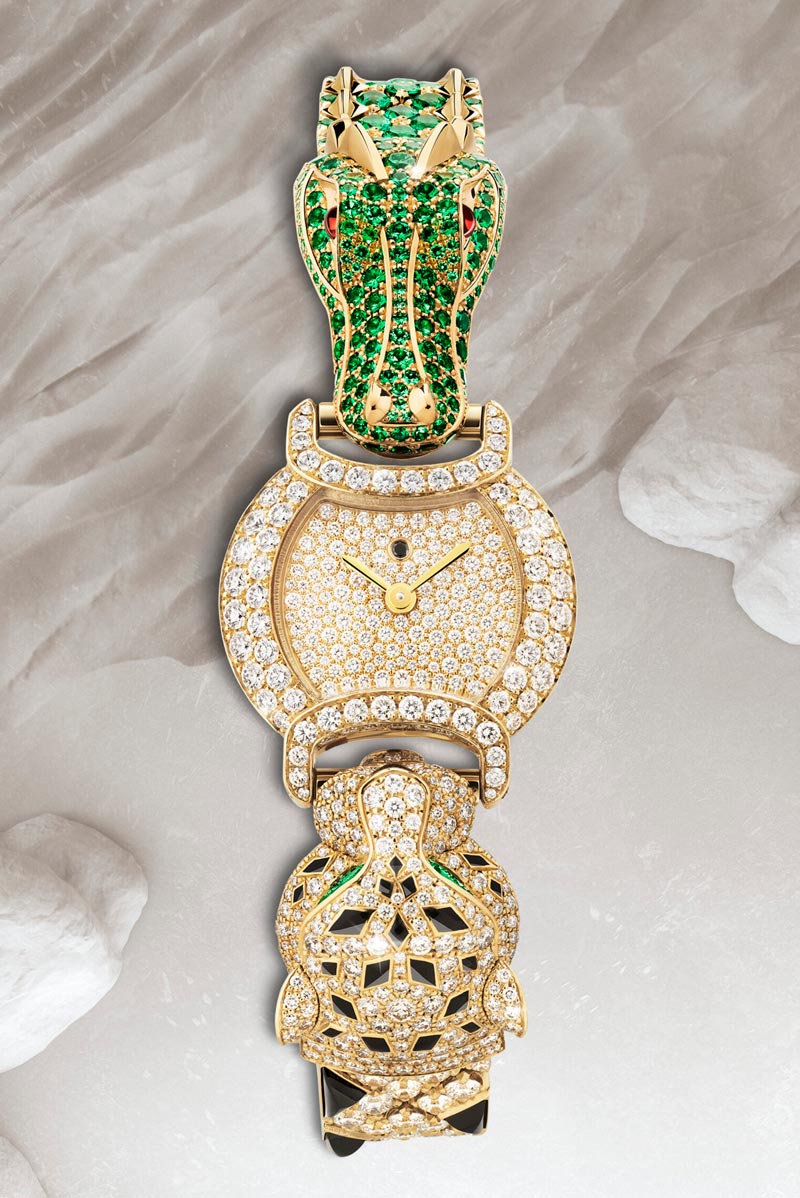
Fine Jewelry Watches
- Number of models: 4
- Materials and gemstones: White gold, diamonds
- Movement(s): Quartz
WATCHES FOR MEN
There are 10 men's collections with more than 150 variations.
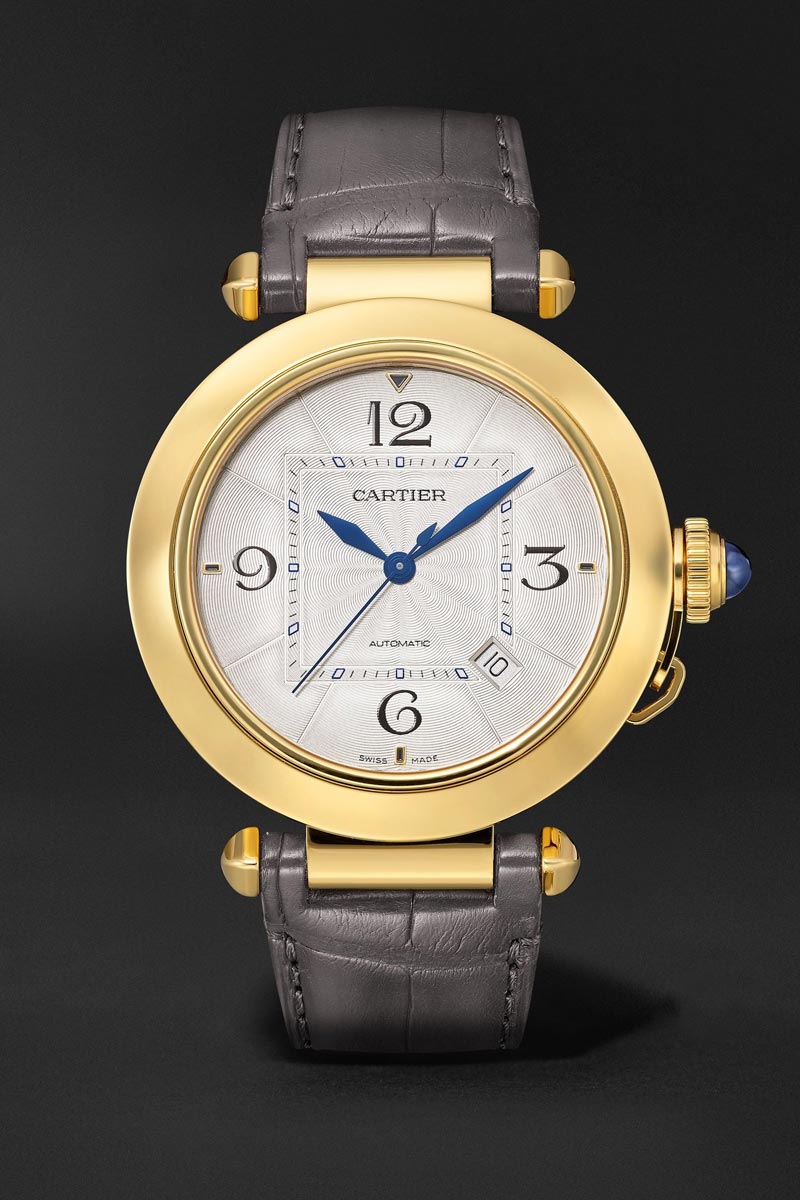
Pasha de Cartier
- Number of models: 22
- Materials and gemstones: Stainless steel, white gold, yellow gold, rose gold, diamonds
- Measurement(s): 38mm, 41mm, 42mm
- Movement(s): Automatic, manual-wind
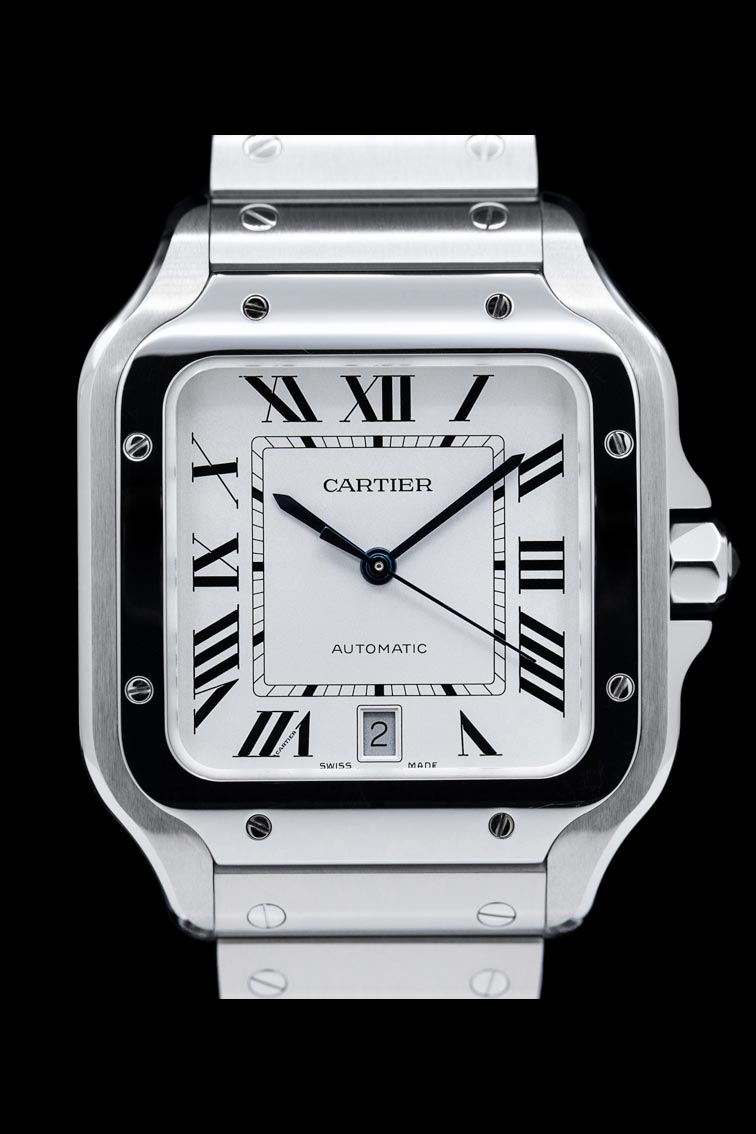
Santos de Cartier/Santos Dumont
- Number of models: 43
- Materials and gemstones: Stainless steel, yellow gold, white gold, rose gold, diamonds
- Measurement(s): Small (38mm x 27.5mm), Medium (35.1mm), Large (39.8mm), XL (43.3mm)
- Movement(s): Automatic, manual-wind, quartz
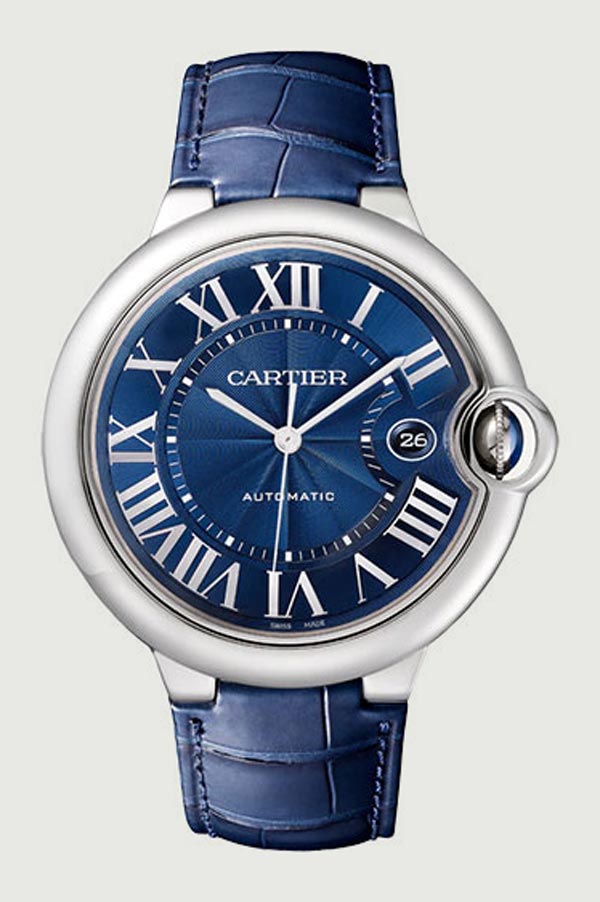
Ballon Bleu de Cartier
- Number of models: 35
- Materials and gemstones: Stainless steel, yellow gold, rose gold, white gold, diamonds
- Measurement(s): 36mm, 37mm, 40mm, 42mm
- Movement(s): Automatic, manual-wind
Tank: 7 Variants
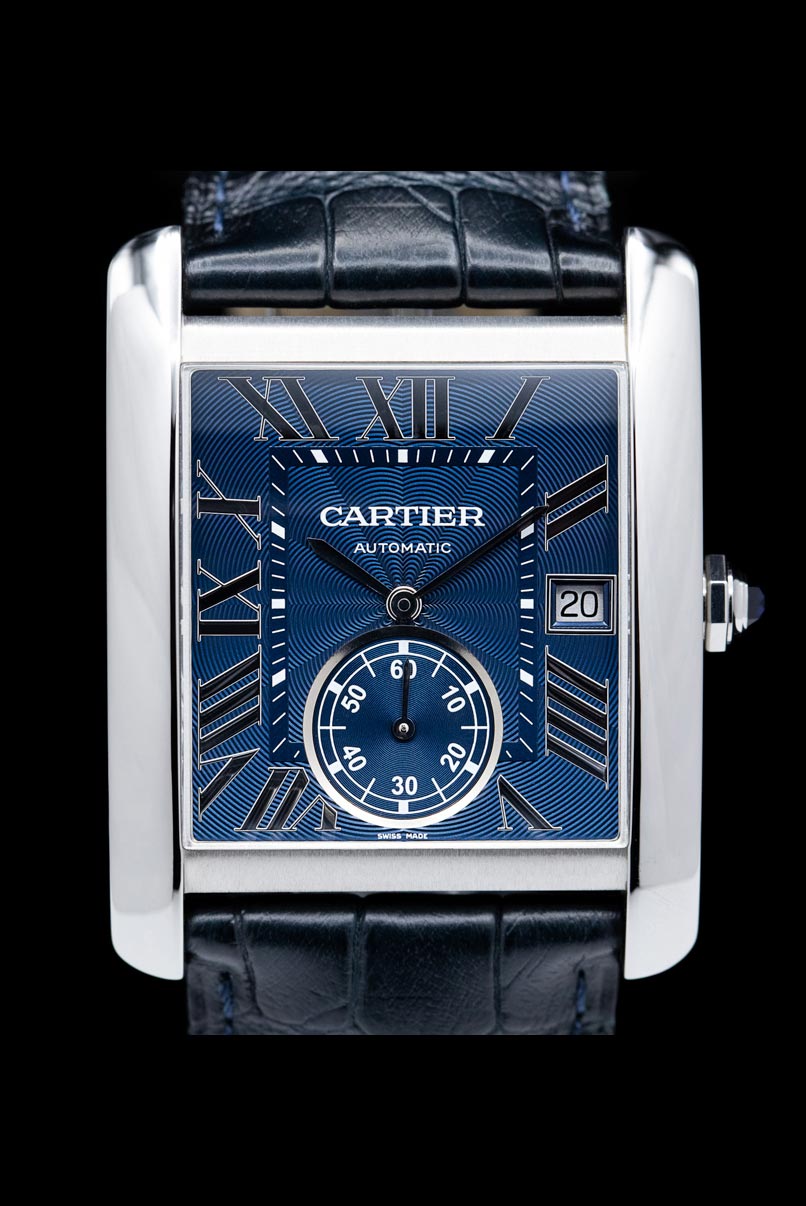
Tank MC
- Number of models: 2
- Materials and gemstones: Stainless steel, rose gold
- Measurement(s): 44mm
- Movement(s): Automatic
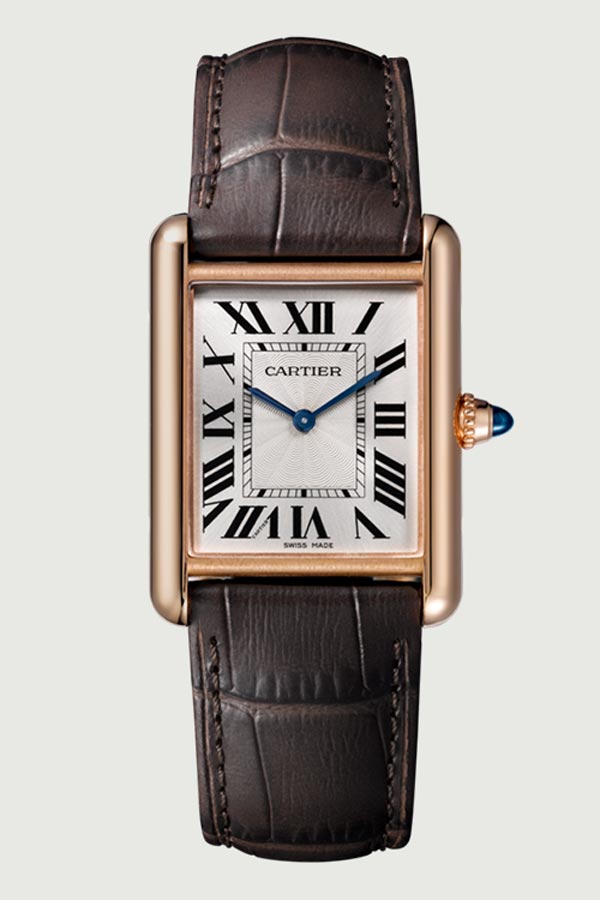
Tank Louis Cartier
- Number of models: 3
- Materials and gemstones: Rose gold, yellow gold
- Measurement(s): Large (33.7mm x 25.5mm)
- Movement(s): Manual-wind, quartz
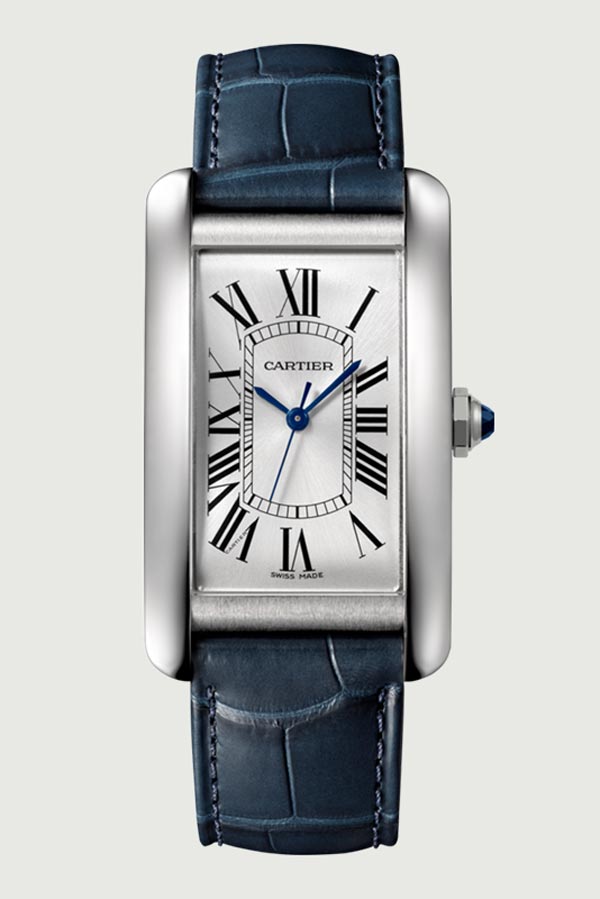
Tank Americaine
- Number of models: 8
- Materials and gemstones: Steel, rose gold, yellow gold
- Measurement(s): Large (33.7mm x 25.5mm)
- Movement(s): Manual-wind, quartz
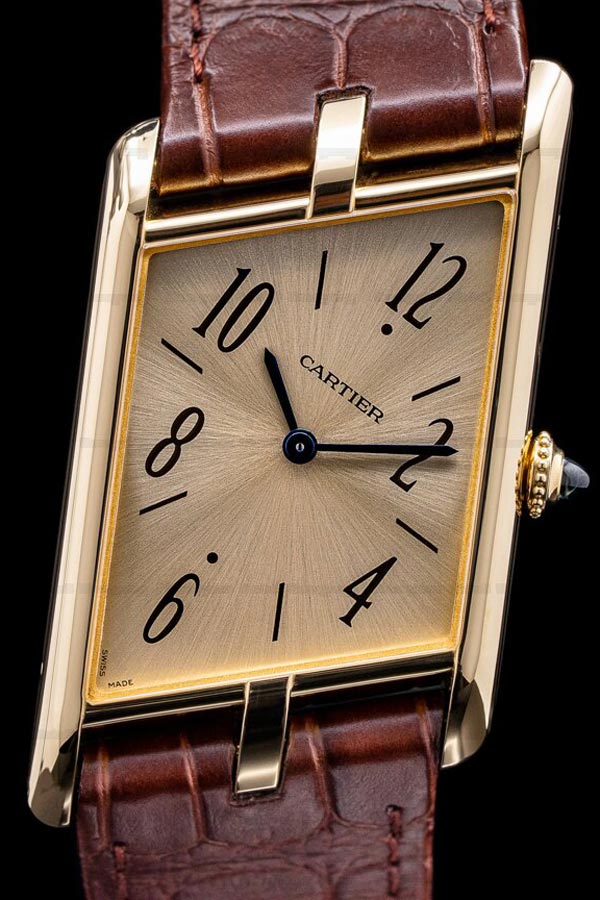
Tank Asymetrique
- Number of models: 3
- Materials and gemstones: Platinum, rose gold, yellow gold
- Measurement(s): Large (47.15mm x 26.1mm)
- Movement(s): Manual-wind
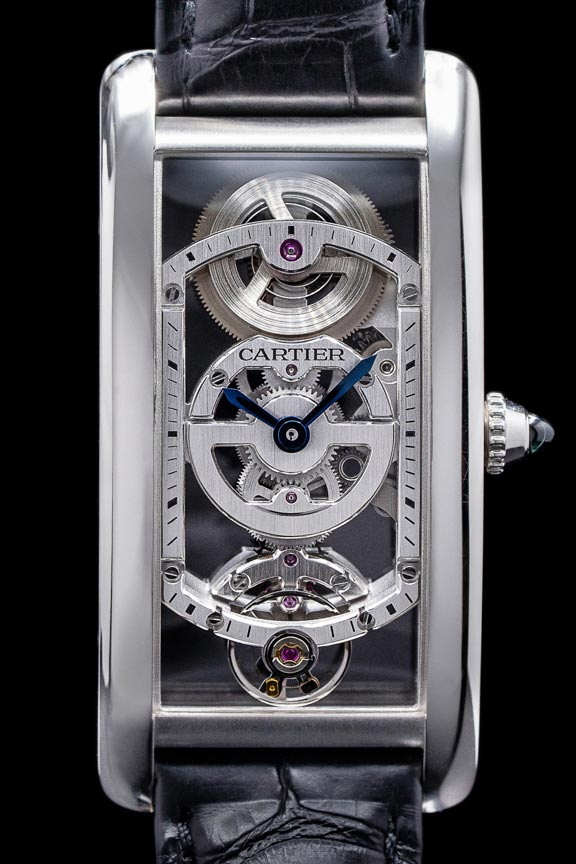
Tank Cintree
- Number of models: 4
- Materials and gemstones: Platinum, rose gold, yellow gold
- Measurement(s): Large (46.3mm x 23mm)
- Movement(s): Manual-wind
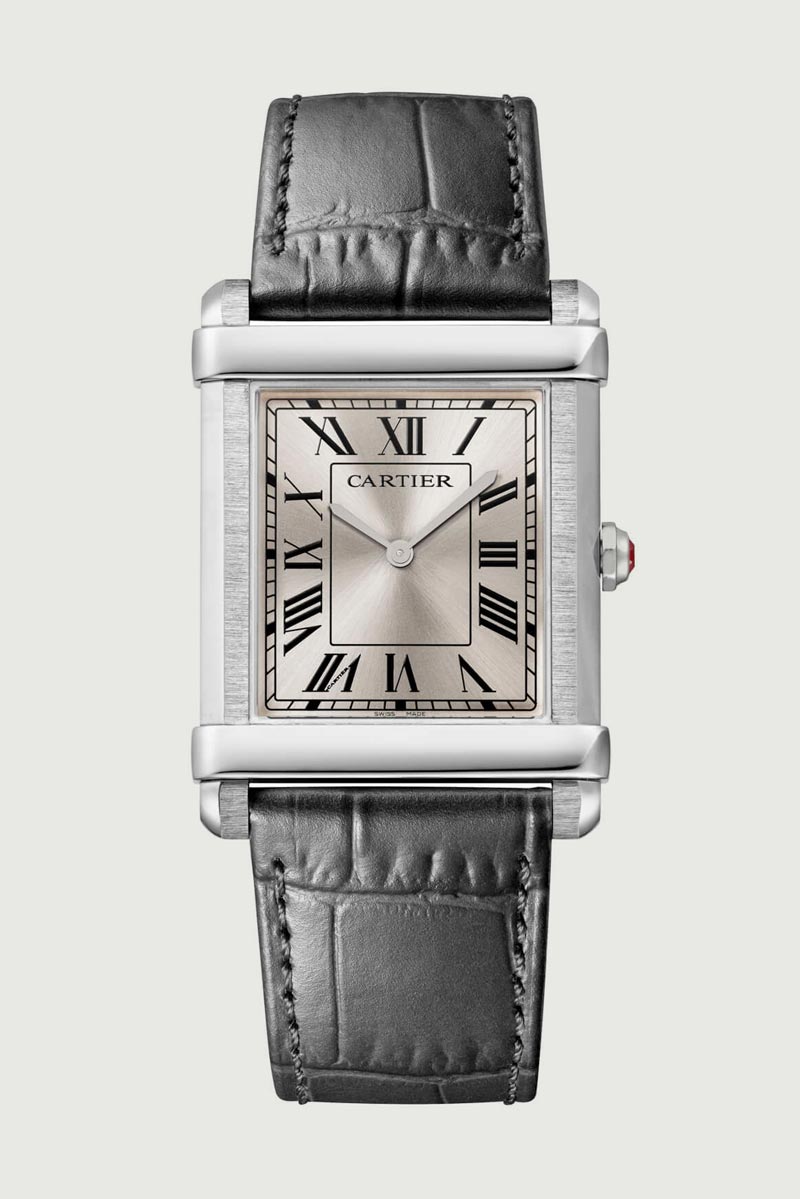
Tank Chinoise
- Number of models: 4
- Materials and gemstones: Platinum, rose gold, yellow gold
- Measurement(s): Large (39.49mm x 29.2mm)
- Movement(s): Manual-wind
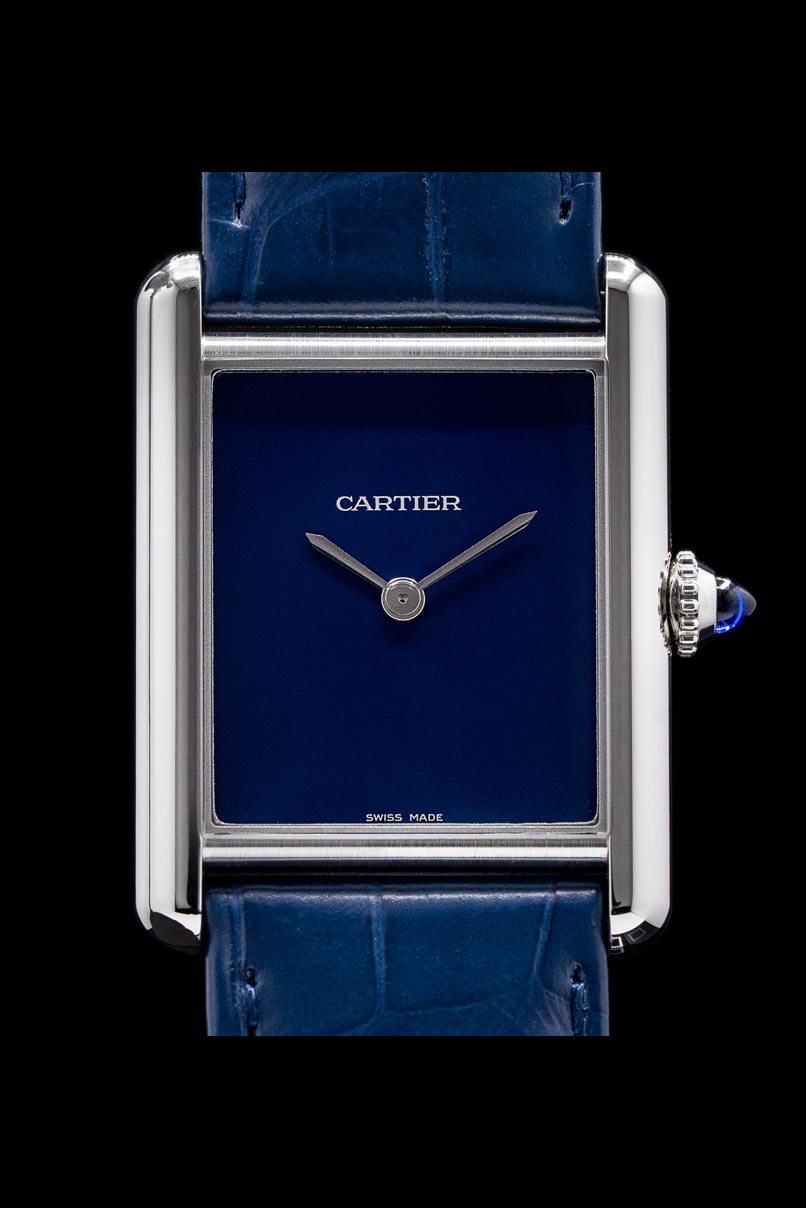
Tank Must
- Number of models: 4
- Materials and gemstones: Stainless steel
- Measurement(s): Large (33.7mm x 25.5mm), XL (41mm x 31mm)
- Movement(s): Automatic, quartz
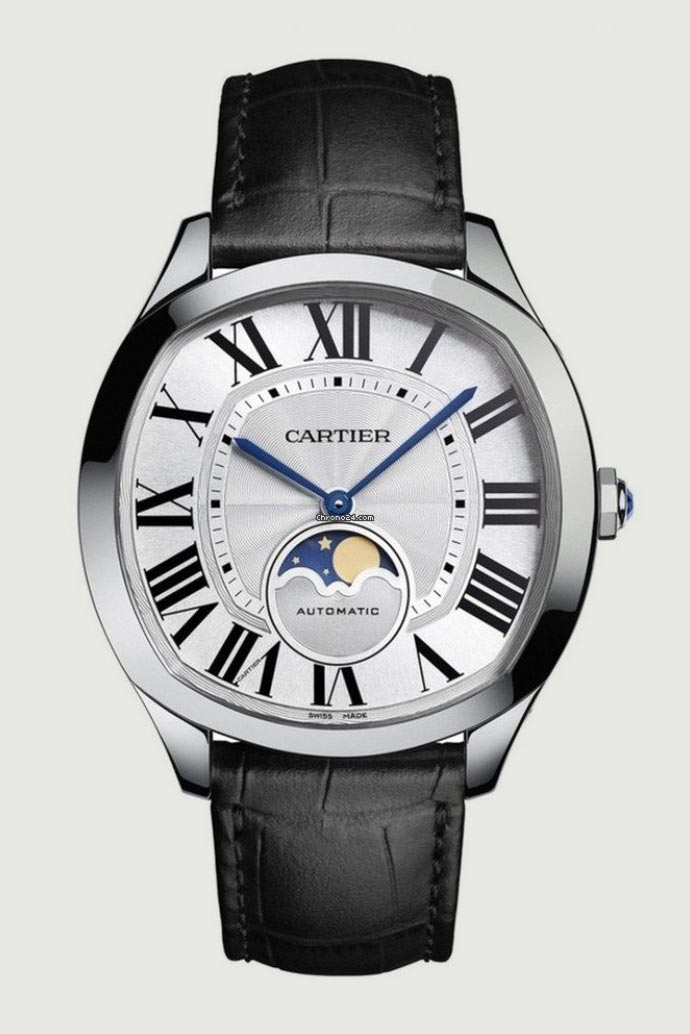
Drive de Cartier
- Number of models: 1
- Materials and gemstones: Rose gold
- Measurement(s): Large
- Movement(s): Manual-wind tourbillon
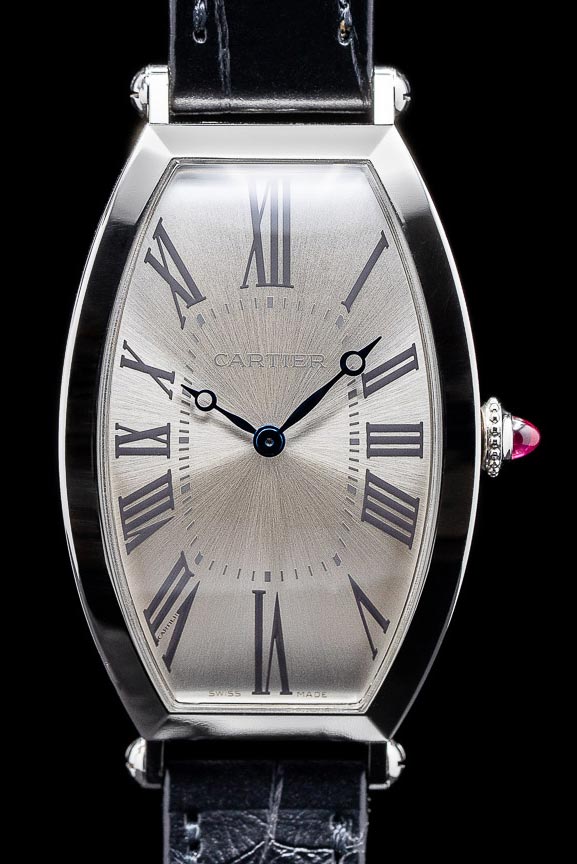
Tonneau
- Number of models: 2
- Materials and gemstones: Platinum, rose gold
- Measurement(s): Large (46.3mm x 23mm)
- Movement(s): Manual-wind
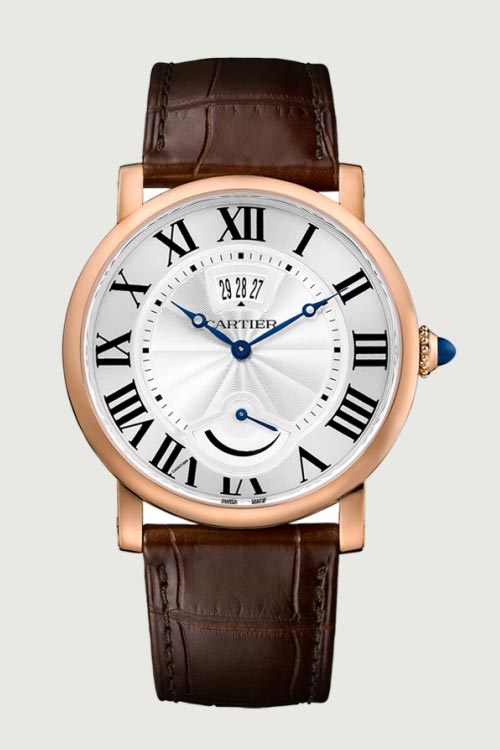
Rotonde de Cartier
- Number of models: 7
- Materials and gemstones: Platinum, rose gold, titanium, palladium
- Measurement(s): 42mm, 43.5mm, 45mm
- Movement(s): Automatic, manual-wind
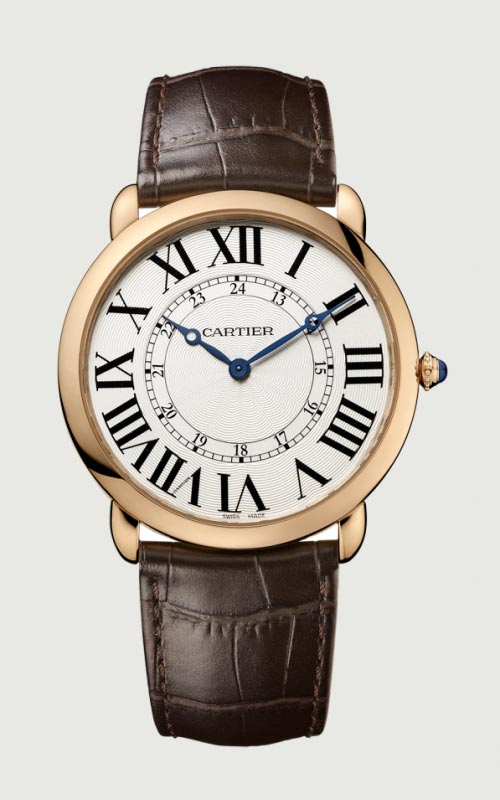
Ronde Louis Cartier
- Number of models: 8
- Materials and gemstones: Rose gold, white gold, diamonds
- Measurement(s): 36mm, 40mm, 42mm
- Movement(s): Automatic, manual-wind
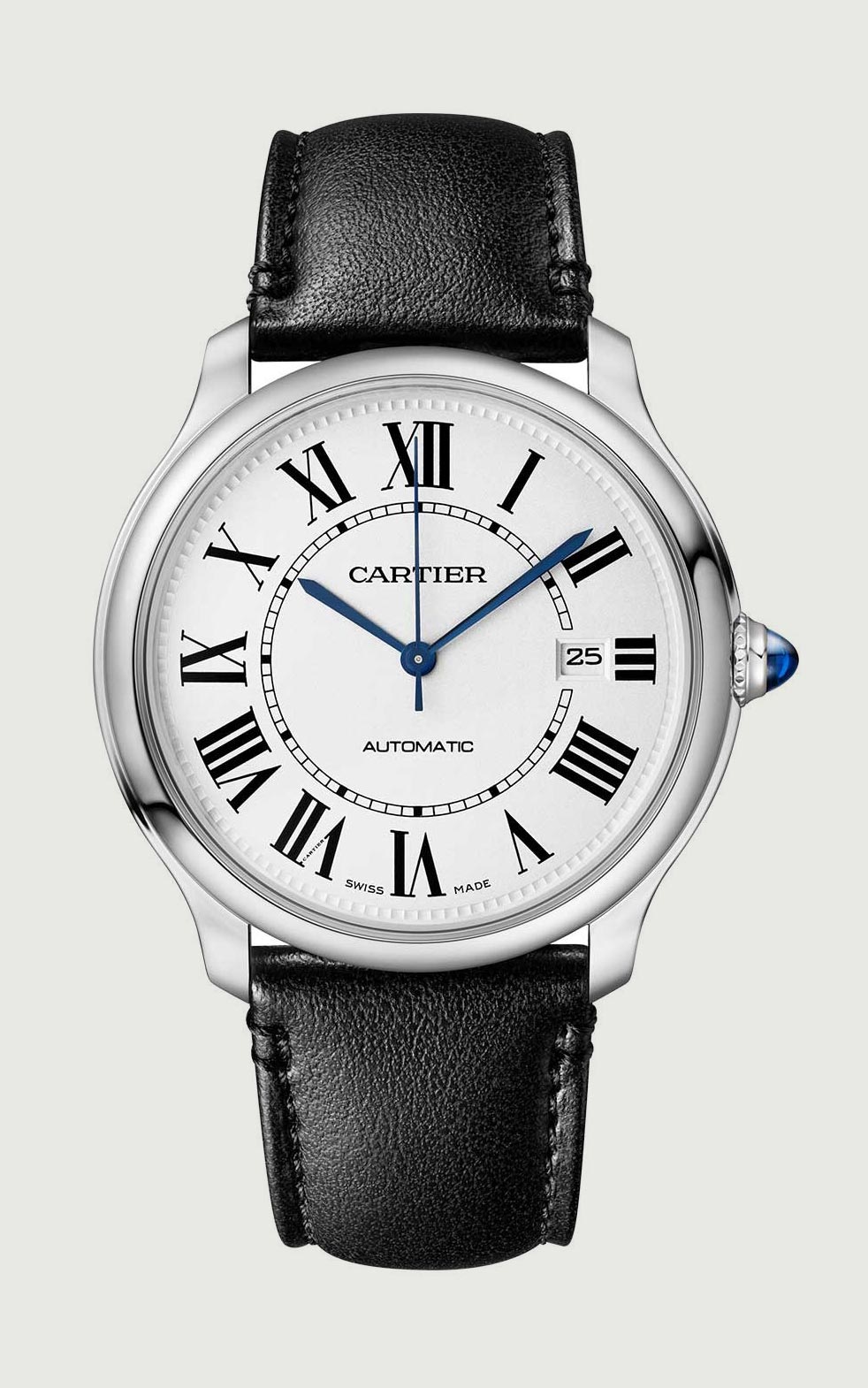
Ronde Must de Cartier
- Number of models: 6
- Materials and gemstones: Stainless steel
- Measurement(s): 29mm, 36mm, 40mm
- Movement(s): Automatic, quartz
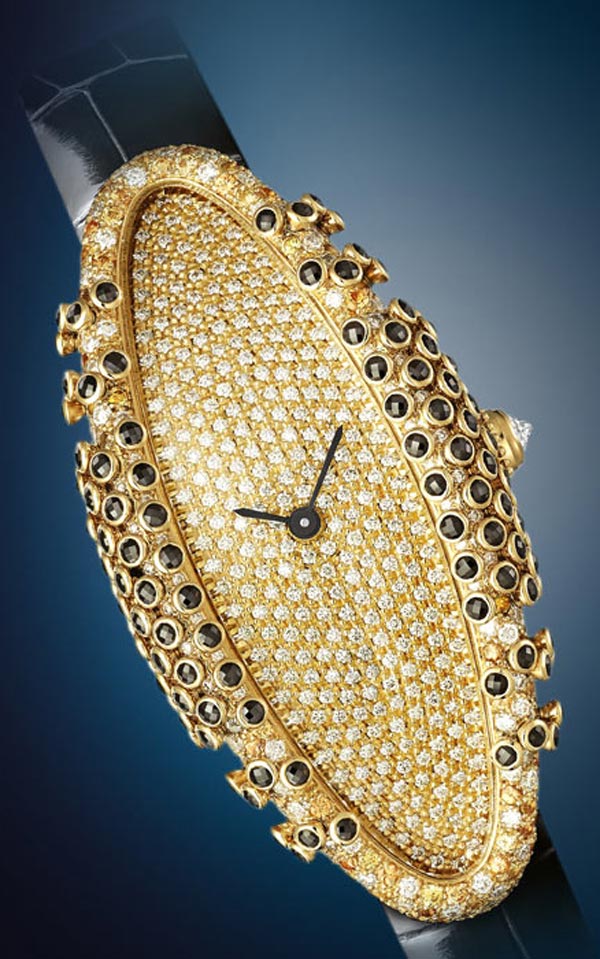
Cartier Libre
- Number of models: 1
- Materials and gemstones: Yellowgold, diamonds, sapphires, spinels
- Measurement(s): Medium (47mm x 21mm)
- Movement(s): Manual-wind